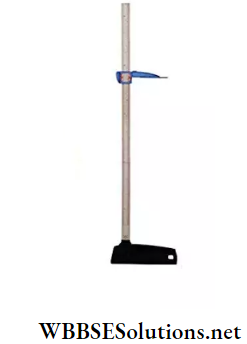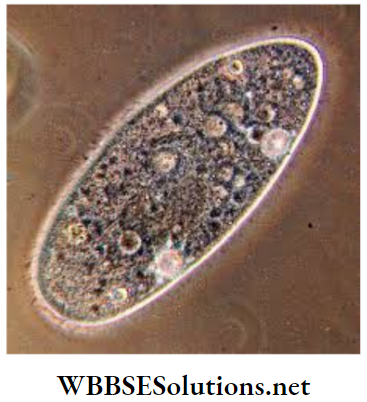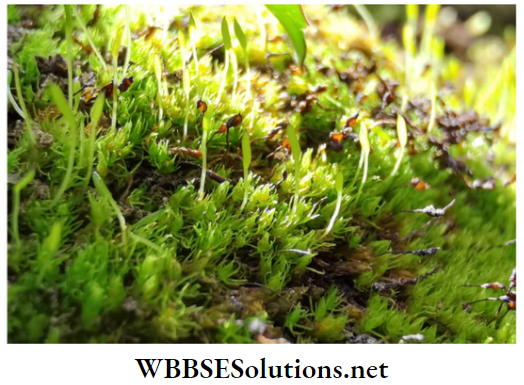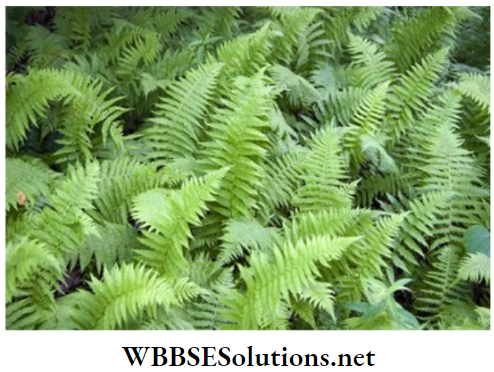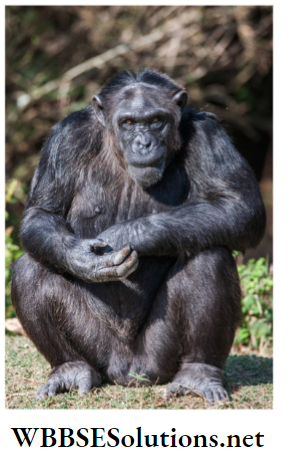- Chapter 1 Interdependence Of Organisms And Environment
- Chapter 2 Phenomena Around Us
- Chapter 3 Element Compound And Mixture
- Chapter 4 Rocks And Minerals
- Chapter 5 Measurement
- Chapter 6 Primary Concept Of Force And Energy
- Chapter 7 Statics And Dynamics Of Fluid
- Chapter 8 The Human Body
- Chapter 9 Common Machines
- Chapter 10 Biodiversity And Its Classification
- Chapter 11 Habits And Habitats Of Some Important Animals
- Chapter 12 Waste Products
Class 6 Science
WBBSE Notes For Class 6 School Science
- WBBSE Notes For Class 6 School Science Chapter 1 Interdependence Of Organisms And Environment
- WBBSE Notes For Class 6 School Science Chapter 2 Phenomena Around Us
- WBBSE Notes For Class 6 School Science Chapter 3 Element Compound And Mixture
- WBBSE Notes For Class 6 School Science Chapter 4 Rocks And Minerals
- WBBSE Notes For Class 6 School Science Chapter 5 Measurement
- WBBSE Notes For Class 6 School Science Chapter 6 Primary Concept Of Force And Energy
- WBBSE Notes For Class 6 School Science Chapter 7 Statics And Dynamics Of Fluid
- WBBSE Notes For Class 6 School Science Chapter 8 The Human Body
- WBBSE Notes For Class 6 School Science Chapter 9 Common Machines
- WBBSE Notes For Class 6 School Science Chapter 10 Biodiversity And Its Classification
- WBBSE Notes For Class 6 School Science Chapter 11 Habits And Habitats Of Some Important Animals
- WBBSE Notes For Class 6 School Science Chapter 12 Waste Products
WBBSE Notes For Class 6 School Science Chapter 12 Waste Products
Chapter 12 Waste Products Introductions
The throwaway products that are generated due to our day-to-day activity and are not required for any other activity are called waste products.
Examples: Plastic or glass bottles, cans, plastic/jute/paper carry bags, banana peels,
Classification Of Waste Products
The waste products may be classified on the basis of their
- Source,
- Chemical nature,
- Physical properties,
- Degradational ability etc.
Read And Learn More: WBBSE Notes For Class 6 School Science
Chapter 12 Waste Products On the Basis of the Source
On the basis of source, waste materials can be classified into 7 different types as detailed below:
1. Municipal waste:
This includes trash or garbage from households, schools, offices, marketplaces, restaurants and other public places.
They include everyday items like food debris, used plastic bags, soda & soft drink cans and plastic water bottles, broken furniture, grass clippings, product packaging, broken home appliances and clothing.
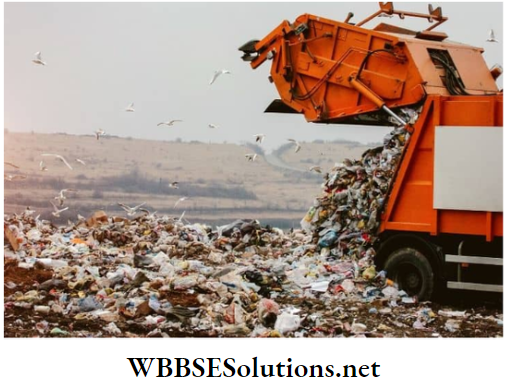
2. Medical/Clinical waste:
Medical/clinical waste normally refers to waste produced by healthcare facilities, such as hospitals, clinics, surgical theatres, veterinary hospitals and laboratories.
They tend to be classified as hazardous waste rather than general waste. Items in this group include surgical items, pharmaceuticals, blood, body parts, wound dressing materials, needles and syringes.
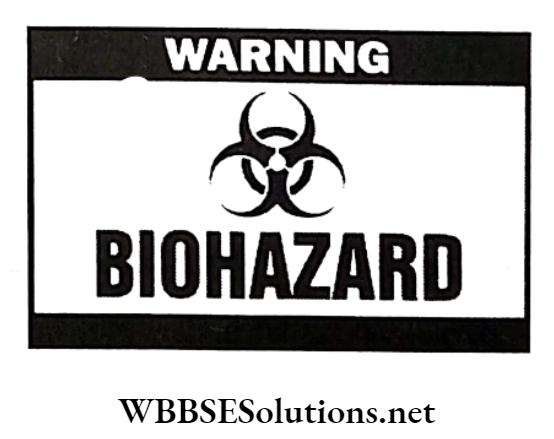
3. Agricultural waste:
Typically, this is waste generated by agricultural activities. These vegetable peels, old blades, rotten food items, old electronic items etc.
These include horticulture, fruit growing, seed growing, livestock breeding, markets, gardens and seedling nurseries.
Waste items in this group include empty pesticide containers, old silage wrap, out-of-date medicines and wormers, used tyres, surplus milk, cocoa pods and corn husks.
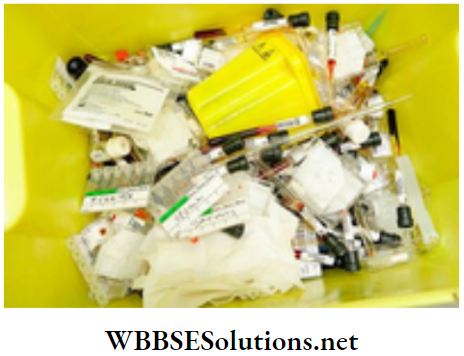
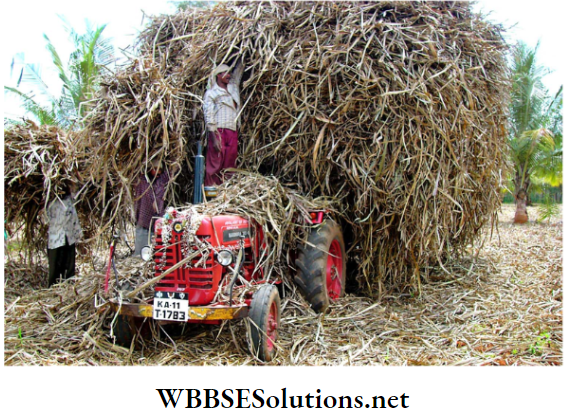
4. End-of-life Automobiles:
When cars stop working, where do they end up? Many people just leave them to rust in the fields, but there is a better way to deal with them.
In many cities, these vehicles are sent to the plant, where all the removable parts are taken out for recycling.
The rest is flattened up and shredded into pieces for recycling. The last bits that cannot be used again are sent to a landfill.
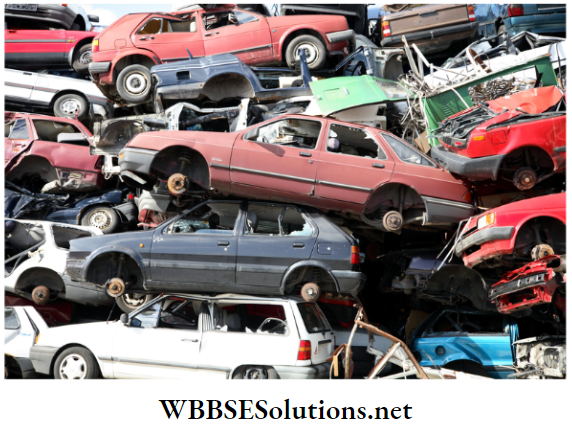
5. Industrial waste:
Since the industrial revolution, the rise in the number of industries manufacturing glass, leather, textile, food, electronics, plastic and metal products has significantly contributed to waste production.
Take a look at the things in your home, every item was manufactured and one day it will be of no use, and waste will be produced as a result.
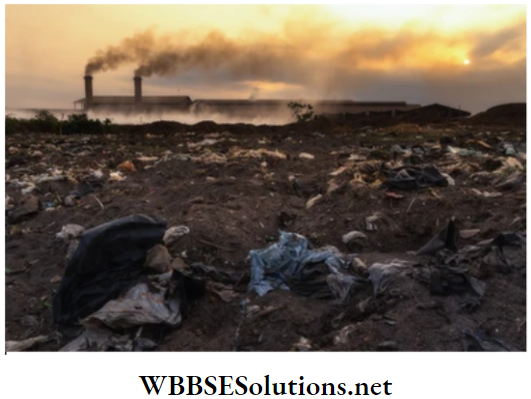
6. Construction/demolition waste:
Construction waste is that resulting from the construction of roads and buildings. Sometimes old buildings and structures are pulled down (demolished) to make space for new ones.
This is particularly common in old cities, that are undergoing modernization. This is called demolition waste.
Waste items include concrete debris, wood, earth, huge package boxes and plastics from the building materials etc.

7. Electronic or e-waste:
This is waste from electronic and electrical devices. Think of DVD and music players, TV, telephones, computers, vacuum cleaners and all the other electrical stuff in your home.
These are also called e-waste, e-scrap, or waste electrical and electronic equipment (WEEE). Some e-waste (like TV) contains lead, mercury, cadmium, and brominated flame retardants.
These are TIS harmful to humans and the environment. It is therefore important that the right authorities ensure the proper disposal of such waste.
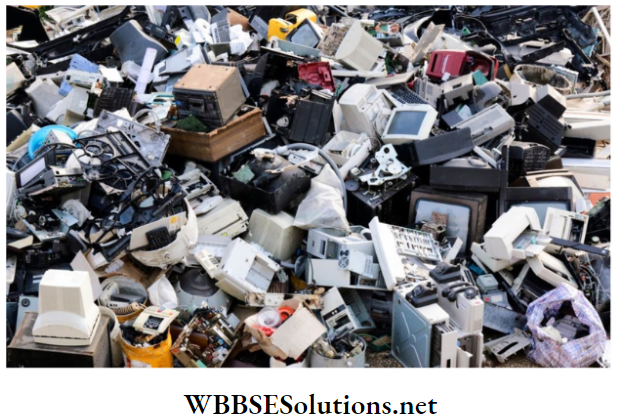
Chapter 12 Waste Products On the Basis of Chemical Nature
On this basis, waste materials can be classified as inorganic and organic.
1. Inorganic waste:
It includes the different inorganic salts and processed compounds that are produced as by-products in less industrial processes like salts of heavy metals including copper, iron, chromium, etc.
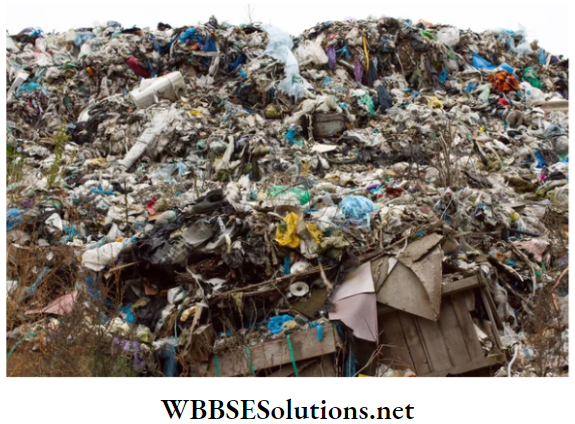
2. Organic waste:
These are complex organic compounds generated from rubber, nylon, elo paint, etc. Organic wastes also contain complex hydrocarbons.
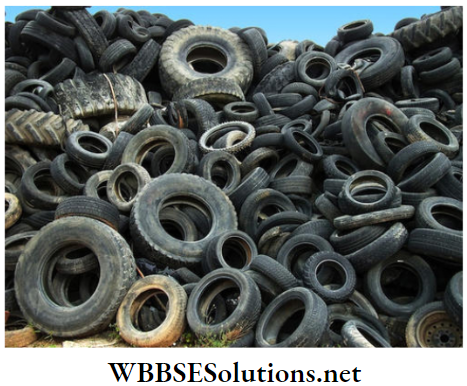
Chapter 12 Waste Products On the Basis of Physical Nature
On this basis, the waste material can be classified as solid waste, liquid waste and gaseous waste.
1. Solid waste:
Solid wastes include metallic and non-metallic waste including plastic, glass, and paper, which are disposed of in a landfill or maybe incinerated at high temperatures.
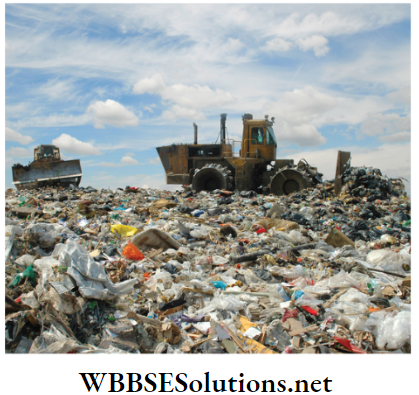
2. Liquid waste:
They include water-soluble compounds, or simply organic solvents. If these are added to a water body, it causes water pollution and reduces the oxygen level of the water body.
3. Gaseous wastes:
These are oxides of carbon, sulphur, nitrogen, several toxic hydrocarbons, aerosols, methane and green. house gases like CFC (chlorofluorocarbon).
These are largely emitted from factories, chemical plants, vehicles etc.
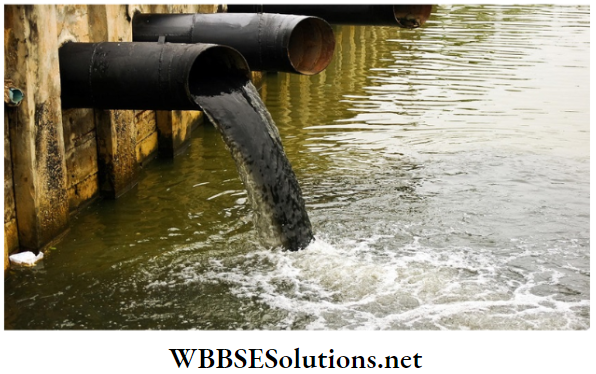
Chapter 12 Waste Products On the Basis of Degradational Ability
On this basis, the waste products can be classified as non-biodegradable and biodegradable.
1. Non-biodegradable waste:
This waste product cannot be recycled by the normal microbial degradational process, it includes plastic, heavy metals etc.
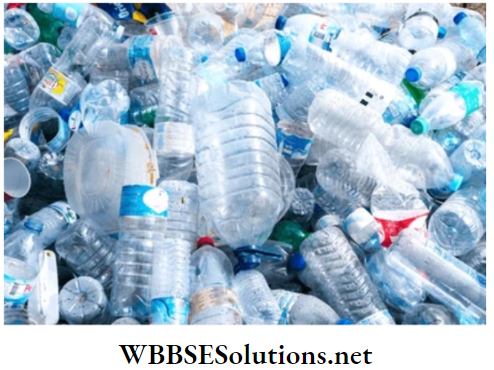
2. Biodegradable waste:
These materials. include household products which may be vegetables or cooked food materials that are easily degraded by microbes. It also includes agricultural waste.
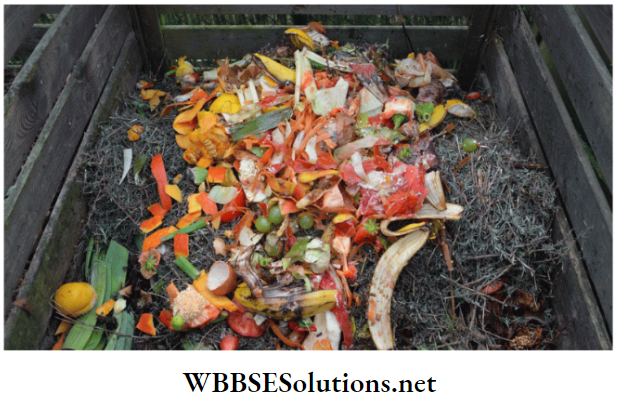
Chapter 12 Waste Products Waste Management
It is the collection, transport and disposal of garbage, sewage and other waste products.
Waste management encompasses the management of all processes and resources for proper handling of waste materials, maintenance of waste, and transportation by trucks and dumping facilities in compliance with health codes and environmental regulations.
The four principles (4R process) of waste reduction are Reduce, Reuse, Recycle, and Refuse.
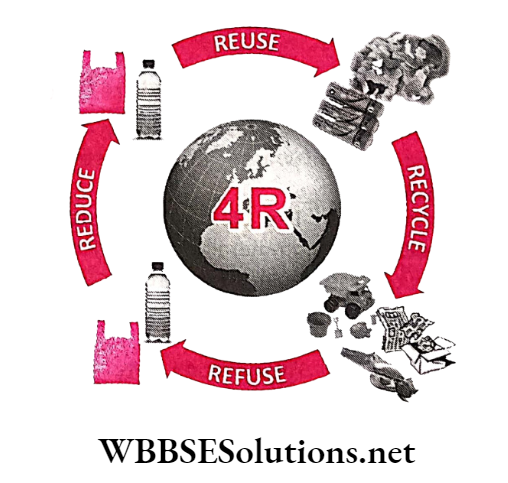
1. Reduce:
Those waste products which increase garbage in our environment should be reduced on day to day basis, for example, plastic bags, thermal, plastic bottles etc.
2. Reuse:
Reusing the waste materials instead of discarding them, for example, vegetable peels, rechargeable batteries, etc.
3. Recycle:
This involves making new useful products from waste products, for example, plastic toys, old iron, glass materials, papers, aluminium, etc.
4. Refuse:
People should learn to refuse to accept such materials which would eventually produce non-biodegradable
Chapter 12 Waste Products Waste Recycling Processes
Recycling is processing used materials (waste) into new, useful products. This is done to reduce the use of raw materials that would have been used.
Recycling also uses less energy and great way of controlling air, water and land pollution.
Effective recycling starts with the household (or the place where the waste is created). In many serious countries, the authorities help households with bin bags with labels on them.
Households then sort out the waste themselves and place them in the right bags for collection. This makes the work less difficult.
Waste items that are usually recycled include:
1. Paper waste:
Paper waste items include books, newspapers, magazines, cardboard boxes and envelopes.
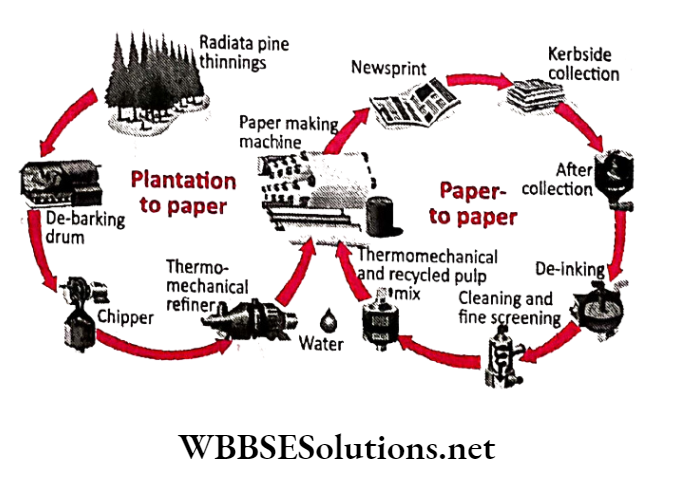
Recycling of Paper Waste:
1. Collection, transportation and storage:
The biggest task for paper recycling companies probably includes the collection, transporting and sorting of waste paper.
This is because we always add paper to other waste items and get them contaminated with food, plastic and metals.
Sometimes collected paper is sent back to the landfills because they are too contaminated to use.
Waste paper should be kept in separate grades at home or in the office, for example, newspapers and corrugated boxes should not be mixed.
All paper recovered is sent to the recycling centre, where it is packed, graded, put into bales and sent to the paper mill. At the mill, all the paper is stored in a warehouse until it is needed.
2. Repulping and Screening:
From the storage shelves, they are moved into a big paper grinding machine called a vat (pulper).
Here the paper is chopped into tiny pieces, mixed with water and chemicals and heated up to break it down into organic plant material called fibre.
After that, it is screened to remove contaminants such as bits of plastic and globes of glue.
3. Deinking:
This involves ‘washing’ the pulp with chemicals to remove printing ink and glue residue.
Sometimes, a process called floatation is applied to further remove got stubborn stains and sticky substances.
Floatation involves the use of chemicals not and air to create bubbles, which absorb the art stickies in the pulp.
4. Refining, Bleaching and Colour Stripping:
Refining involves beating the recycled pulp to make them ideal for paper-making.
After refining, additional chemicals are added to the bay to remove any dyes from the paper. It is then bleached to whiten and brighten it up.
5. Papermaking:
At this stage, the pulp is ready to be used for manufacturing paper. Sometimes new pulp (virgin pulp) is added to give it extra strength and smoothness.
Water is added to the pulp and sprayed onto a large metal screen in continuous mode. The water is drained on the screen and the fibres begin to bond with each other.
As it moves through the paper-making machines, press rollers squeeze out more water, heat them dry and coat them up. They are then finished into rolls.
2. Plastic waste:
Items include plastic bags, water bottles, rubber bags and plastic wrappers. They cannot be degraded so bio-plastic may be used, which is degraded by bacterial enzymes. The reuse of plastic is highly recommended.
3. Glass waste:
All glass products like broken bottles, beer and wine bottles can be recycled.
1. Recycling of Glass:
Recycling glass starts in your home. There is a reason why many 916 local councils provide different containers for green, brown, plain glass and even glass hot from broken windows.
The reason is that they are all made very differently and mixing them can create huge problems at the recycling centre.
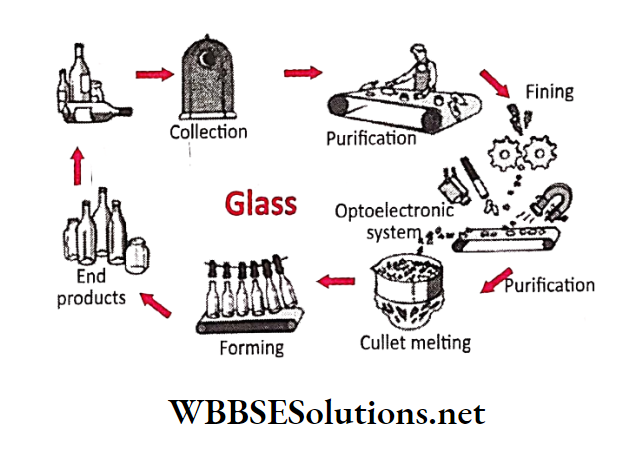
2. Collection:
Many cities have collection spots. Trucks may also pick them up from your home, or you may be required to drop them off at a point in your town.
In all cases, try to do what the authorities have suggested. So, be sure you know the various glass types that are collected from your home.
They are washed and separated into the required grades for collection.
3. Cleaning and Crushing:
The glass is transported to the processing plant, where contaminants such as metal caps and plastic sleeves are removed.
Different grades are treated separately. Clean glass is then crushed into small pieces called cullet. Cullet is in high demand from glass manufacturers.
It melts at a lower temperature and it is cheaper than raw glass materials.
4. Ready for use:
The cullet is then transported to glass-making factories. Here, it is mixed with sand, soda ash and limestone.
It is heated at a very high temperature and melted into liquid glass. This liquid is then poured into moulds that give glass its shape.
Glass is used for many things, depending on what grade they were recycled from. A few items made of recycled glass include fibre-glass, countertops, bottles and jars.
4. Aluminium waste:
Cans from soda drinks, tomatoes, fruit cans and all other cans can be recycled.
When these are collected, they are sent to the recycling unit, where all the waste from each type is combined, crushed, melted and processed into new materials.
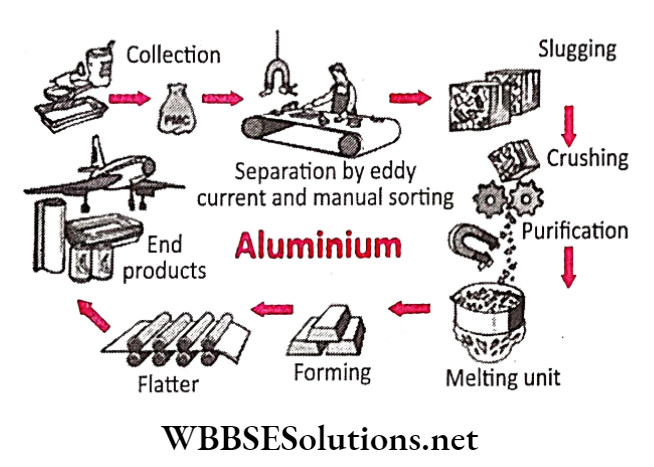
1. Aluminium recycling:
In recent times, there has been a massive improvement in recycling aluminium cans. Those cans, hoil-placed end-to-end, could make 171 circles around the earth.
Every minute, an average of 105,800 aluminium cans are recycled. It is clear that can recycling is very important in the present life.
2. Collection:
People may use special cans. recycling containers (bins) that are clearly marked. This helps people to know what to place in them.
Can include soda, fruit and vegetable cans. Trucks come for these at pick-up spots at the recycling centres. Cans may also be metallic or steel, but usually, common people do not know the difference.
3. Preparation:
At the collection centre, a huge magnet is rolled over them as they move on the conveyor belt to pull out all the metal and steel cans.
Only the aluminium cans are washed, crushed, and condensed into 30 pounds. briquettes for other companies for further processing. The rest is also sorted and sent to their appropriate recycling centres.
4. Melting:
The crushed cans are loaded into a burning furnace, where all printing and designs on the cans are removed, melted and blended with new (virgin) aluminium.
The molten (liquid) aluminium is poured into moulds and made into bars called ingots.
5. Sheets:
The ingots are then fed into powerful rollers, which flatten them into. thin sheets of aluminium. These thin sheets are rolled into coils and sold or sent to can-making factories.
They use aluminium coils to prepare cans and containers for other food and drink manufacturers.
It is estimated that cans collected at collection points take up to 60 days to reappear in the shops again as new cans containing your favourite soda, juice or food.
Chapter 12 Waste Products Importance and Benefits of Waste Recycling
1. Recycling helps to protect the bar environment:
Had recycling not been done, these waste materials would have otherwise been burned or ended up in the landfill. Thus pollution of the air, land, water and soil is reduced through recycling.
2. Recycling conserves natural resources:
Recycling more waste means that we do not depend too much on raw (natural) resources, which are already massively depleted. This enormously preserves natural earthly resources.
3. Recycling saves energy:
It takes more energy to produce items with raw materials than from recycled used. materials. This means that recycling is more energy efficient and so, the prices of products can come down through this.
4. Recycling metals reduces the cost of processing from ores.
5. Recycling plastic can straight away reduce the menace of plastic pollution, protecting the microbes from getting killed due to the mulching effect.
6. The waste products generated from a particular industry can be used by other industries developing along with it, thus developing the economy of the country.
WBBSE Notes For Class 6 School Science Chapter 11 Habits And Habitats Of Some Important Animals
Chapter 11 Habits And Habitats Of Some Important Animals
Behavioural Science And Behavioural Scientists
Introduction
Behavioural science is the systematic analysis and investigation of human and animal behaviour through controlled and naturalistic observation and disciplined scientific experimentation.
Examples of behavioural sciences include psychology, psychobiology, criminology and cognitive science. The investigative study related to this field aims to.
- Describe the behaviour
- Predict behaviour
- Determine the causes behind the behaviour Netherlands and Konrad Lorenz of Austria. and,
- Understand or explain behaviour.
Behavioural Biology is an interdisciplinary field of science that examines the bidirectional interactions between behaviour and biology.
Read And Learn More: WBBSE Notes For Class 6 School Science
The study of animal behaviour is known as Ethology.
Although many naturalists have studied aspects of animal behaviour through the centuries, the modern science of ethology is usually considered to have arisen as a discrete discipline with the work (in the 1920s) of biologists Nikolaas Tinbergen of the Netherlands and Korenz Lorenz of Austria.
Chapter 11 Habits And Habitats Of Some Important Animals History of Behavioural Science
Ethology has existed as a concept since 1762 when it was defined in France as the study of animal behaviour.
In this sense, it carries the same meaning as the Greek word “ethos”, from which the modern term ethology is derived.
Many naturalists have studied aspects of animal behaviour throughout history.
Ethology has its scientific roots in the work of Charles Darwin and of American and German ornithologists of the late 19th and early 20th century, including Charles O.
Whitman, Oskar Heinroth and Wallace Craig.
The modern discipline of ethology is generally considered to have begun during the 1930s with the work of Dutch biologist Nikolaas Tinbergen and Austrian biologists Konrad Lorenz and Karl von Frisch, joint awardees of the 1973 Nobel Prize in Physiology or Medicine.
Ethology is a combination of laboratory and field science with a strong relation to some other disciplines such as neuroanatomy, ecology, and evolutionary biology.
Ethologists are typically interested in a behavioural process rather than in a particular animal group, and often study one type of behaviour, such as aggression, in a number of unrelated animals.
Ethology is a rapidly growing field. Since the dawn of the 21st century, many aspects of animal communication, emotions, culture, learning and sexuality that the scientific community long thought it understood have been re-examined, and new conclusions reached.
New fields, such as neuroethology, have developed. Understanding ethology or animal behaviour can be important in animal training.
Considering the natural behaviours of different species or breeds enables the trainer to select the individuals best suited to perform the required task.
It also enables the trainer to encourage the performance of naturally occurring behaviours and also the discontinuance of undesirable behaviours.
The founder of modern ethology is Konrad Z. Lorenz, a physician, zoologist, and comparative anatomist. By systematic application of biological research methods to the analysis of animal behaviour, he provided the initial.
impetus in the 1930s. The first modern ethology textbook, The Study of Instinct, was written by Nikolaas Tinbergen in 1951. E. H. Hess (1962) and Eibl-Eibesfeldt (1966) produced summaries of the modern concepts of behaviour.
The observations of a number of pioneers, including Spalding (1873), Darwin (1872), Whitman (1898), Altum (1868), Heinroth (1911), and Craig (1918), awakened scientific interest in animal behaviour, and ethology came to be considered an independent branch of zoology around 1910.
Chapter 11 Habits And Habitats Of Some Important Animals Some Notable Behavioural Scientists
1. Charles Robert Darwin:
Naturalist Charles Darwin was born in Shrewsbury, England, on February 12, 1809. In 1831, he embarked on a five-year survey voyage around the world on the HMS Beagle.
His studies of specimens around the globe led him to formulate his theory of evolution and his views on the process of natural selection.
On November 24, 1859, he published a detailed explanation of his theory in his best-known work, On the Origin of Species by Means of Natural Selection. He died on April 19, 1882, in London.
Darwin proposed that instincts were behavioural adaptations that had evolved by natural selection.
Darwin provided many examples of instinctive behaviours in animals and suggested how such behaviours could have evolved.
He explained the roles that emotions play in the biology of animals and extended those explanations to humans.

2. Jean Henri Fabre:
Jean Henri Fabre (December 22, 1823- October 11, 1915) was a French entomologist, famous for his study of the anatomy and behaviour of insects.
Largely self-taught, Fabre began his career as a Physics teacher at Carpentras (France). From his youth, he was attracted by the beauty of butterflies and grasshoppers.
Fabre did important research on the insect of bees, wasps, beetles, grasshoppers and crickets.
Based on his observations of the paralyzing actions of wasps in response to stimulating zones in their prey, he described the importance of inherited instinct as a behaviour pattern in insects.
Although Fabre never accepted the theory of evolution, his work was respected by Darwin.

3. Nikolaas Tinbergen:
Niko Tinbergen (April 15, 1907- December 21, 1988) was a Dutch ethologist, zoologist, and ornithologist.
He shared the 1973 Nobel Prize in Physiology or Medicine with Karl von Frisch and Konrad Lorenz for their discoveries concerning the organization and elicitation of individual and social behaviour patterns in animals.
Together with Lorenz, Tinbergen established European ethology as the study of the behavioural patterns of animals in the context of their natural environments.
Tinbergen believed that the study of ethology should be applied to human behaviour as well as animals.
This did not mean that animal behaviour should be extrapolated to humans but that the same methodology could be applied.
Tinbergen emphasized the importance of both instinctive and learned behaviour to survival and used animal behaviour as a basis for speculations about the nature of human violence and aggression.
He is especially well known for his long-term observation of seagulls, which led to important generalizations on courtship and mating behaviour.
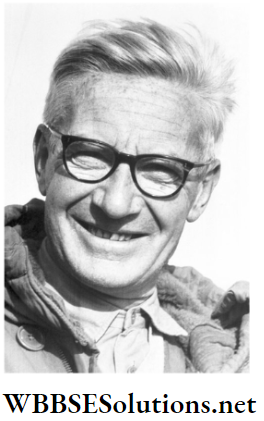
4. Konrad Lorenz:
Konrad Lorenz (November 7, 1903-February 27, 1989) was an Austrian zoologist, founder of modern ethology, and famous for the study of animal behaviour by means of comparative zoological methods.
His ideas contributed to an understanding of how behavioural patterns may be traced to an evolutionary past, and he was also known for his work on the roots of aggression.
He shared the Nobel Prize for Physiology or Medicine in 1973 with the animal behaviourists Karl Von Frisch and Nikolaas Tinbergen.
Encouraged by the positive response to his scientific work, Lorenz established colonies of birds, such as the jackdaw and greylag goose, published a series of research papers on his observations and soon gained an international reputation.

5. Karl von Frisch:
Karl von Frisch (November 20, 1886-June 12, 1982) was a zoologist, whose studies on communication among bees added significantly to the knowledge of the chemical and visual sensors of insects.
He shared the Nobel Prize in 1973 for Physiology or Medicine jointly with animal behaviourists Konrad Lorenz and Nikolaas Tinbergen.
In 1949 Frisch established that bees, through their perception of polarized light, use the Sun as a compass.
He also found that they are capable of using this method of orientation when the Sun is not visible, apparently remembering patterns of polarization presented by the sky at different times of the day and the location of previously encountered landmarks.
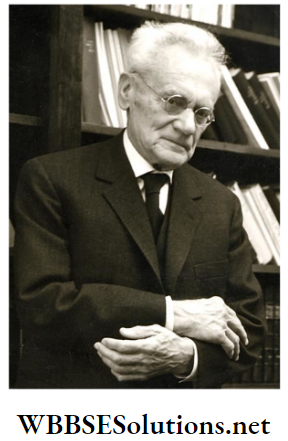
6. Valerie Jane Goodall:
Born on April 3, 1934, in London, England, Jane Goodall set out to Tanzania to study chimpanzees by sitting amongst them, bypassing more high procedures and uncovering discoveries about primate behaviour that have continued to shape scientific discourse.
She is a highly respected member of the world scientific community. By remaining in almost constant contact with the chimps, she discovered a number of previously unobserved behaviours.
She noted that chimps have a complex social system, complete with ritualized behaviours and primitive but discernible communication methods, including a primitive “language” system containing more than 20 individual sounds.
She is credited with making the first recorded observations of chimpanzees eating meat and using and making tools.
Tool making was previously thought to be an exclusively human trait, used, until her discovery, to distinguish humans from animals.
She also noted that chimpanzees throw stones as weapons, use touch and embraces to comfort one another and develop long-term familial bonds.
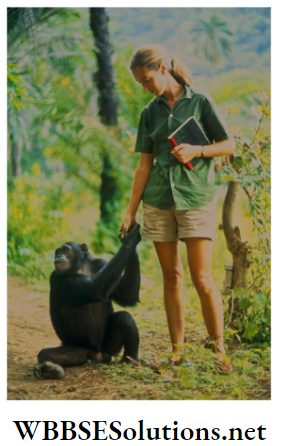
7. Salim Ali:
Salim Moizuddin Abdul Ali (12 November, 1896-20 June, 1987) was an Indian ornithologist and naturalist.
Sometimes referred to as the “birdman of India”, Salim Ali was among the first Indians to conduct systematic bird surveys across India and several bird books that he wrote helped popularize ornithology in India.
He became the key figure behind the Bombay Natural History Society after 1947 and used his personal influence to garner government support for the organisation, create the Bharatpur bird sanctuary (Keoladeo National Park) and we do prevent the destruction of what is now the Silent Valley National Park.
Along with Sidney Dillon Ripley, he wrote the ten-volume Handbook of the Bird of India and Pakistan, a second edition of which was completed after his death.
He was awarded the Padma Bhushan in 1958 and the Padma Vibhushan in 1976.

8. Raghavendra Gadagkar:
Raghavendra Gadagkar was born in 1953 in Kanpur. Gadagkar is a professor at the Centre for Ecological Sciences.
Indian Institute of Science in Bangalore, India, studies the evolution of social behaviour using locally common wasps as a model.
His first book, Survival Strategies, has been translated into Chinese and Korean languages.
It uses simple language to explain recent advances in behavioural ecology and sociobiology to a general audience.
He has won numerous awards for his contributions to scientific research and the Shanti Swarup Bhatnagar Award in Biology in 1993.

9. M. K. Chandrashekaran:
Maroli Krishnayya Chandrashekaran (4 September 1937-2 July 2009) was an Indian zoologist, regarded as the founder of Indian chronobiology, the study of biological rhythms of organisms.
He studied the light- sensitivity of the eyes of bats associated with dawn and dusk as well as colours and flashes.

10. Ratan Lal Brahmachary:
Veteran wildlife biologist R.L. Brahmachary is a pioneer in tiger pheromone research.
He is known for his work in many fields like agricultural sciences, zoology, botany, and biometrics, did much of his work at Indian Statistical.
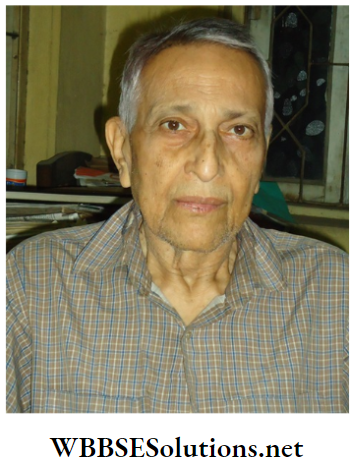
11. Gopal Chandra Bhattacharya:
Gopal Chandra Bhattacharya (1 August 1895-8 April 1981) was an Indian entomologist and naturalist.
One of his monumental works was the book “Banglar Kitpatanga” (The Insects of Bengal) which fetched him the Rabindra Purashkar in 1975. He had already been awarded the Ananda Purashkar in 1968.
Gopal did not have formal education beyond school and this was the cause of much humiliation for him
when well-established scientists refused to acknowledge his work.
He published his first research papers in 1932, on life events in the body of plants.
Subsequently, he also published work on bioluminescence and other botany topics, but gradually his interests shifted to entomology.
He became an expert photographer and photographed many varieties of ants, spiders, small bats and tadpoles.
Credited with popularizing science in Bengal, he is best known for his studies in insects and metamorphosis.
He was awarded the Rabindra Puraskar, Bengal’s highest literary award, in 1975. He worked as a school teacher and published a handwritten literary magazine.
Published his first article on bioluminescence in the then-popular Bengali periodical ‘Prabasi”.
This attracted the attention of none other than Dr. Jagadish Chandra Bose who, realizing his potential, organized a position for him at the Basu Vigyan Mandir (now christened the Bose Institute) where he was employed basically as a technical assistant.

The Habits and Behaviour of Some Animals
Introduction
In zoology (particularly in ethology) habit usually refers to the behaviour of animals.
The study of animal behaviour begins with understanding how an animal’s physiology and anatomy are integrated with its behaviour.
Both external and internal stimuli prompt behaviours-external information (for example threats from other animals, sounds, smells) or weather and internal information (for example hunger, fear).
Understanding how genes and the environment come together to shape animal behaviour is also an important underpinning of the field.
Genes capture the evolutionary responses of prior populations to selection on behaviour. Environment flexibility gives animals the opportunity to adjust the changes during their own lifetime.
Scientists are drawn to the study of animal behaviour for varied reasons and the field is extremely broad, ranging from research on feeding behaviour and habitat selection to mating behaviour and social organizations.
Many scientists study animal behaviour because it sheds light on human beings.
Research on non-human primates, for instance, continues to offer perspectives into the causes and evolution of individual, social, and reproductive human actions.
Understanding why some animals help others at the potential cost of their own survival and reproduction, for example, not only gives us insight into their behaviour but could also potentially help us to understand the underpinnings of our species’ ideas of altruism and sacrifice.
Other scientists are motivated by environmental concerns.
When we gain insight into animal behaviour, we are in a stronger position to understand vexing conservation problems, such as how to save endangered species, assess environmental quality, design nature preserves, and evaluate the importance of human-related threats to survival in otherwise fit animals.
To develop a rich understanding of animal behaviour, let us now discuss a few animals and their interesting behaviours.
Chapter 11 Habits And Habitats Of Some Important Animals Ants
Ants are truly social or eusocial insects. Ants evolved from wasp-like ancestors between 110 and 130 million years ago and diversified after the rise of flowering plants.
More than 12,500 of an estimated total of 22,000 species have been classified.
They are easily identified by their elbowed antennae and the distinct node-like structure that forms their slender waists.
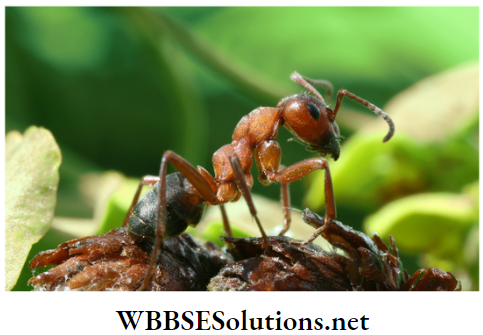
Ants form colonies that range in size from a few dozen predatory individuals living in small natural cavities to highly organised colonies that may occupy large territories and consist of millions of individuals.
Larger colonies consist mostly of sterile, wingless females forming castes of “workers”, “soldiers”, or other specialised groups.
Nearly all ant colonies also have some fertile males called “drones” and one or more fertile females called “queens”.
The colonies are described as superorganisms because the ants appear to operate as a unified entity, collectively working together to support the colony.
Ants communicate with each other. through tapping with the antennae and smell. The queen emits a scent that makes all the workers behave in the way they do.
An ant that loses its way to the nest does not live long. So, if you take ants away from their nest, or trail, they are likely to die in great need of their nest’s smell (and probably quite hungry).
Ants have colonised almost every landmass on Earth. The only places lacking indigenous ants are Antarctica and a few remote or inhospitable islands.
Ant societies have a division of labour, communication between individuals, and an ability to solve complex problems.
These parallels with human societies have long been an inspiration and subject of study. Many human cultures make use of ants in cuisine, medication, and rituals.
Their ability to exploit resources may bring ants into conflict with humans, however, as they can damage crops and invade buildings.
Some species, such as the red fire ants are regarded as invasive species. Some ants have ‘armies’ and are very organized in causing.
Chapter 11 Habits And Habitats Of Some Important Animals Termites
Termites are eusocial insects that are closely related to cockroaches. Although these insects are often called white ants, they are not ants.
Termites are usually small, measuring between 4 to 15 millimetres (0.16 to 0.59 inches) in length, but larger species are also found.
Most worker and soldier termites are completely blind and do not have a pair of eyes.
Termite antennae have a number of functions such as sensing touch, taste, odours (including pheromones), heat and vibration.
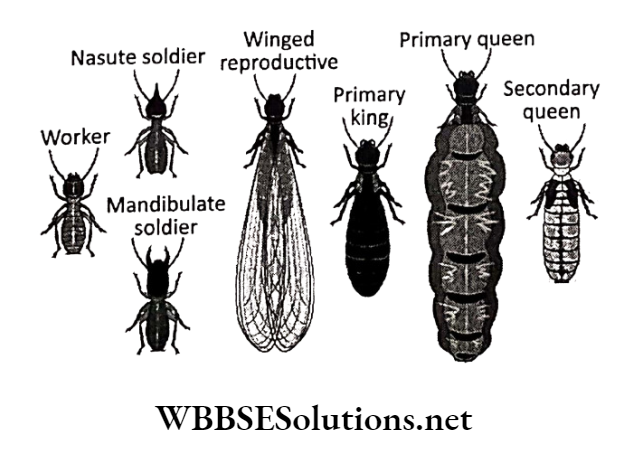
Apart from male and female ants, other kinds of ants that are found include:
1. Red ants:
Red ants are aggressive, good at fighting and can cause painful bites because of their sharp teeth. They mostly live in the tir bark of trees.
2. Black ants:
Black ants are fairly docile, hard workers and are more intelligent compared to red ants.
3. Nomadic ants:
These are found in hot countries. They keep changing their nests. from time to time.
4. Peasant ants:
Peasant ants make a hole in the ground and build nests therein. The leaves which fall in their nests get rotten and a whitish fungus forms on top of them. This fungus is a favourite food for the peasant ants.
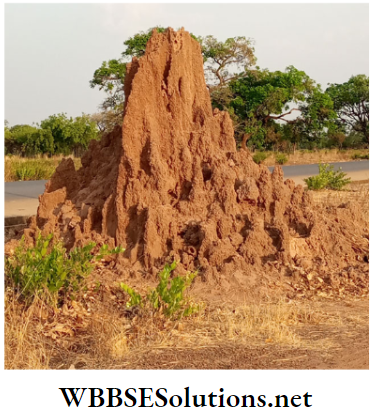
Termites divide labour among castes consisting of sterile male and female “workers” and “soldiers”. All colonies have fertile males called “kings” and one or more fertile females called “queens”.
The queen of the colony is responsible for egg production. Unlike in ants the king mates with her for life.
Termites mostly feed on dead plant material and cellulose, generally in the form of wood, leaf litter, soil, or animal dung.
They also play a vital role in the ecosystem by recycling waste material such as dead wood, faeces and plants.
Worker termites undertake the most labour within the colony, being responsible for foraging, food storage, and brood and nest maintenance.
Workers are tasked with the digestion of cellulose in food and are thus the most likely caste to be found in infested wood. The process of worker termites feeding other nestmates is known as trophallaxis.
Trophallaxis is an effective nutritional tactic to convert and recycle nitrogenous components.
The soldier caste has anatomical and behavioural specialisations, and their sole purpose is to defend the colony.
Many soldiers have large heads with highly modified powerful jaws so enlarged they cannot feed themselves.
Instead, like juveniles, they are fed by workers. Termites do not usually come out of their holes because if they are too exposed to sunlight, the water in their bodies dries up.
Chemical substances such as pheromones and hormones play a role in the differentiation, production, and regulation of castes.
Both reproductive and soldier castes secrete a pheromone (chemical signal) that is transmitted through food sharing (trophallaxis) and grooming to other members of the colony and inhibits the development of reproductives or soldiers.
Termites are important in two ways. They are destructive when they feed upon, and often destroy wooden structures or vegetable matter valuable to humans.
Termites are also extremely beneficial in that they help to convert plant cellulose into substances that can be recycled into the ecosystem to support growth.
Termites are a delicacy in the diet of some human cultures and are used in many traditional medicines.
Chapter 11 Habits And Habitats Of Some Important Animals Honeybees bes
Honey bees are flying insects and close relatives of wasps and ants. There are five well-recognised types of bees found in the world-
- Apis dorsata (Rock bee)
- Apis florea (Little bee)
- Apis indica (Indian bee)
- Apis mellifera (European bee)
- Apis Adamson (African bee)
Out of these five types, three are common in India. They are Apis dorsata, Apis florea and Apis indica. Honeybees are not native to the United States.
They were brought there from Europe in the 1600s. Bees are an animal most of us learn about very early on, one way or another.
Honey bees are usually very gentle creatures who mind their own business. They are too busy to worry about people or other animals.
Honey bees are normally about 3/ 4 of an inch long. Most bees are workers, which are female, but some are male, called “drones.”
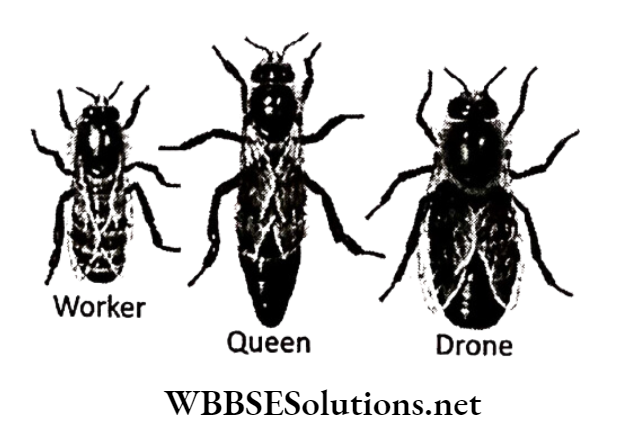
Workers are slightly smaller than drones. All honey bees are reddish brown and black, with orangish-yellow rings on the abdomen (back part of the body).
The head, antennae, and legs are black. Honey bees have thick, pale hair on the thorax (middle part of the body).
Honey bees live in a nest, called a “hive”. A single hive can have up to 80,000 bees, mostly workers. It is usually located in a hollow tree. The hive is ruled over by a queen bee.
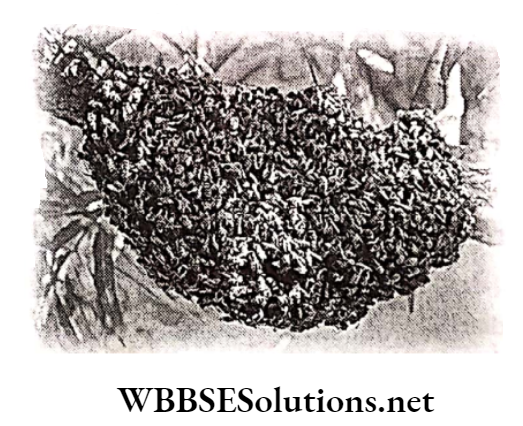
She is the largest bee in the hive, and she is the only female to mate. Males usually just hang around; their only purpose is to mate with the queen.
Then they die. The workers do all of the work inside and outside of the hive.
Their jobs include caring for larvae (baby bees), making wax, building honeycombs, cleaning up the hive, storing pollen, making honey, guarding the hive, and collecting pollen and nectar.
A honeycomb is a layer of wax cells (little rooms) made into a hexagonal (six-sided) shape. The queen will lay eggs in the cells and honey bee babies, called larvae, will hatch.
Larvae will eventually pupate (make a cocoon in their cells), and hatch out as adult bees. Honey bees eat nectar and pollen from flowers.
Nectar is the liquid in a flower, and pollen is a powdery substance which must be transferred from one flower to another to make more flowers.
Larvae eat honey. Queen bees eat royal jelly. Royal jelly is a paste made by worker bees.
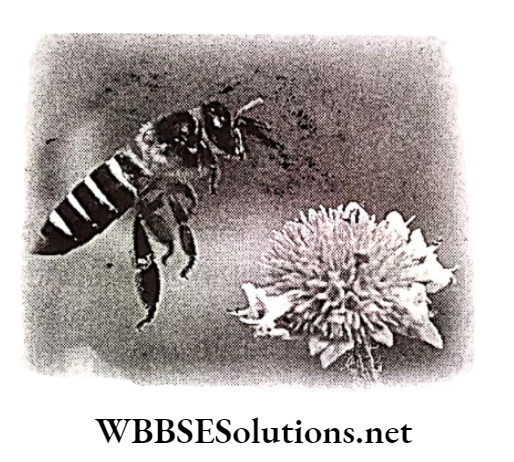
The queen lays eggs which become males, workers, or new queens, depending on the time of year, age of the hive and food provided during larval development.
However, males are always produced from unfertilized eggs by a process known as parthenogenesis.
The new queen will either kill the old queen and be the queen of the old hive or fly away with some other members to establish a new hive.
When honey bees seek out nectar and pollen to make honey with, they visit many different types of flowers and help in pollination.
Once at the flower, the worker bee drinks as much nectar as she can hold. When she gets back to the hive, she passes the nectar on to another worker.
This worker holds the nectar on her tongue until the water evaporates. She is left with honey on her tongue, which is stored in the hive.
Bees eat their store of honey in the winter when there is no food. Karl von Frisch discovered the language used by bees to communicate.
When a bee finds a good place with lots of flowers, she marks the spot with a scent. She then goes back to the hive and does a little “dance” which tells the other bees, the distance and direction to go.
This communication helps the hive locate good places so they don’t waste time always looking for flowers.
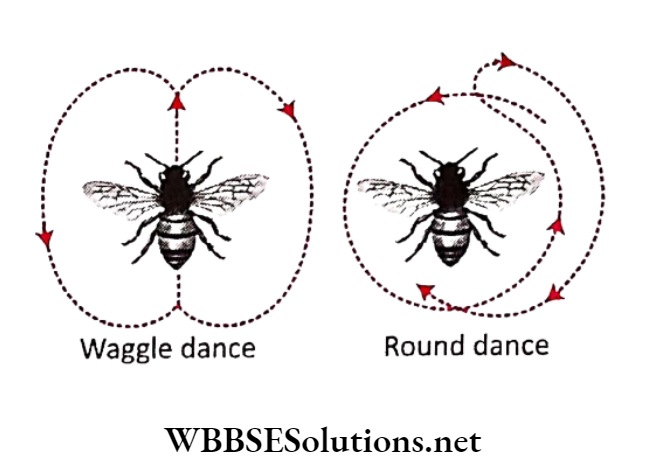
Honey bees are attracted to flowers with bright colours, but they cannot see red. When a bee enters a flower, it has to go deep down to get to the nectar.
While it drinks nectar, the bee gets covered with pollen. The bee also collects the pollen in its pollen basket (part of its hind legs).
When the bee moves on to another flower, some of the pollen from the first flower rubs off on the second flower.
This is pollination. Now the plant will drop its flower and make a fruit with seeds in it. The seeds may grow into a new plant.
The bees cannot live without the plants and the plants cannot live without the bees.
Worker bees have a stinger which is sharp and has a barb on it (like a fishhook). The stinger is attached to a venom gland in the abdomen.
Honey bees only sting if they, or the hive, are in danger.
However, if she stings an animal with tougher tissue, such as a frog or a human, the barb gets caught and the stinger tears out the abdomen, along with the poison gland.
This will kill the honey bee. The venom is what makes the beesting hurt. Beestings, are not really dangerous unless you are allergic to bees.
Honeybees are very important animals. Humans rely on them to pollinate crops, especially fruit trees such as oranges and peaches.
If honey bees don’t transfer pollen from flower to flower, we would have a difficult time growing fruit. People also eat honey and use wax from honeycomb to make candles and other products.
Honey bee venom is used to make medicine to cure arthritis.
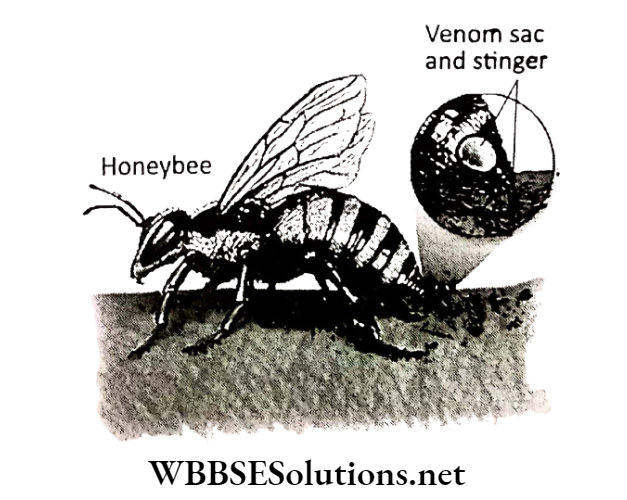
Chapter 11 Habits And Habitats Of Some Important Animals Elephants
Elephants are large mammals. Two species are traditionally recognised, the African elephant (Loxodonta africana) and the Asian elephant (Elephas maximus).
Male African elephants are the largest extant terrestrial animals and can reach a height of 4 m (13 ft) and weigh 7,000 kg.
All elephants have several distinctive features, the most notable of which is a long trunk or proboscis, used for many purposes, particularly breathing, lifting water and grasping objects.
Their incisors grow into tusks, which can serve as weapons and as tools for moving objects and digging. Elephants’ large ear flaps help to control their body temperature.
Their pillar-like legs can carry their great weight. African elephants have larger ears and concave backs while Asian elephants have smaller ears and convex or level backs.
As they are huge in size, elephants eat a lot. Each elephant can eat up to one hundred and fifty kg of grass-branches leaves in a day.
Elephants are herbivorous and can be found in different habitats including savannahs, forests, deserts and marshes. They prefer to stay near water.
They are considered to be keystone species due to their impact on their environments.
Other animals tend to keep their distance whereas predators such as lions, tigers, hyenas, and wild dogs usually target only young elephants.
Females tend to live in family groups, which consist of one female with her calves or several related females with offspring.
The groups are led by an individual known as the matriarch, often the oldest female. Males leave their family groups when they reach puberty (between the ages of 12-15), and may live alone or with other males.
Adult males mostly interact with family groups when looking for a mate and enter a state of aggression known as musth, which helps them gain dominance and reproductive success.
Calves are the centre of attention in their family groups and rely on their mothers for as long as three years. The rules in an elephant society are rather strict.
If an elephant calf gets lost while walking in the forest, the herd tries to search it out. But if they see that the lost calf has found a human shelter, they never accept it back.
Elephants can live up to 70 years in the wild. They communicate by touch, sight, smell and sound; elephants use infrasound, and seismic communication over long distances.
Elephant intelligence has been compared with that of primates and cetaceans. They appear to have self-awareness and show empathy for dying or dead individuals of their kind.
Elephants are not territorial. The home range is between 10-70 km and possibly larger, depending on herd size and seasonality.
Elephants sleep about approximately four hours a night. Elephants are crepuscular in nature, primarily active at dawn and dusk (twilight hours) when the environment is cooler.
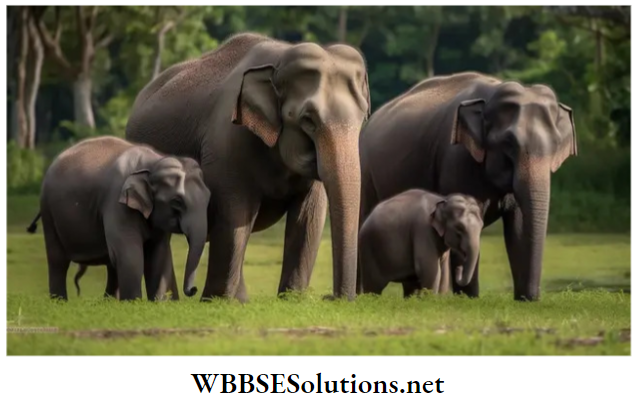
Chapter 11 Habits And Habitats Of Some Important Animals Chimpanzees
Chimpanzees (sometimes called chimps) are one of two exclusively African species of great ape that are currently extant. Native to Sub- Saharan Africa, both are currently found in the Congo jungle.
Classified in the genus Pan, they were once considered to be one species.
However, since 1928, they have been recognized as two distinct species the common chimpanzee (Pan troglodytes) live in the north of the Congo River and the bonobo (Pan paniscus) which live in the south.
The most obvious differences are that chimpanzees are somewhat larger, more aggressive and male-dominated, while the bonobos are more gracile, peaceful, and female-dominated.
Their hair is typically black or brown. Males and females differ in size and appearance. Standing approximately 4 feet high, males weigh about 45-55 kg, while females weigh between 30-50 kg.
Both chimps and bonobos are some of the most social great apes, with social bonds occurring among individuals in large communities.
Fruit is the most important component of a chimpanzee’s diet; however, they will also eat vegetation, bark, honey, insects and even other chimps or monkeys.
Chimpanzees rarely live past the age of 50 in the wild but have been known to reach the age of 60 in captivity. Chimpanzees and bonobos are equally the closest living relatives.
As such, they are among the largest-brained, and most intelligent of primates; they use a variety of sophisticated tools and construct elaborate sleeping nests each night from branches and foliage.
They have both been extensively studied for their learning abilities.
There may even be distinctive cultures within populations. Field studies of common chimpanzees were pioneered by primatologist Jane Goodall.
Both Pan species are considered to be endangered as human activities have caused severe declines in the populations and ranges of both species.
Several conservation and rehabilitation organisations are dedicated to the survival of Pan species in the wild.
Anatomical differences between the common chimpanzee and the bonobo are slight, but sexual and social behaviours are markedly different.
The common chimpanzee has an omnivorous diet. Chimps occasionally hunt and eat meat. The bonobo, on the other hand, has a mostly frugivorous diet and non-violent, matriarchal behaviour.
Different groups of chimpanzees also have different cultural behaviour with preferences for types of tools.
The common chimpanzee tends to display greater aggression than the bonobo. The average, captive chimpanzee sleeps 9.7 hours a day.
Studies have shown chimpanzees engage in apparently altruistic behaviour within groups. Chimpanzees live in large multi-male and multi-female social groups, which are called communities.
Within a community, the position of an individual and the influence the individual has on others dictates a definite social hierarchy.
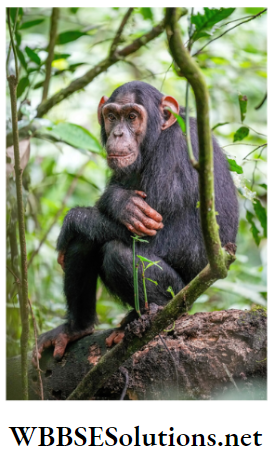
Chimpanzees live in a leaner hierarchy wherein more than one individual may be dominant enough to dominate other members of lower rank.
Typically, a dominant male is referred to as the alpha male. The alpha male is the highest-ranking male that controls the group and maintains order during disputes.
In chimpanzee society, the ‘dominant male’ sometimes is not the largest or strongest male but rather the most manipulative and political male that can influence the goings on within a group.
Male chimpanzees typically attain dominance by cultivating allies who will support that individual during future ambitions for power.
Lower-ranking chimpanzees will show respect by submissively gesturing in body language or reaching out their hands while grunting.
Female chimpanzees will show deference to the alpha male by presenting their hindquarters.
Chimps live in communities. These communities are composed of family groups of three to six individuals, totalling about 50 animals.
Most mothers give birth to one young an average of every five to six years in the wild. Young chimps stay with their mothers for up to 10 years.
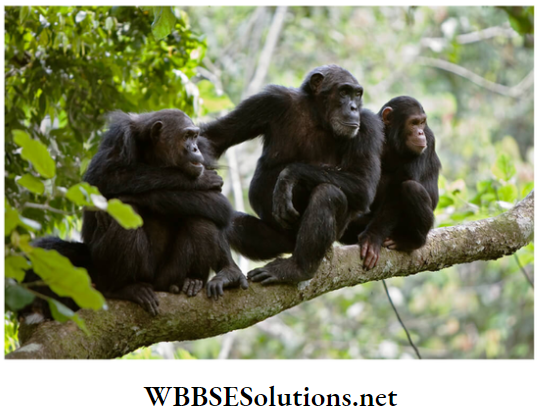
Chimpanzees make tools and use them to acquire food and for social displays; they have sophisticated hunting strategies requiring cooperation, influence and rank; they are status.
Conscious, manipulative and capable of deception; they can learn to use symbols and understand aspects of human language including some relational syntax, concepts of numbers and numerical sequence and they are capable of spontaneous planning for a future state or event.
Recent research indicates that chimpanzees’ use of stone tools dates back at least 4,300 years (about 2,300 BC).
One example of chimpanzee tool usage behaviour includes the use of a large stick as a tool to dig into termite mounds and the subsequent use of a small stick altered into a tool that is used to “fish” the termites out of the mound.
Chimpanzees are also known to use smaller stones as hammers and a large one as an anvil in order to break open nuts.
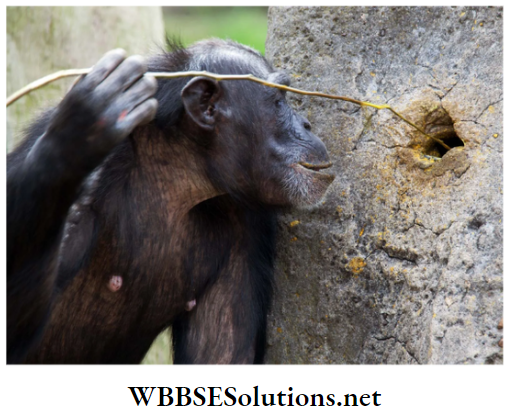
Chapter 11 Habits And Habitats Of Some Important Animals Migratory birds
Avian migration is a natural miracle. Migratory birds fly hundreds and thousands of kilometres to find the best ecological conditions and habitats for feeding, breeding and raising their young.
When conditions at breeding sites become unfavourable, it is time to fly to regions where conditions are better.
Birds migrate to move from areas of low or decreasing resources to areas of high or increasing resources. The two primary resources being sought are food and nesting locations.
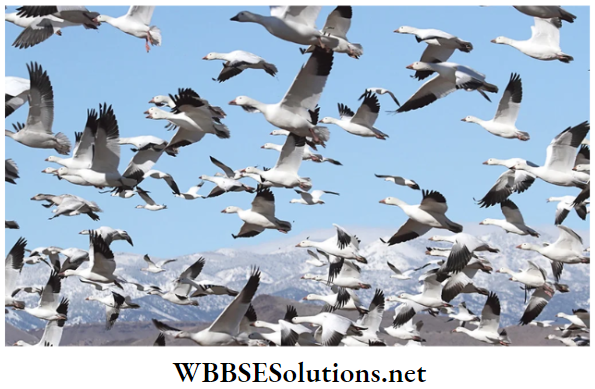
There are many different migration patterns. The majority of birds migrate from northern breeding areas to southern wintering grounds.
However, some birds breed in southern parts of Africa and migrate to northern wintering grounds, or horizontally, to enjoy the milder coastal climates in winter.
Other birds reside in lowlands during the winter months and move up a mountain for the summer.
Geese winging their way south in wrinkled V-shaped flocks is perhaps the classic picture of migration- the annual, large-scale movement of birds between their breeding (summer) homes and their non-breading (winter) grounds.
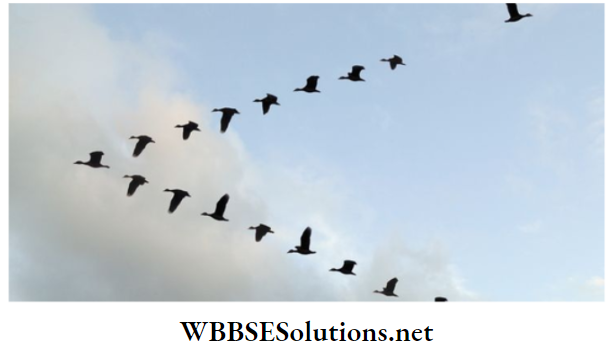
Migratory birds have the perfect morphology and physiology to fly fast and across long distances. Often their journey is an exhausting one, during which they go to their limits.
The Red Knot has one of the longest total migration routes of any bird, travelling up to 16,000 kilometres twice a year.
It breeds in Siberia and overwinters on the west coast of Africa, some even going down to the tip of South Africa.
It is truly amazing how migratory birds can navigate with pinpoint accuracy. Exactly how migrating birds find their flyways is not fully understood.
It has been shown that they are able to orientate by the sun during the day, by the stars at night, and by the geomagnetic field at any time.
Some species can even detect polarized light, which many migrating birds may use for navigation at night.
The secrets of their amazing navigational skills aren’t fully understood, partly because birds combine several different types of senses when they navigate.
Birds can get compass information from the sun, the stars and by sensing the earth’s magnetic field. They also get information from the position of the setting sun and from landmarks seen during the day.
There’s even evidence that the sense of smell plays a role, at least for homing pigeons. Migration is a perilous journey and involves a wide range of threats, often caused by human activities.
And as diverse as people and their habits in different countries are, so are the threats the birds face.
As migratory birds depend on a range of sites along their distribution area, the loss of wintering and stopover sites could have a dramatic impact on the birds’ chances of survival.
Indian subcontinent plays host to a number of migratory birds in summers as well as winters.
It is estimated that over a hundred species of migratory birds fly to India, either in search of feeding grounds or to escape the severe winter of their native habitat.
The numerous wildlife sanctuaries set up in the country serve as their temporary habitat.
Bird lovers from all over the country visit these sanctuaries to get a glimpse of some of the rarest species of birds in the world.
The beauty of the birds, combined with the splendour of the natural environment provides the perfect setting for a nature lover.
The Kolkata Metropolitan area at present plays host in winter to about 85 (120 historical) migrant species.
Of these, some are extremely rare and may not be observed every year. About 50 of these are regularly recorded by one or more observers.
The earliest species to arrive in our area are the Barn Swallows and Brown Shrikes, who may start arriving as early as July.
The waterfowl pick up the rear and start being observed around the end of October and early November.
Santragachi Jheel is a neighbourhood of Howrah city in West Bengal, which attracts migratory birds such as lesser whistling ducks in the winter months.
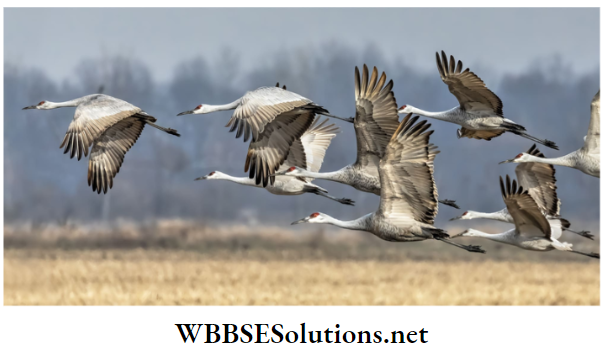
Chapter 11 Habits And Habitats Of Some Important Animals Crow
Crows are black birds known for their intelligence and adaptability and for their loud, harsh “Kaw”.
The house crow (Corvus spleens), also known as the Indian crow, is a common bird of the crow family that is of Asian origin but is now found in many parts of the world.
The genus Corvus comprises crows, ravens and rooks. There are about 40 species of crow of different sizes. Crows differ from common ravens in several ways.
Ravens are bigger; their voice is hoarser; and they have heavier bills. Crows generally make the “Kaw” sound in discrete units. A loud Kaw followed by a series of short “Kaws”.
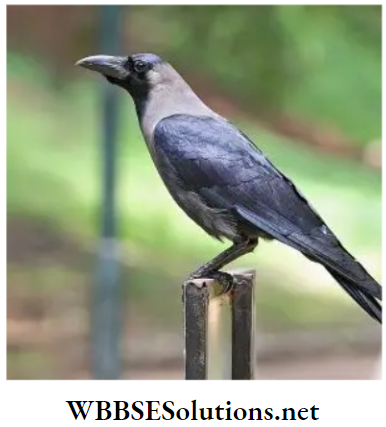
A raven has a deeper and less piercing sound. Their calls may sound like “Croooaaak”. Rooks are found across Europe and western Asia. They too, prefer wide open spaces, river plains and steppes.
Crows are extremely intelligent birds. They are known for their problem-solving skills and amazing communication skills.
For example, when a crow encounters a mean human, it will teach other crows how to identify the human. In fact, research shows that crows don’t forget a face.
Recent research has found some crow species capable of not only tool use but also tool construction.
Crows are now considered to be among the world’s most intelligent animals with intelligence equal to that of many non-human primates.
Many types of crows are solitary, but they will often forage in groups. Others stay in large groups.
Crows are omnivores, which means they eat nearly anything.
Crows eat small animals such as mammals, amphibians, reptiles, eggs and carrion. They also eat insects, seeds, grains, nuts, fruit, non-insect arthropods, molluscs, worms and even other birds.
Crows have also been noted eating garbage and storing food in caches, short-term, in trees or on the ground.
Crows are cooperative breeders, which means they often stay close to the place where they were born and help raise and defend the area’s young chicks.
When it is time to have offspring, a mating pair will build a nest 15 to 60 feet (4.5 to 18 metres) above the ground using branches.
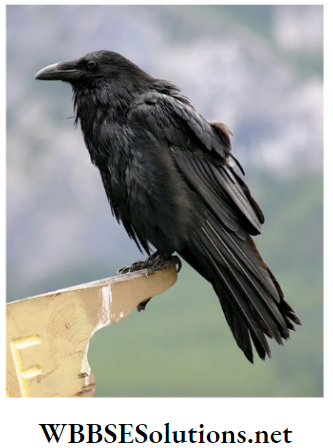
Chapter 11 Habits And Habitats Of Some Important Animals Mosquitoes
Mosquitoes are small insects. The word “mosquito” is derived from Spanish for “little fly”.
Thousands of species feed on the blood of various kinds of hosts, mainly vertebrates, including mammals, birds, reptiles, amphibians, and even some kinds of fish.
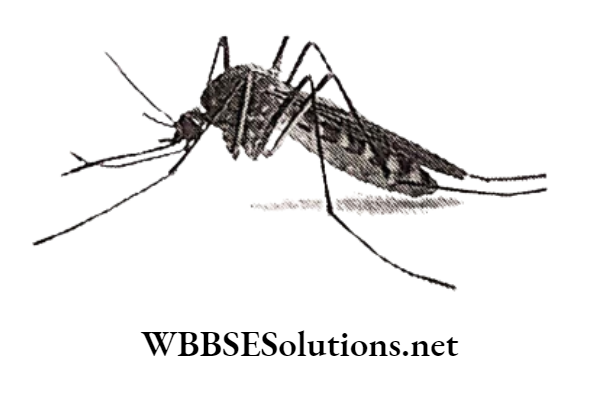
Both males and females feed mainly on fruit and plant nectar, but the female also needs the protein in her blood to help her eggs develop.
Once she’s had her fill of blood, she’ll rest for a couple of days before laying her eggs. The females “bite” with a long, pointed mouthpart called a proboscis.
They use the serrated proboscis to pierce the skin and locate a capillary, then draw blood through one of two tubes.
They also have a head, thorax and abdomen. On the head, there are two large compound eyes, two ocelli (simple eyes), two antennae and a proboscis.
Two large, scaled wings sprout from the thorax. twigs, hair, twine, bark, plant fibres, mosses, cloth and other materials.
Crows and ravens are important in mythology, fables and native cultures. They are often identified as clever tricksters.
In some cultures, they are symbols of good luck; in others, they bring bad luck. A group of crows is called a “murder”.
There are several different explanations for the origin of this term, mostly based on old folk tales and superstitions.
Many view the appearance of crows as an omen of death because ravens and crows are scavengers and are generally associated with dead bodies, battlefields, and cemeteries and they are thought to circle in large numbers above sites where animals or people are expected to die soon.
According to the International Union for Conservation of Nature (IUCN), most crows are not endangered.
Though the loss of blood is seldom of any importance to the victim, the saliva of the mosquito often causes an irritating rash that is a serious nuisance.
Much more serious though, are the roles of many species of mosquitoes as vectors of diseases.
In passing from host to host, some transmit extremely harmful infections such as malaria, yellow fever, Chikungunya, dengue fever, filariasis, Zika virus, etc. rendering it the deadliest animal family in the world.
Females can beat their wings up to 500 times per second, and the males pick out the higher frequency of those beats when seeking a mate.
Most mosquitoes can fly no more than about one to three miles and often stay within several hundred feet of where they were hatched.
They have receptors on their antennae that detect the carbon dioxide released when we exhale. Those plumes of CO, rise into the air, acting as trails that the mosquitoes follow to find the source.
Our skin produces several chemical odours, and some of them are like dinner to mosquitoes. There are more than 2,700 species of mosquitoes in the world. Of these genera, most mosquitoes belong to three
1. Aedes:
Aedes mosquitoes have abdomens with pointed tips. They include such species as the yellow-fever mosquito and the Asian tiger mosquito.
Adults of this mosquito have black bodies with conspicuous white stripes. They Coopersistently bite mammals (especially humans), mainly at dawn and in the early evening.
Their bites are painful. They b spread “Yellow fever”, Encephalitis, Si Dengue fever, etc.
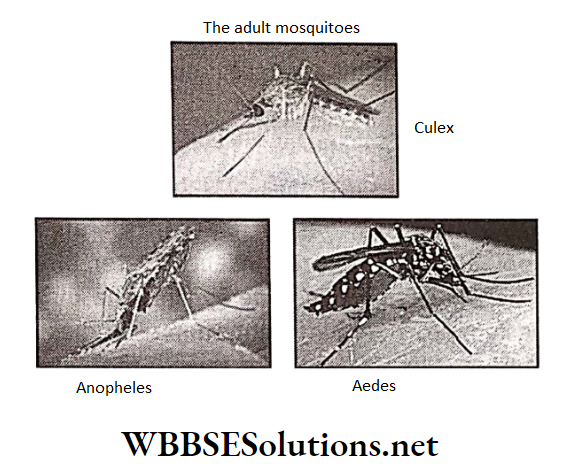
2. Anopheles:
These tend to breed in bodies of permanent fresh water. Anopheles mosquitoes also have abdomens with no pointed tips.
They include several species, such as the common malaria mosquito that can spread malaria to humans.
3. Culex:
These tend to breed in quiet, standing water. Culex mosquitoes have an abdomen with blunt tips. They are weak fliers and tend to live for only a few weeks during the summer months.
They persistently bite (preferring birds over humans) and attack at dawn or after dusk. Their bite is painful. Culex causes filariasis, bird malaria, encephalitis, and dengue.
Sound is produced due to the flapping of the wings of mosquitoes. Smaller mosquitoes produce more sound.
Like all insects, mosquitoes hatch from eggs and go through several stages in their life cycle before becoming adults.
The female lay their eggs in water, and the larva and pupa stages live entirely in water. When the pupa changes into adults, they leave the water and The adult mosquitoes become free-flying land insects.
Egg:
All mosquitoes lay eggs in water, which can include large bodies of water, standing water (like swimming pools) or areas of collected standing water (like tree holes or gutters).
Females lay their eggs on the surface of the water, except for Aedes mosquitoes, which lay their eggs above water in protected areas that eventually.
flood. The eggs can be laid singly or as a group that forms a floating raft of mosquito eggs.
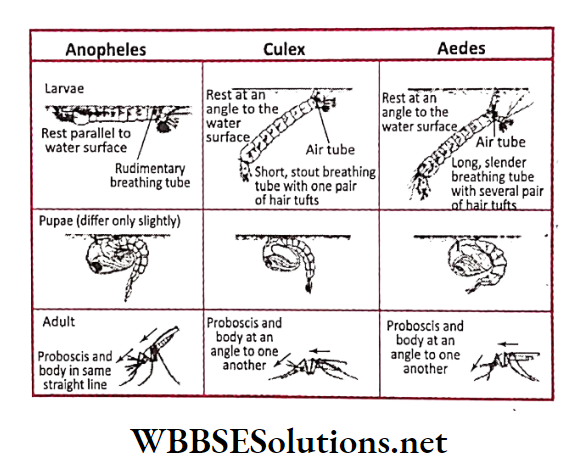
Larva:
The mosquito eggs hatch into larvae or “wigglers”, which live at the surface of the water and breathe through an air tube or siphon.
As they grow, they shed their skin (moult) several times. Mosquito larvae can swim and dive down from the surface when disturbed.
Pupae:
After the fourth moult, mosquito larvae change into pupae, or “tumblers”, which live in the water anywhere from one to four days depending on the water temperature and species.
The pupae float at the surface and breathe through two small tubes (trumpets). At the end of the pupal stage, the pupae encase themselves and transform into adult mosquitoes.
Adult:
Inside the pupal case, the pupae transform into an adult.
The adult uses air pressure to break the pupal case open, crawls to a protected area and rests while its external skeleton hardens, spreading its wings out to dry. Once this is complete, it can fly away and live on the land.
Identifying larvae:
We can distinguish the larvae of various species of mosquito. Anopheles larvae lie parallel to the surface. of the water, while larvae of Aedes and Culex extend down into the water.
Mosquito Control Methods:
Insecticides can be used to help control mosquitoes. Some products are designed to be applied directly to water to control mosquito larvae, while others are used more broadly to control adult mosquitoes.
- There are steps you can take to reduce mosquito populations without using insecticides. Here are some tips to consider when trying to avoid mosquito bites:
- Empty water from containers such as flower pots, birdbaths, pet water dishes, cans, gutters, tires and buckets regularly to disrupt the mosquito breeding cycle.
- Keep windows and door screens in good working order to prevent mosquitoes from entering your home.
- If possible, wear long-sleeved shirts and long pants while outdoors, consider staying indoors early in the morning and evening when mosquitoes are most active. Consider using an insect repellent.
Chapter 11 Habits And Habitats Of Some Important Animals Fish
A fish is an animal which lives and breathes in water. All fishes are vertebrates (have a backbone) and most breathe through gills and have scales.
Fish make up about half of all known vertebrate species. Fish have been on the earth for more than 500 million years.
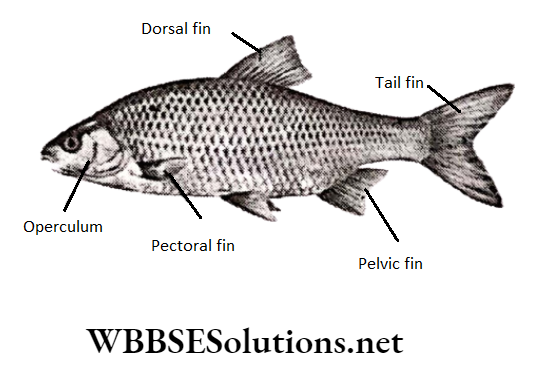
Fish were well established long before dinosaurs roamed the earth. There are three classes of fish: jawless, cartilaginous, and bony.
Fish are cold blooded, which means their internal body temperature changes as the surrounding temperature changes. 40% of all fish species inhabit fresh water.
Some fish like sharks don’t possess an air bladder to help keep them afloat and must either swim continually or rest on the bottom.
Some species of fish can fly (glide), others can skip along the surface and others can even climb rock.
Fish have a specialized sense organ called the lateral line which works much like radar and helps them navigate in dark or murky water.
Fish have excellent senses of sight, touch, and taste and many possess a good sense of smell and ‘hearing’. Fish feel pain and suffer stress just like mammals and birds.
Fish eat other fish, fish eggs, molluscs, aquatic plants, algae, zooplankton, terrestrial insects, water birds, turtles, frogs, etc.
In some species the males and females have different shaped bodies or different colouring; in other species, there is no visible difference. A person who studies fish is called an ichthyologist.
All fish have gills that allow them to breathe underwater. Just like we use our lungs to exchange oxygen for carbon dioxide from the air, the gills of a fish perform a similar function to water.
So fish still need oxygen to live, they just get it from the water instead of the air. Fish live in nearly every large body of water in the world including streams, rivers, ponds, lakes, and oceans.
Some fish live on the surface of the water and some live in the very depths of the ocean. There are fish that live in fresh water and others that live in salt water.
The reproduction of a species has to assure the survival of the species. Spawning occurs when the moment is the best for the survival of the fry, abundant food, shelter etc.
After spawning occurs, the eggs may be left or abandoned, or there may be some degree of parental care provided for by the male and/or female.
Parental care is not the rule in fish. Most species are quite content to abandon their offspring to the vagaries of a world populated by organisms that are fond of eating nutritious little snakes such as eggs and fry.
Though they may form a minority, parental species are nevertheless very diverse. They belong to many different families, marine as well as freshwater.
About 80% of these families are represented by species that care only for eggs.
These fishes prepare or build nests, sometimes nothing more than a cleaned rock, sometimes an amalgamation of vegetal matter, empty shells, pebbles, sand, or even air bubbles.
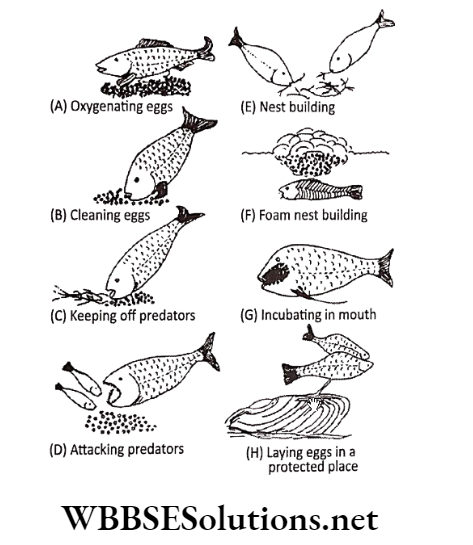
Parents also tirelessly fan the eggs-moving water over the brood with movements of their fins to provide them with a good supply of oxygen.
In addition, they clean the eggs by brushing them with their fins. With their mouth, they remove dead or diseased eggs. Some transfer mucus onto their eggs which has anti-microbial properties.
If the nest is in the intertidal zone, parents cover the egg batch with algae just before low tide, preventing desiccation.
Many species carry eggs with them so that if a big predator makes an entry onto the scene, the parents can flee and bring the brood with them.
The eggs are carried outside or inside the body.
Examples of outside carriers include medakas (eggs stuck to the female’s vent for a few hours), bagrid and banjo catfishes (eggs embedded on the surface of the belly) and sucker-mouth armoured catfishes (eggs attached to the male’s lower lip).
Inside- carriers include the numerous species of mouth-brooding cichlids (Cichlids are popular freshwater fish kept in the home aquarium), sea catfishes, and lumpfishes.
Cardinalfishes and gouramis (eggs carried inside the mouth, and regularly churned in there for proper cleaning and oxygenation), many seahorses and pipefishes (eggs developing inside a special ventral pouch on the male).
Seahorses are monogamous. The males incubate the eggs that are received from the female. Females do not play any parental care after mating.
Fertilization and incubation of oocytes received from females take place in a sac-like brood pouch located under the tail.
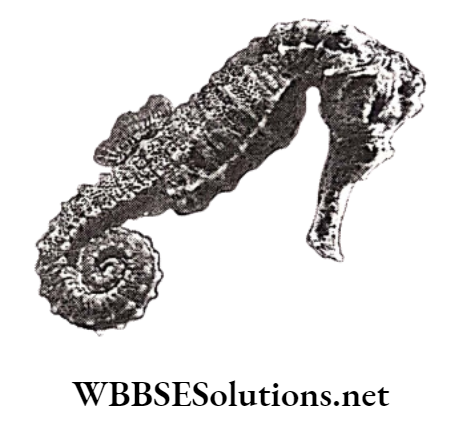
In most mouthbrooders (those species that carry eggs and fry within their mouth), only one parent provides care.
When all bony fishes are considered as a group, female-only care is the rarest form of parental involvement. The most common form is male-only care.
In such species, males aggressively stake out territories, prepare a spawning site, and court passing females.
Chapter 11 Habits And Habitats Of Some Important Animals Snakes
Snakes belong to the animal class of reptiles. This group also includes crocodiles, lizards, and turtles.
Reptiles are cold-blooded animals that raise their body temperature by lying in the sun or lowering it by crawling into the shade.
Their body temperature changes to the temperature of their surroundings. Because of this, snakes that live in colder climates must hibernate through the winter.
They will find burrows or caves and fall into a deep sleep until the weather becomes warm enough for them.
They constitute approximately 10 per cent of the total snake species found in the world and 80% of them are non-poisonous.
The venomous snakes include only about 58 species and there are only 4 species of snakes that are dangerous to man namely, Cobra, Krait, Russell’s viper and Saw-scaled viper.
Many species of snakes have skulls with several more joints enabling them to swallow prey much larger than their heads with their highly mobile jaws.
To accommodate their narrow bodies, snakes’ paired organs (such as kidneys) appear one in front of the other instead of side by side, and most have only one functional lung.
Living snakes are found on every continent except Antarctica, and on most smaller land masses exceptions include some large islands such as Ireland, Iceland, Greenland and the islands of New Zealand, and many small islands of the Atlantic and Central Pacific.
Additionally, sea snakes are widespread throughout the Indian Ocean and the Pacific Ocean.
All snakes are strictly carnivorous, eating small animals including lizards, frogs, other snakes, small mammals, birds, eggs, fish, snails or insects.
As snakes cannot bite or tear their food to pieces, they must swallow prey whole. Snakes do not ordinarily prey on humans.
Unless startled or injured, most snakes prefer to avoid contact and will not attack humans. Most species are non-venomous and those that have venom use it primarily to kill and subdue prey rather than for self-defence.
Some possess venom potent enough to cause painful injury or death to humans. Non-venomous snakes either swallow prey alive or kill by constriction.
Snakes use smell to track their prey. They smell by using their forked tongues to collect airborne particles, then passing them to Jacobson’s organ in the mouth for examination.
The fork in the tongue gives snakes a sort of directional sense of smell and taste simultaneously.
They keep their tongue constantly in motion, sampling particles from the air, ground, and water, analyzing the chemicals found and determining the presence of prey or predators in the local environment.
Snake vision varies greatly, from only being able to distinguish light from dark to keen eyesight, but the main trend is that their vision is adequate although not sharp, and allows them to track movements.
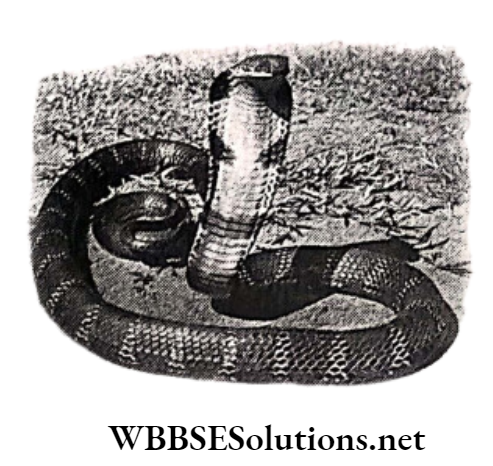
The part of the body in direct contact with the ground is very sensitive to vibration; thus a snake can sense other animals approaching by detecting faint vibrations in the air and on the ground.
The skin of a snake is covered in scales. Most snakes use specialized belly scales to travel, gripping surfaces.
The shedding of scales is called ecdysis (or in normal usage, moulting or sloughing). In the case of snakes, the complete outer layer of skin is shed in one layer.
Moulting occurs periodically throughout the snake’s life. Most snakes lay eggs. But snakes like Chandrabora and Metuli directly give birth to young ones.
Cobras, vipers and closely related species use venom to immobilize or kill their prey. The venom is modified saliva, delivered through fangs.
The term “poisonous snake” is mostly incorrect. Poison is inhaled or ingested, whereas venom is injected. Some poisons affect the nervous system while some affect the blood circulatory system.
Snake venoms are complex mixtures of proteins, and are stored in venom glands at the back of the head.
All snakes may be venomous to a certain degree, with harmless snakes having weak venom and no fangs. The treatment for snake bite is as variable as the bite itself.
The most common and effective method is through antivenom, a serum made from the venom of the snake.
In some parts of the world, especially in India, snake charming is a roadside show performed by a charmer.
In such a show, the snake charmer carries a basket that contains a snake that he seemingly charms by playing tunes from his flute-like musical instrument, to which the snake responds.
Snakes lack external ears, though they do have internal ears, and respond to the movement of the flute, not the actual noise.
The Wildlife Protection Act of 1972 in India technically proscribes snake charming on the grounds of reducing animal cruelty.
No matter how you feel about snakes, they play an important role.
All snakes are carnivores and most of them eat rodents, such as mice, rabbits and rats. Rodents eat human food and crops. They also carry diseases.
Snakes keep rodent populations under control. Without their help, rodents would over-run the earth.
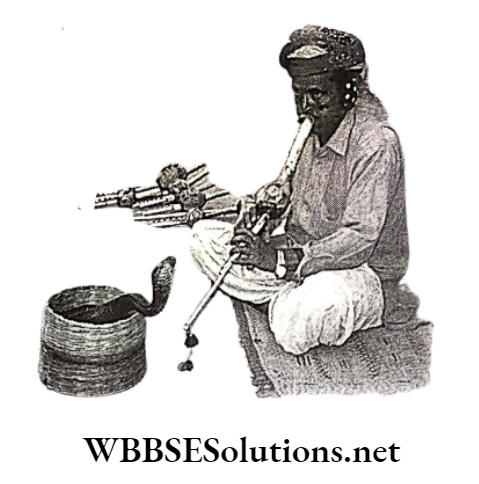
Chapter 11 Habits And Habitats Of Some Important Animals Tiger
The Tiger (Panthera tigris) is the largest cat species, most recognisable for their pattern of dark vertical stripes on reddish-orange fur with a lighter underside.
Tigers have muscular bodies with powerful forelimbs, large heads and long tails.
The fur is dense and heavy; colouration varies between shades of orange and brown with white ventral areas and distinctive vertical black stripes, whose patterns are unique to each individual.
Their function is likely for camouflage in vegetation such as long grass with strong vertical patterns of light and shade.
They have a mane-like heavy growth of fur around the neck and jaws and long whiskers, especially in males. The pupils are circular with yellow irises.
The small, rounded ears have a prominent white spot on the back, surrounded by black.
A Tiger’s canine teeth can grow up to three inches long and are easily capable of crunching through the spine of any creature on Earth.
White tigers, this recessive colour variant is found only in the Bengal subspecies and with regular stripes and blue eyes. It is not albinism.
They appear on many flags, and coats of arms, and as mascots for sporting teams. The tiger is the national animal of India, Bangladesh, Vietnam, Malaysia and South Korea.
Adult tigers lead largely solitary lives. They establish and maintain territories but have much wider home ranges within which they roam.
Resident adults of either sex generally confine their movements to their home ranges, within which they satisfy their needs and those of their growing cubs.
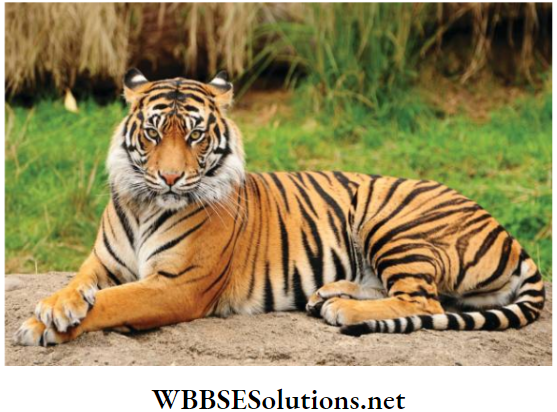
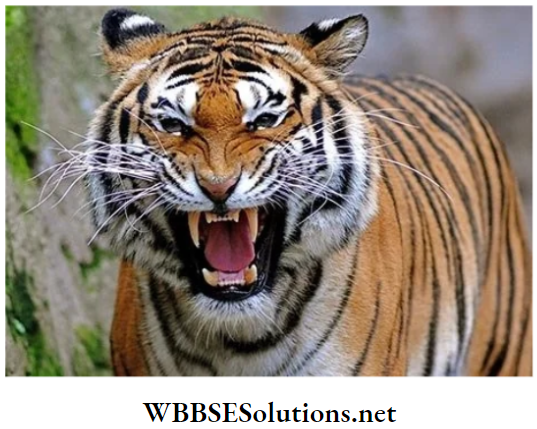
Individuals sharing the same area are aware of each other’s movements and activities. The size of the home range mainly depends on prey abundance, and in the case of males, on access to females.
Tigers are strong swimmers and often deliberately bathe in ponds, lakes and rivers as a means of keeping cool in the heat of the day. They are able to carry prey through or capture it in the water.
To identify his territory, the male marks trees by spraying urine and anal gland secretions, as well as marking trails with faeces and marking to typically absent, they have been observed via remote-controlled hidden cameras.
They generally hunt alone and ambush their prey as most other cats do, overpowering them from any angle, using their body size and strength to knock the prey off balance.
After killing their prey, tigers sometimes drag it to conceal it in vegetative cover, usually pulling it by grasping with their mouths at the site of the killing bite.
This too, can require great physical strength. zieminA transom trees or the ground with their claws. Females also use these “scrapes”, as well as urine and scat markings.
Scent markings of this type allow an individual to pick up information on another’s identity, sex and reproductive status.
Roar is produced in a variety of situations such as taking down large prey, signalling sexual receptivity and females calling to their young. These roars may be heard from distances over 3 km.
Male tigers are generally more important to other males within their territories than females are of other females.
Territory disputes are usually solved by displays of intimidation rather than outright aggression.
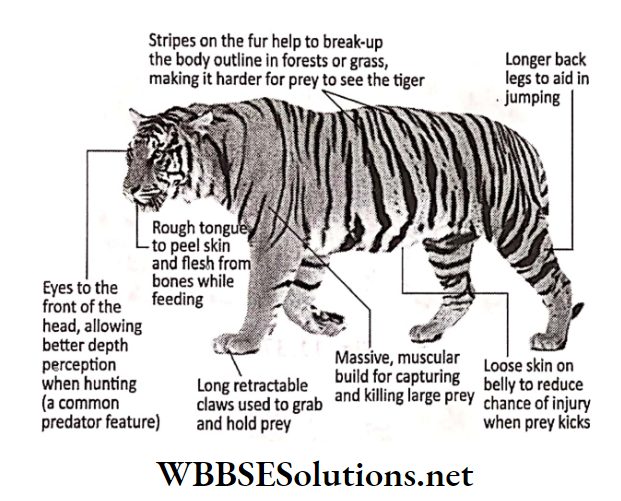
In the wild, tigers mostly feed on large and medium-sized animals, preferring native ungulates weighing at least 90 kg. They typically have little or no deleterious effect on their prey populations.
Sambar deer, chital, barasingha, wild boar, gaur, nilgai and both water buffalo and domestic buffalo, etc. are the tiger’s favoured prey in India.
They also prey on other predators, including dogs, leopards, pythons, sloth bears and crocodiles.
Tigers generally do not prey on fully grown adult Asian elephants and Indian rhinoceros but incidents have been reported.
Old or wounded tigers, unable to catch wild prey, can become man-eaters; this pattern has recurred frequently across India.
An exception is in the Sundarbans, where healthy tigers prey upon fishermen and villagers in search of forest produce, humans thereby forming a minor part of the tiger’s diet.
Tigers are thought to be mainly nocturnal predators, but in areas where humans are Tigers make extensive use of their vision for everyday functions and applications (in much the same way as human beings), particularly for hunting during the darkness of night or the limited visibility of dusk or storms.
Tigers hunt mainly during the evening and night times when the vision of their prey is compromised. For this reason, their nighttime vision is excellent; about six times better than that of humans.
There are several adaptations within the actual eye that allow for this. It has a wide, rounded pupil that allows maximum light to enter into the eye, when necessary.
The tiger’s retinas comprise mainly rod receptors, which are cells that are sensitive to low light levels and can perceive very slight movements.
There are some cone cells (colour receptors) in each eye, but these are used more for day vision, and not to perceive a range of different colours.
In fact, it is thought that some tigers only see dull greens, blues and reds, while others see in black and white.
The tapetum lucidum is a layered, mirror-like structure behind the retina that reflects light back into the eyes for a second time so that the eye and brain can form a brighter image of it.
The eyes of the tiger are situated on the front of its head, and not on the sides. This helps with three-dimensional perception and depth perception since both eyes look ahead.
Mating can occur all year round but is more common between November and April. A female is only receptive for three to six days. Mating is frequent and noisy during that time.
The litter is usually two or three cubs, occasionally as few as one or as many as six. Cubs are born blind and helpless.
The females rear them alone, with the birth site and maternal den in a sheltered location such as a thicket, cave or rocky crevice. The male generally takes no part in rearing them.
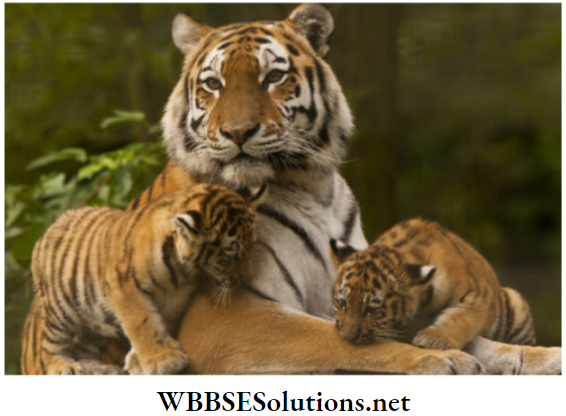
First tigress hunts and gives pieces of meat to the cubs. The tigers teach them to eat the meat by showing them how to tear it with their teeth.
She also teaches them to swim. After training from the mother for six or seven months, the tigers finally become adults.
The tiger is an endangered species. Poaching for fur and body parts and the destruction of habitat have simultaneously greatly reduced tiger populations in the wild.
At the start of the 20th century, it is estimated there were over 100,000 tigers in the wild, but the population has dwindled outside of captivity to between 1,500 and 3,500.
India is home to the world’s largest population of wild tigers. In 1973, India’s Project Tiger established over 25 tiger reserves in reclaimed land, where human development was forbidden.
Tigers occupy a variety of habitats from tropical forests, evergreen forests, woodlands and mangrove swamps to grasslands, savannah and rocky country.
Tigers do not actually live in Africa; they live in Asia. Tigers are seated at the top of the food chain predators maintaining the ecological balance of populations by keeping prey populations in check.
When a tiger has eaten its prey, the abandoned prey becomes the food for a variety of mammals, birds and reptiles.
Some cultures believe that powdered tiger bones have medicinal value. Unfortunately, tigers are highly in demand to supply this damaging market.
Chapter 11 Habits And Habitats Of Some Important Animals Whale
Whales are the common name for a widely distributed and diverse group of fully aquatic placental marine mammals.
Whales, dolphins and porpoises are the closest living relatives of the hippopotamuses, having diverged about 40 million years ago.
Whales are creatures of the open ocean; they feed, mate, give birth, suckle and raise their young at sea.
So extreme is their adaptation to life underwater that they are unable to survive on land.
Whales range in size from 2.6 metres (8.5 ft) and 135 kilograms dwarf sperm whales to 34 metres (112 ft) and 190 metric tons blue whales, which is the largest creature that has ever lived.
The sperm whale is the largest-toothed predator on Earth.
Whales have torpedo-shaped bodies with non-flexible necks, limbs modified into flippers, non-existent external ear flaps, a large tail fin, and flat heads.
Whale skulls have small eye orbits, long snouts and eyes placed on the sides of its head.
Several species exhibit sexual dimorphism, in that the females are larger than males. One exception is the sperm whale, which has males larger than the females.
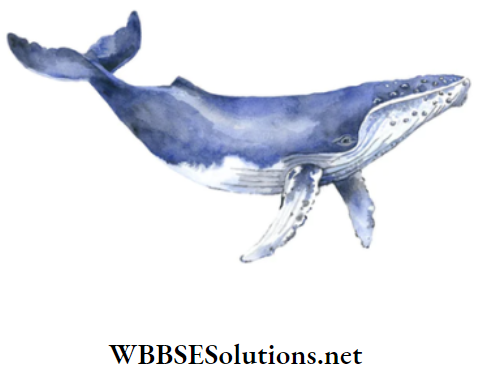
Baleen whales have no teeth; instead, they have plates of baleen, a fringe-like structure used to expel water while retaining the krill and plankton which they feed on.
Baleen whales have heads that can make up 40% of their body mass to take in water. Toothed whales, on the other hand, have conical teeth designed for catching fish or squid.
Baleen whales have a well-developed sense of “smell”, whereas toothed whales have well-developed hearing- their hearing, which is adapted for both air and water is so well developed that some can survive even if they are blind.
Some species, such as sperm whales, are well adapted for diving to great depths to catch squid and other favoured prey. All whales are carnivorous and predatory.
Usually, whales hunt solitarily, but they do sometimes hunt co-operatively in small groups. Whales have evolved from land-living mammals.
As such they must breathe air regularly, though they can remain submerged for long periods.
They have blowholes (modified nostrils) located on top of their heads, through which air is taken in and expelled in the form of vapour.
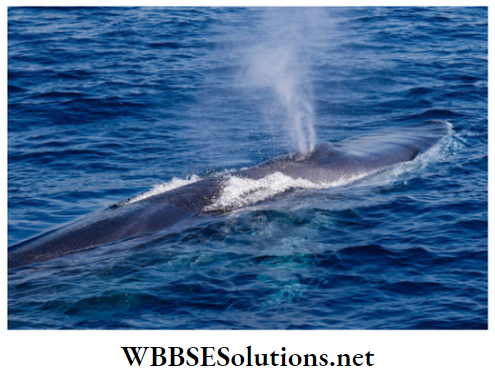
Breathing involves expelling stale air from the blowhole, forming an upward, steamy spout, followed by inhaling fresh air into the lungs; a humpback whale’s lungs can hold about 5,000 litres of air.
Whales are mammals, and as such, they have hair- though very little of it. They feed milk to their babies and breathe air.
Since whales are not fish they do not have gills, so they cannot breathe underwater. Whales have two flippers on the front and a tail fin. These flippers contain four digits.
The fusing of the neck vertebrae, while increasing stability when swimming at high speeds, decreases flexibility; whales are unable to turn their heads.
When swimming, whales rely on their tail fin that propels them through the water. Flipper movement is continuous.
Whales swim by moving their tail fin and lower body up and down, propelling themselves through vertical movement, while their flippers are mainly used for steering.
Whales are adapted for diving to great. depths. In addition to their streamlined bodies, they can slow their heart rate to conserve oxygen.
They are warm-blooded, and have a layer of fat, or blubber, under the skin. This allows them to maintain a body temperature similar to humans – 36°C (97°F), even in freezing conditions.
In species that live near the poles, the blubber can be as thick as 11 inches.
This blubber can help with buoyancy, and protection to some extent as predators would have a hard time getting through a thick layer of fat, and energy for fasting when migrating to the equator; the primary usage for blubber is insulation from the harsh climate.
With streamlined fusiform bodies and two limbs that are modified into flippers, whales can travel at a speed up to 37 km in an hour.
Whales produce a great variety of vocalizations, notably the extended songs of the humpback whale. Whale vocalization is likely to serve several purposes.
Some species, such as the humpback whale, communicate using melodic sounds, known as whale songs. These sounds may be extremely loud, depending on the species.
Captive whales have occasionally been known to mimic human speech. Whales are not thought to have a good sense of taste and smell. Whales are known to teach, learn, cooperate, scheme, and grieve.
Although whales are widespread, most species prefer the colder waters of the Northern and Southern hemispheres and migrate to the equator to give birth.
Species such as humpbacks and blue whales are capable of travelling thousands of miles without feeding.
Calves are typically born in the spring and summer months and females bear all the responsibility for raising them. Mothers of some species fast and nurse their young for a relatively long period of time.
The whale eye is relatively small for its size, yet they do retain a good degree of eyesight.
As well as this, the eyes of a whale are placed on the sides of its head, so its vision consists of two fields, rather than a binocular view like humans have.
Most whales have slightly flattened eyeballs, enlarged pupils, slightly flattened corneas and a tapetum lucidum these adaptations allow for large amounts of light to pass through the eye and therefore, a very clear image of the surrounding area.
In water, a whale can see around 10.7 metres (35 ft) ahead of itself.
Scientists have determined that killer whales can live a maximum of 35 years. They can tell the age of a whale by looking at a cross-section of a killer whale’s tooth.
Unlike most animals, whales are conscious breathers. All mammals sleep, but whales cannot afford to become unconscious for long because they may drown.
Another interesting feature of whales is that whales are known to give birth to their children much like humans do.
The female whale goes through a pregnancy period that can last anywhere from 10 months all the way up to 17 months depending on the species.
Once relentlessly hunted for their products, whales are now protected by international law.
WBBSE Notes For Class 6 School Science Chapter 10 Biodiversity And Its Classification
Chapter 10 Biodiversity And Its Classification Introduction
The life forms originated on this Earth around 3.5 billion years ago from a simple unicellular bacteria-like organism from the water, but it gradually flourished with time, and at present, there are more than 3 crore life forms in this world.
Thus it is clear that living organisms are characterized by diversity.
Biodiversity (or Biological diversity) is defined as the variability among living organisms from all sources including terrestrial, marine, and other aquatic ecosystems and the ecological complexes of which they are part.
It includes genetic diversity, species diversity, and ecosystem diversity which together affect the complex ecological processes operating at different levels.
Read And Learn More: WBBSE Notes For Class 6 School Science
Amongst all the prevailing organisms in the world, the extent or degree of diversity is more in animals than in plants.
Since biodiversity plays an important role in ecosystem services, a need was felt to index, categorize and measure this complex organization.
Systematics is the study of diversity of organisms and classification is a part of the broader field of systematics.
Classification deals with the ordering or ranking of organisms into groups on the basis of similarities or closeness or relationship by listing the unique characters of each taxon (or taxonomic group which represents the real biological organisms included in a category).
Classification of organisms has come a long way from Linnaean two kingdoms to the presently accepted five-kingdom system as shown below
Chapter 10 Biodiversity And Its Classification Monera
- The unicellular prokaryotic organisms. which do not have true nuclei bound by a nuclear membrane.
- These organisms are the oldest organisms in this world.
- They can survive in extreme environmental conditions. Monera includes the following organisms.
Archebacteria:
- They are the oldest organisms in this world.
- They survive in extreme environmental conditions.
- They are anaerobic and are the ancestor of present-day organisms, for example, Methanogenic bacteria.
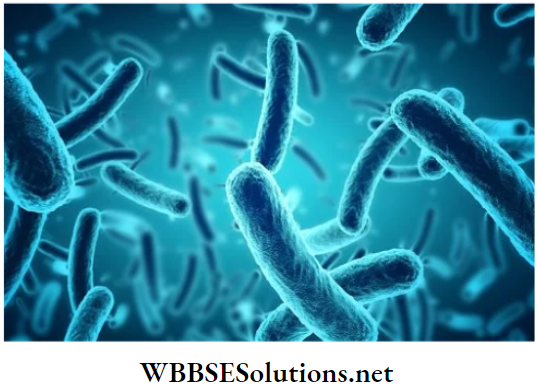
Eubacteria:
- These bacteria represent the largest group of prokaryotic organisms.
- They are classified on the basis of cell wall structure example Gram positive and Gram negative in nature.
- They are both aerobic and anaerobic in nature and can also be classified on the basis of nutrition, the presence or absence of flagella, for example, Mycobacterium, and Vibrio.
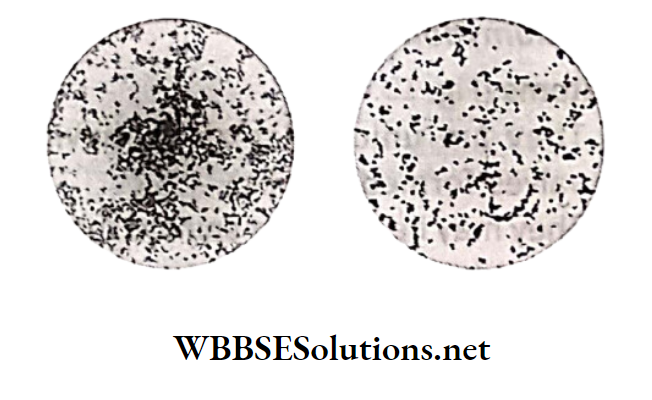
Cyanobacteria:
- They are blue-green in color due to the stun presence of unique pigments called chlorophyll-a and c-phycocyanin.
- They are without flagella, grow in water, and do not have true sexual reproduction.
- They have nitrogen-fixing ability and may be used as biofertilizers, for example Nostoc, and Anabaena.
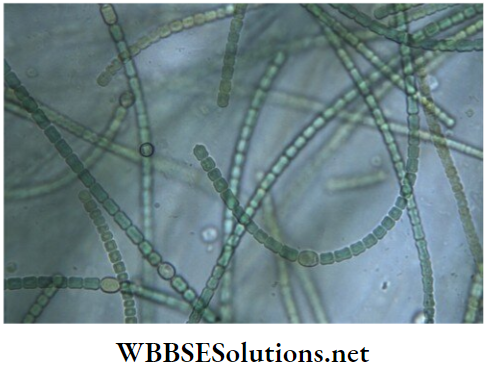
Mycoplasma :
1. They are bacteria-like organisms without any cell wall and so they are capable of slime changing their shape, also called Pleuronsdm Pneumonia Like Organisms (PPLO), for example, Mycoplasma.
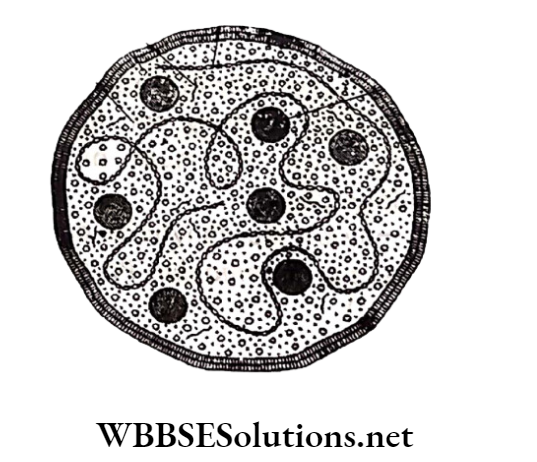
Chlamydia:
- This organism is an intermediate between viruses and living organisms.
- It does not have true cells and causes parrot fever, for example, Chlamydia.
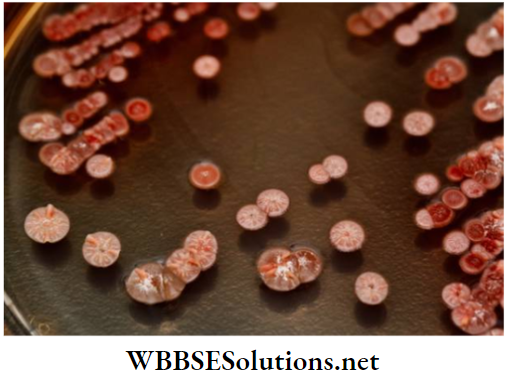
Actinomycetes:
- They are intermediate between fungi and bacteria.
- They are filamentous in nature and cut off thin-walled spores in chains.
- They are mostly soil-borne, and produce yes, antibiotics, for example, Streptomyces.
Chapter 10 Biodiversity And Its Classification Protista
This group of organisms includes unicellular eukaryotes. It may include plants, animals, and fungi. It is a mixed group and includes the following organisms:
Unicellular green algae :
- The unicellular green algae has a cellular wall and chloroplast and food remains stored in the pyrenoid.
- They may be with or without flagella, for example, Chlamydomonas.
Diatoms:
- They are unicellular algae, having two mo valves formed of silica.
- They may be round or spindle-shaped, for example, Pennularia.

Myxomycetes:
- They are intermediate between fungi and protozoa.
- They have thread-like multi-nucleate structures and may be saprophytic or parasitic in nature, e.g. Plasmodiophora.
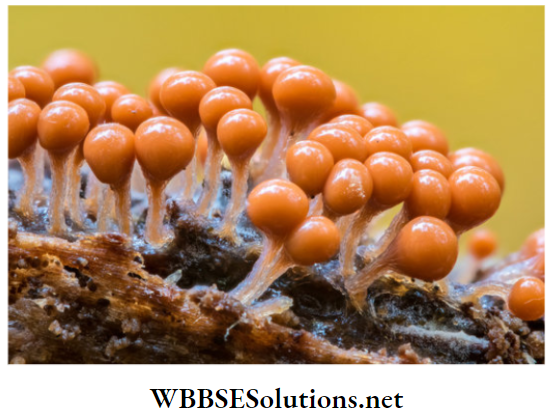
Dinoflagellates:
- They are unicellular, formed of 2 valves with a central groove, and the two flagella are arranged in such a way that they are oriented at right angles.
- They cause red tide in the sea, for example, Dinoclonium.
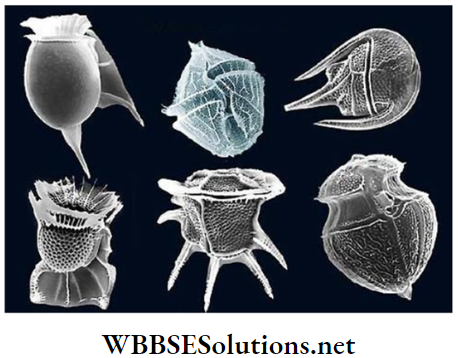
Protozoa :
- They are unicellular organisms similar to animal cells, having cell membranes, and moving with the help of cilia or pseudopodia.
- They may be saprophytic or parasitic in nature, for example, Entamoeba, and Paramoecium.
Chapter 10 Biodiversity And Its Classification Fungi
- They are unicellular or multicellular organisms without chlorophyll.
- They are capable of surviving saprophytically, parasitically, or symbiotically. The major groups are as follows
Zygomycetes:
They are filamentous organisms without septation, multinucleate, and reproduce asexually by sporangiospores and sexually by zygospores, e.g. Mucor.
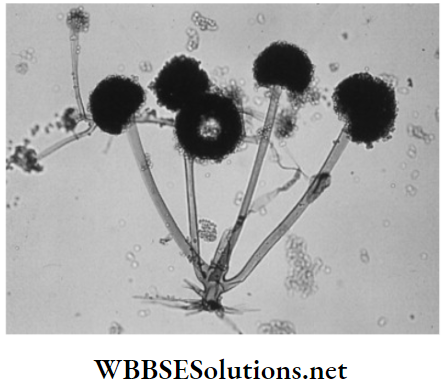
Oomycetes :
They are thalloid or unicellular in nature, ciliated in nature, and reproduce sexually by oospores and asexually by zoospores, for example, Phytophthora.
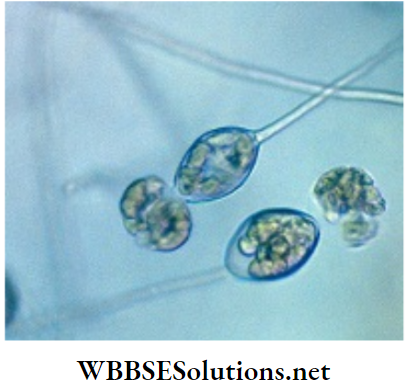
Ascomycetes:
- They are unicellular or filamentous in nature.
- They are having septate filament, which reproduces asexually by budding or fragmentation but reproduces sexually by ascus and ascospore, for example, Yeast and Penicillium.

Basidiomycetes:
1. This group of fungi is with septate mycelia and reproduces sexually by basidia and basidiospore and the mycelia join with each other producing complex structures or fruit bodies, for example, Agaricus.
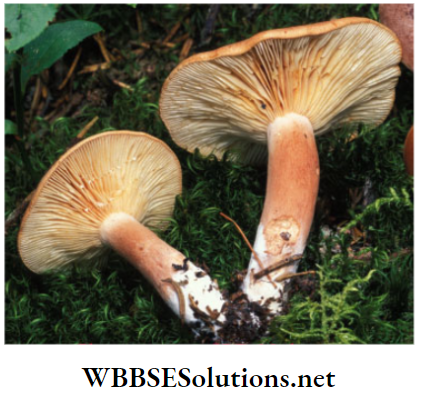
Deuteromycete:
1. They include a group of fungi without sexual reproduction, for example, Alternaria.
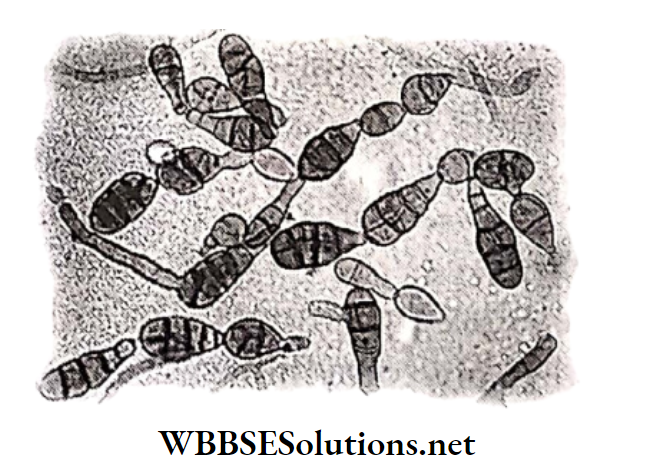
This group is very large and the major divisions are shown below:
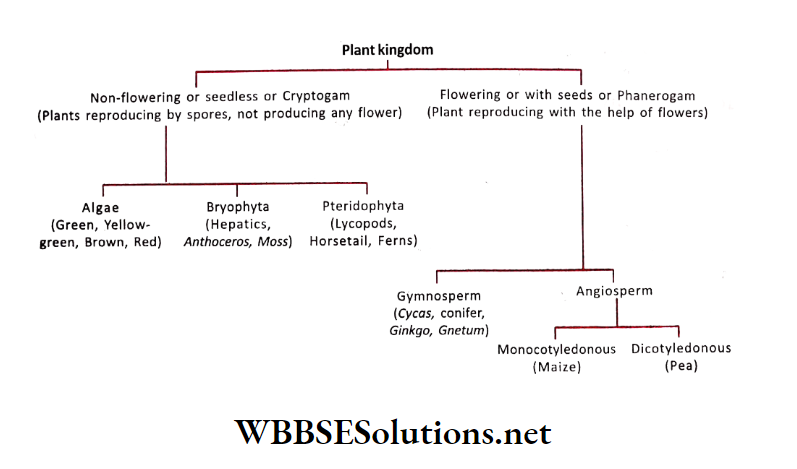
Chapter 10 Biodiversity And Its Classification Algae
1. They are aquatic plants with different types of chlorophyll pigments and other d accessory pigments.
Green Algae :
- The multicellular green algae may be colonial, filamentous, or true plant-like.
- They have chlorophyll-b with a complex structure and food is stored as carbohydrate and protein structures called Pyrenoids, for example, Spirogyra, and Chara.
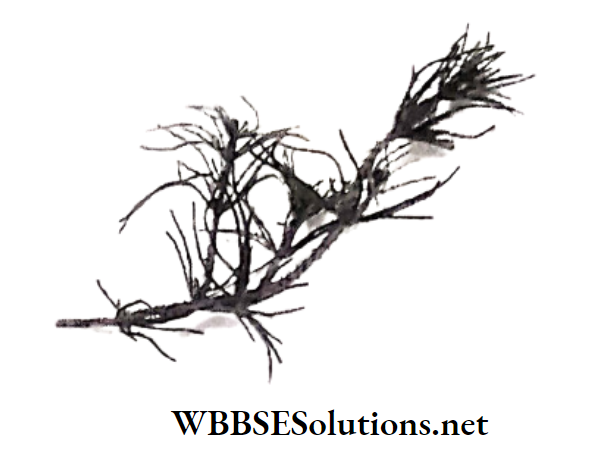
Yellow-green Algae:
The thalloid algae with green chlorophyll and yellow xanthophyll and they also store starch, Vaucheria.
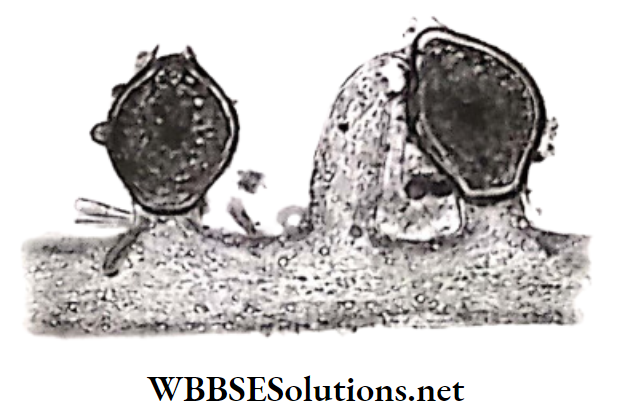
Brown Algae :
- The algae with a large plant body, well-differentiated into stems and leaves.
- They are exclusively marine.
- They have chlorophyll-c and brown pigment fucoxanthin. example Laminaria, Sargassum.
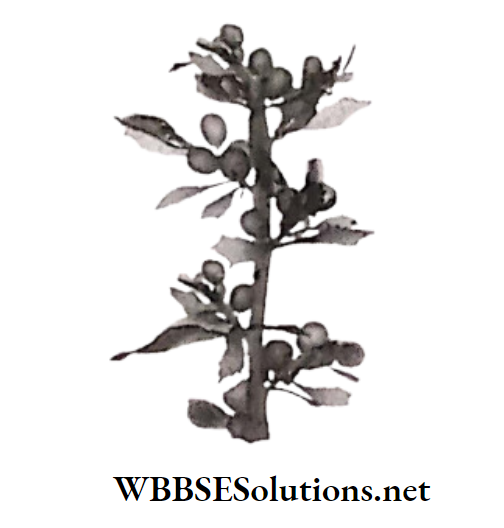
Red Algae :
- They have pigments like chlorophyll-e and r phycoerythrin.
- They are also well differentiated into root, stem, and leaves, the stem may have tubular conducting tissue.
- They may have a neutral polysaccharide as their stored food called agar, for example, Polysiphonia.
Chapter 10 Biodiversity And Its Classification Bryophytes
These plants are intermediate between terrestrial and aquatic conditions and that is why they are called amphibious plants.
Hepatics:
- These plants are thalloid in nature, growing along the surface of the soil.
- They are differentiated into basal storage zone and upper photosynthetic zone.
- They reproduce in the presence of water.
- They are so-called because the plant body looks like a liver, for example, Riccia).
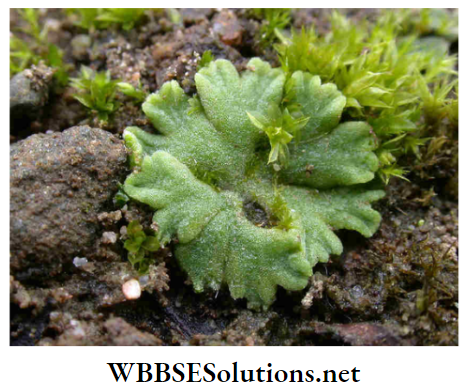
Anthocerotae :
- These plants are intermediate between sad villa thalloid and leafy structures.
- The plant body has a multi-tier and long horn-shaped spore-bearing structure called a capsule and so these plants are also called hornworts, for example, Anthoceros.
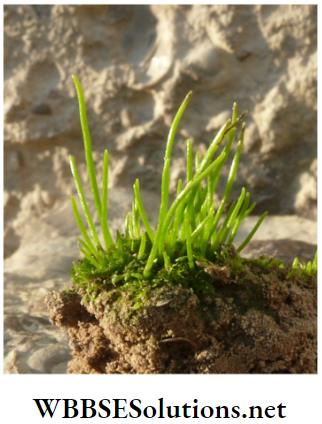
Moss :
- These plants are leafy bryophytes.
- They have well-differentiated root, stem, and leaves and a well-differentiated spore-bearing structure called a capsule.
- The spores have a specific mechanism of dispersal, for example, Pogonatum.
Chapter 10 Biodiversity And Its Classification Pteridophyte
- These plants are called vascular cryptogams because they have to conduct tissue in the form of xylem and phloem.
- They also exhibit an alternation of generational thank ann between the spore-bearing sporophyte zoom as
and the gamete-producing plant body. The major groups are as follows
Lycopods :
1. These plants have non-woody stems, scaly leaves, and cones or strobilus as their reproductive structure, for example, Lycopodium.
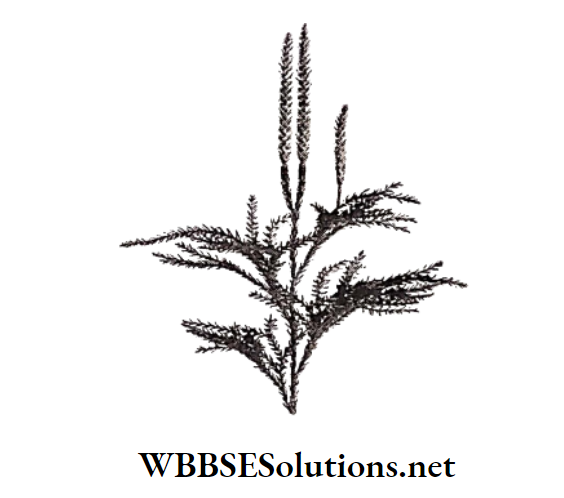
Horsetails :
- These plants are also called Sphenopsids and look like horsetails.
- They have silica in their cell wall giving mechanical support.
- The spore-bearing structure is a compact sporangiophore, for example, Equisetum.
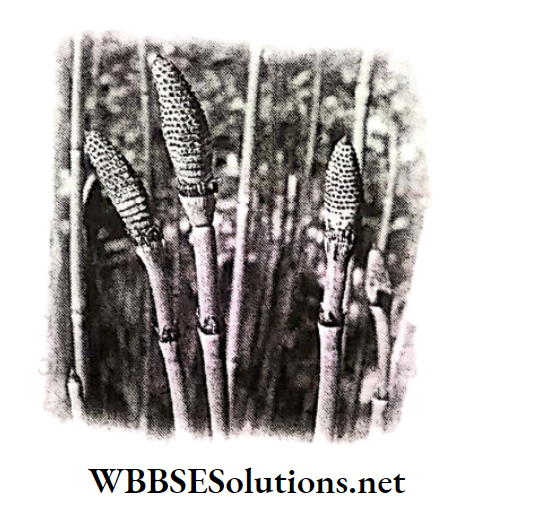
Ferns :
- They are the most developed plants among pteridophytes.
- The spore-bearing and gamete-bearing Vows plant bodies are distinctly different from each other.
- The leaves are compound in nature and they bear the spore-bearing structure or sporangia on the ventral surface of the leaf aggregated to produce the sorus.
- They are grown as ornamental plants, for example, Dryopteris.
Chapter 10 Biodiversity And Its Classification Gymnosperms
These plants are big woody trees that usually bear cones containing naked seeds. They include the following:
Cycas :
- The plant looks like a dwarf coconut tree, with a monopodial stem and apical crown of leaves.
- The roots are coralloid in nature heavily infected with blue-green algae, for example, Cycas.
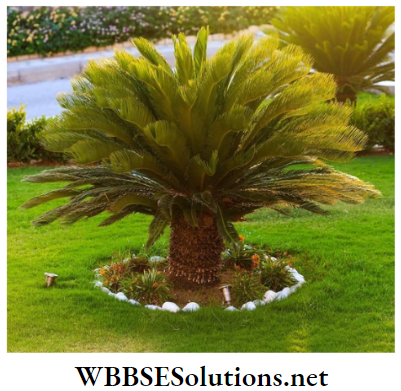
Conifer :
1. The trees are very large, the stem is woody, the leaves are spiny in nature, roots are infected with vesicular-arbuscular mycorrhizae, for example, Pinus.
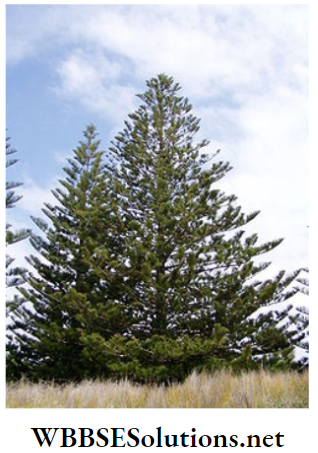
Ginkgo:
The plants are endemic to Korea and Japan, small and shrub-like, with male cones and female megasporophyll having a pair of ovules, for example, Ginkgo.
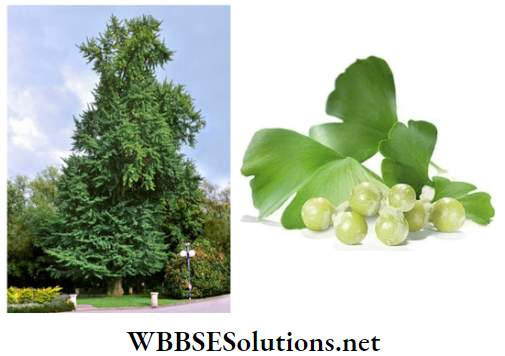
Gnetum:
- The plant is a small tree.
- It is the most developed gymnosperm, having large leaves, male and female. reproductive cupules containing stamens and ovules protected by perianth.
- They are considered intermediate. between gymnosperm and angiosperm, for example, Gnetum.
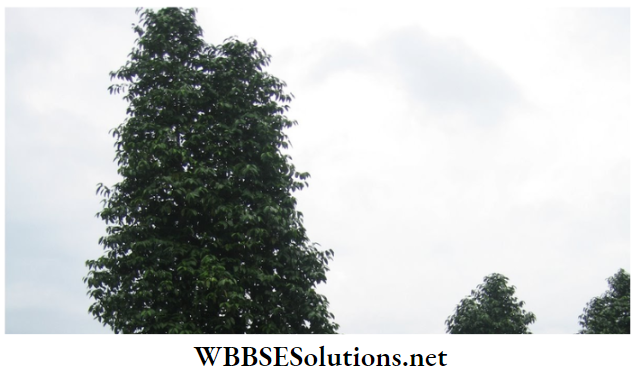
Chapter 10 Biodiversity And Its Classification Angiosperms
- They are flowering plants mainly divided into two major groups, Monocotyledonae having a single cotyledon and Dicotyledonae having 2 cotyledons.
- These plants are the largest at present in the world.
Monocotyledonous plants:
- These plants have mostly non-woody stems, sheathing leaf bases, parallel venation, and trimerous flowers.
- Single cotyledon in the seed.
- Seeds with endosperm, for example, Paddy
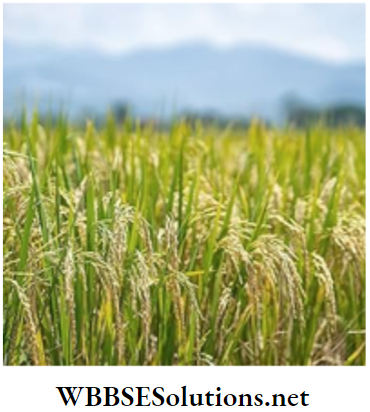
Dicotyledonous plants: These plants have:
- Woody stem with massive secondary unglad n wood.
- Distinct stalked leaves with reticulate venation.
- Pentamerous flowers.
- Seeds non-endospermic.
- Seeds with two cotyledons example Mango, Bengal gram.
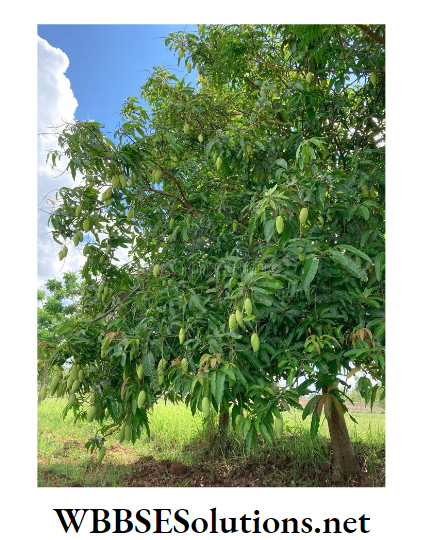
Leaf venation:
Leaf venation is the arrangement pattern of the veins on the leaf blade. Leaf venation is basically of two types.
1. Reticulate venation:
1. In this type, the veins branch and unite forming a complicated network. All the veins are interconnected, like the strands of the net. Leaves of Dicot plants generally have reticulate venation, for example, Hibiscus.

2. Parallel venation:
In this type, the veins run parallel or nearly parallel to each other and are connected by smaller veins. Leaves of Monocot plants generally have parallel venation, for example, banana, and wheat.
On the basis of nature and the size of stems, plants may be classified as Herbs, Shrubs, and Trees.
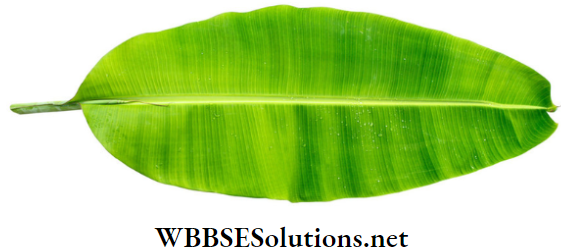
Herbs:
- The plants are short with almost no branches and soft stems.
- They are either creepers or climbers.
- They are short in height. example, Marigold.
Shrubs :
- The plants are woody but not too tall and have many branches and leaves.
- They look like bushes.
- They are of medium height, for example, china rose.
Trees:
- The plants are tall with strong stems.
- They have many branches and leaves, for example, mango.
Chapter 10 Biodiversity And Its Classification Animalia
The animal kingdom is very large with different multicellular organisms. Before going into classification, let us define and understand some terms connected with it.
1. Metazoa :
A group that comprises all animals having the body composed of cells differentiated into tissues and organs.
2. Eumetazoa :
It comprises all major animal groups except sponges and has truly organized tissues.
3. Acoelomata:
Animals have no coelom or body cavity.
4. Pseudocoelomata:
Animals have no true coelom but have a cavity in between the cuticle and visceral organs filled up with fluid.
5. Coelomata:
Animals have true coelom or body cavities lying in between the body wall and the alimentary canal.
6. Diploblastica:
Animals whose body is formed of ectoderm and endoderm cells only.
7. Triploblastica:
Animals whose body is formed of ectoderm, mesoderm, and endoderm cells.
These groups are discussed below:
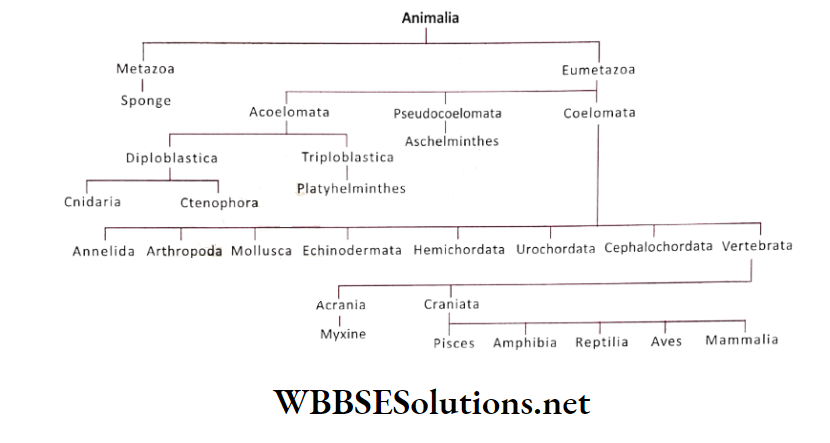
1. Invertebrate :
1. The animal has 2 layers.
Sponge:
- The animal is without the definite organization of tissues.
- They are sedentary in nature.
- The body is formed of a calcareous shell having multiple pores called ostia and an apical pore called osculum, for example, Sycon assumes.
Cnidaria:
- The animal is cylindrical in nature.
- It has two layers, ectoderm, and endoderm.
- The mouth is guarded by tentacles.
- They exhibit extracellular and intracellular digestion.
- The body consists of nematocysts, used for traping pray, for example, Hydra
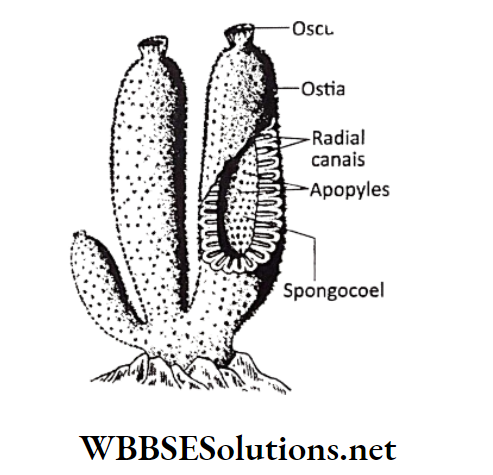
Ctenophora:
- The animal has 2 layers.
- It is marine.
- It has a locomotory organ in the form of comb plates and specialized cells for trapping prey called Suzaid business caul oblast cells, for example, Beroe.
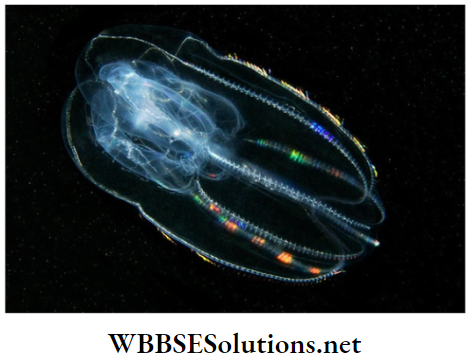
Platyhelminthes :
- The animal has a flattened body, the body is segmented.
- The animal is bisexual showing self-autumn fertilization, and survives as an endoparasite, for example, cedes to Taenia.
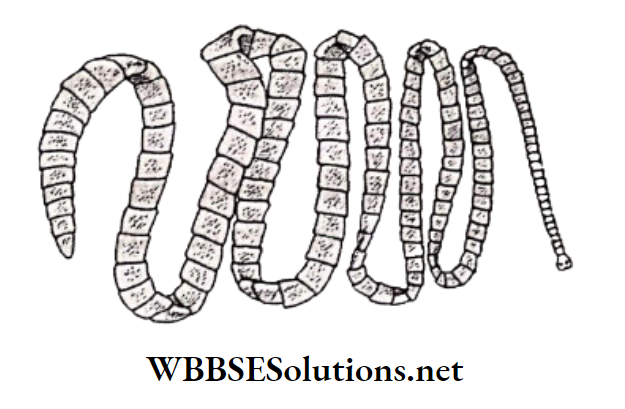
Aschelminthes :
- The animal is unisexual, having a pseudocolor.
- The female is larger than the male.
- They have a thick cuticle and survive as endoparasite, for example, Ascaris
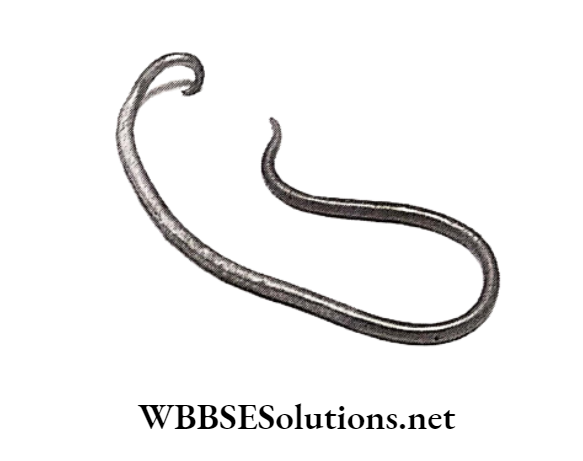
Annelida :
- The animal is cylindrical in nature, with metameric segmentation.
- The animal may have red pigment haemoglobin but it is in the plasma.
- The blood circulation is closed.
- The animal is bisexual but is not capable of showing self-fertilization, for example, Pheretima posthuma (earthworm)
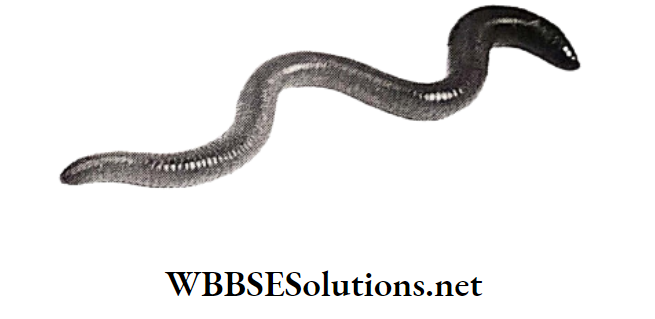
Arthropoda :
- This animal group is the largest having 4 sub-groups.
- They have open circulation with multi-chambered) sm heart.
- The sexes are different and fertilization is internal, example Periplaneta americana (cockroach)
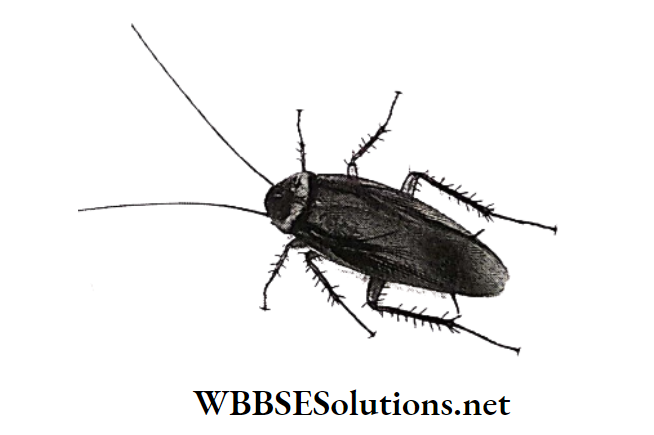
Mollusca:
- The animal has a soft body covered by the mantle and well protected calcareous shell.
- The sexes are different and are intermediate between open and closed circulation, for example, Pila
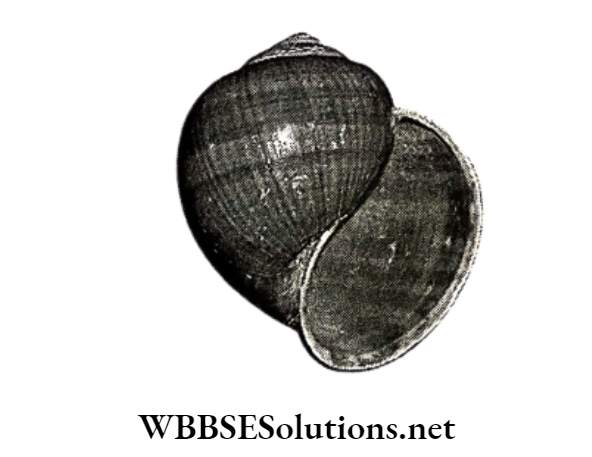
Echinodermata:
- The animal has a calcareous endoskeleton with projections.
- They have blood circulation and a water vascular system.
- They are marine and feed from the sea bed i.e. benthonic inhabit, for example, Asterias (Starfish).
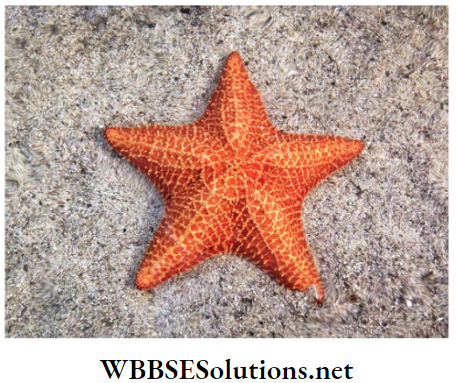
Hemichordata:
The animal is not under chordates, because they do not have notochord in the matured stage, for example, Balanoglossus.
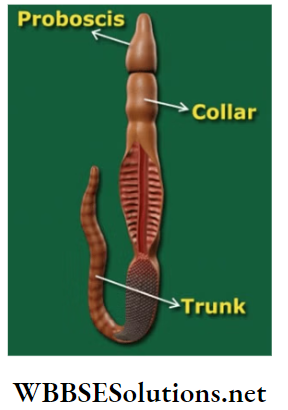
Urochordate:
- The notochord (an elastic rod-like structure situated immediately above the alimentary canal and covered by a sheath.) is limited to the tail region.
- The animal retains larval character in the adult stage and this phenomenon is called retrogressive metamorphosis example Ascidia

Cephalochordata:
- The animal has a notochord extended up to the head region.
- The animal has a tail fin and many characteristics as fish, for example, Amphioxus.
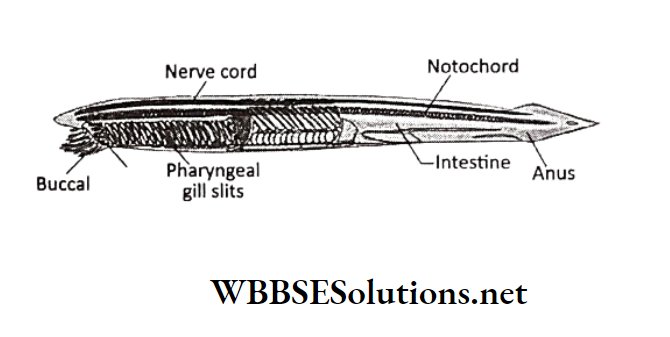
Vertebrate:
These animals have a backbone called a vertebral column enclosing and protecting the spinal cord.
Cyclostomes:
The animal has a circular mouth with sharp teeth, for example, Myxine.
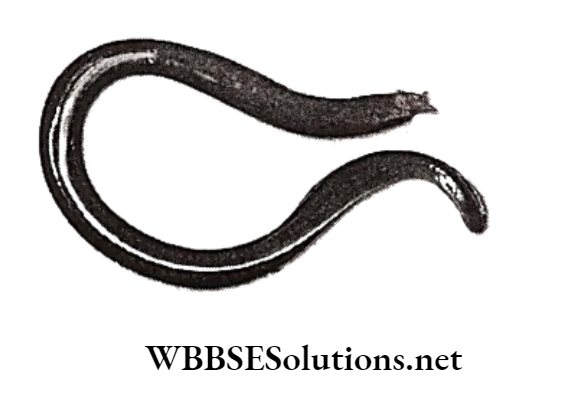
Pisces:
- The group includes all the fish.mat
- The fishes can be cartilaginous (chondrichthyans) or osteichthyan (bony fish), for example, sharks and Rohu.
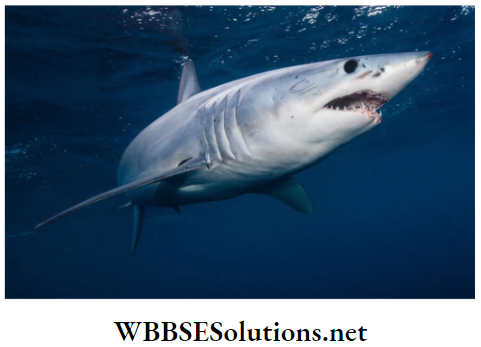
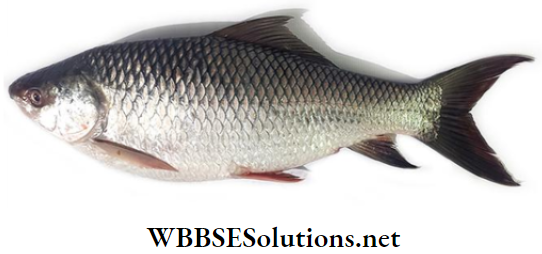
Amphibia:
- This group of animals survives both on land and water.
- They have 3 chambered hearts.
- They go into hibernation or winter sleep, for example, Frogs.
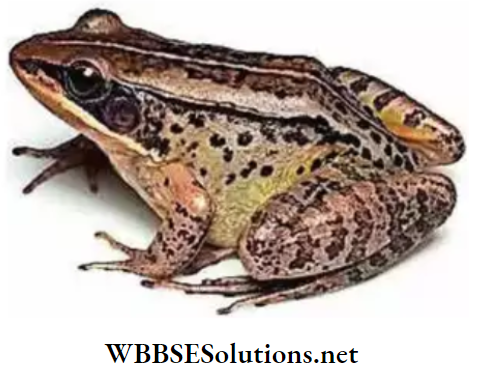
Reptiles:
- The animal has an external epidermis.
- The animal is terrestrial.
- The limbs have digited claws.
- The animal is cold-blooded
- The ventricle is partially segmented except in crocodiles, which have 4 chambered hearts, for example, Snakes.
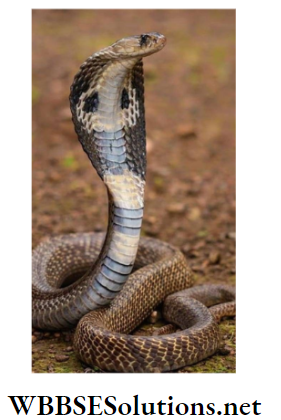
Aves:
- This group is represented by birds, which can be of 2 types, the running bird and the flying bird.
- They are warm-blooded.
- The heart is four-chambered.
- The body is covered with feathers, anterior pair of limbs are modified to produce wings.
- The lips are modified to produce toothless beaks, for example, Ostrich
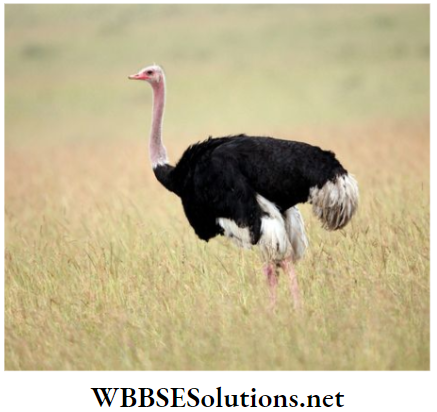
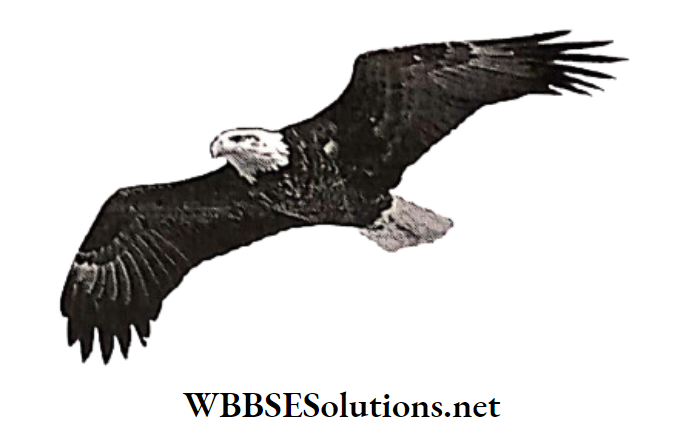
Mammals:
- The animal group is most advanced with the presence of external hairs, pair of external pinna (ear).
- The brain is developed that controls all the major functions, the two lobes of the forebrain function in a well-coordinated manner because they are joined by the Corpus callosum.
- The mammary gland is functional in females for providing nourishment to the developing ones.
- The most primitive mammals are egg-laying Platypi and myg but the intermediate forms have a pouch, which stores the developing babies called marsupium example Kangaroo.
While the most developed mammals are placental mammals, where the last developing fetus is provided with nourishment from the mother’s body through the placenta, for example, Human, Ape.
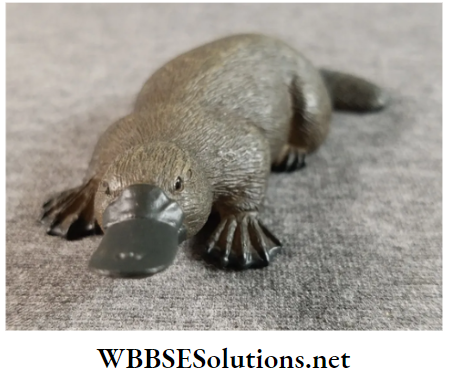
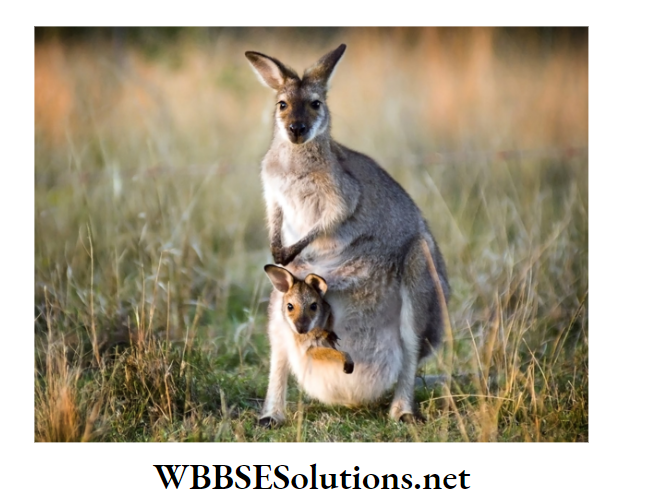
Chapter 10 Biodiversity And Its Classification Present Status Of Living Organisms In The World
The microbes are reproducing and developing at a very fast rate. If they are exposed to different types of antibiotics they develop resistance against these drugs.
Thus they impose an enormous threat to human beings in the future. The flora and fauna surviving in the present-day world are exposed to huge amounts of pollution caused by the human race.
They are endangered and will eventually become extinct in the long run.
If human-induced pollution is not reduced in this world, it will disturb the ecological balance and impose a serious threat to our existence by destroying the biodiversity of the planet.
WBBSE Notes For Class 6 School Science Chapter 9 Common Machines
Chapter 9 Common Machines Introduction To Machines
To do anything at all to lift a box, to push a car, to get out of bed, to jump in the air, to brush your teeth you need to use a pushing or pulling action called a force.
If you go around telling people you are strong, what you really mean is that your body can apply a lot of force.
You may have watched incredibly strong people on TV pulling trucks or trains with their bare hands, but there’s a limit to what even the most muscle-bound human body can do.
Machines let us go beyond that limit. Machines can make us all strong.
When you hear the word “machine”, you probably think of something like a bulldozer or a steam locomotive.
But in science, a machine is anything that makes a force bigger. So a hammer is a machine. A knife and a fork are machines. And even a spoon is a machine.
Read And Learn More: WBBSE Notes For Class 6 School Science
Think about your home. There are probably all sorts of machines in every room. Which room has the most machines? Your kitchen is likely to be the most probable answer.
The large machines are usually the most noticeable-the refrigerator, the oven, the microwave, and perhaps the dishwasher.
They make keeping food fresh, preparing food, cooking, and cleaning much easier. Things such as knives, taps, can openers, doors, tongs, and bottle openers are all examples of machines that help to make our lives easier.
Other machines in the home that are useful and make our life easier include the washing machine, vacuum cleaner, and sewing machine.
Coming to a place outside the home you can see all types of machines at work automobiles, trucks, cranes, cement mixers, bulldozers, mechanical diggers, drilling machines, and all sorts of power tools.
These machines use lots of energy, but they are able to do lots of work that humans can not manage with just muscle power.
Perhaps the first example of a human-made machine designed to manage power is the hand axe made by chipping flint or stone to form a wedge.
These were used in butchering hunted animals, digging, chopping wood and removing tree bark, etc.
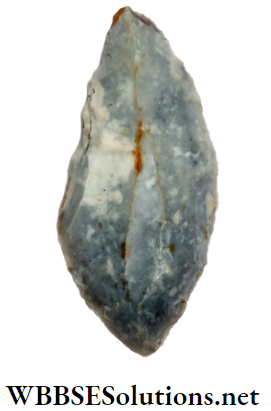
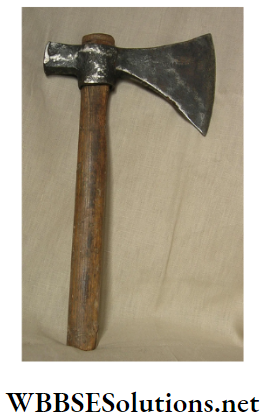
Definition of a machine :
A machine is a tool containing one or more parts that use energy and change the amount, speed, or direction of a force to perform an intended action.
Machines are nowadays often motorized. Historically, it required moving parts to classify as a machine.
However, the advent of electronics has led to the development of devices without moving parts that are considered machines.
Chapter 9 Common Machines Utilities Of Machine
We cited quite a few examples of machines in the previous section. All these machines have one thing in common when you apply a force to them, they increase their size and apply a greater force somewhere else.
You can’t cut meat with your hand alone, but if you push down on a knife, the long handle and the sharpened blade magnify the force you apply with your hand, and the meat slices effortlessly.
When you pound a nail with a hammer, the handle increases the force you apply.
And because the head of the hammer is bigger than the head of the nail, the force you apply is exerted over a smaller area with much greater pressure and the nail easily enters the wood.
Try pushing in a nail with your finger and you’ll appreciate the advantage a hammer gives you.
Living in a world without machines is now almost impossible to imagine. Without even the simplest machines, many tasks that we do every day would be almost impossible.
Machines make it easier for humans to perform everything from the simplest to the most complicated of tasks.
A washing machine, for instance, saves a lot of time as we can do other things while the clothes are being washed.
Vacuum cleaners save a lot of time and energy in cleaning the floors or carpets. A sewing machine is also a very useful machine. Sewing by hand is a very slow job requiring a lot of patience.
Using a sewing machine helps to stitch clothes quickly and neatly. Let us now learn about the advantages of the use of machines.
The following are the advantages of the use of machines :
1. Use of natural forces:
Machines have made it possible to harness the forces of nature in
Simple machine:
in earlier times when a human being needed to move something heavy, he or she probably picked up a long stick, stuck it under the edge of the heavy object and stuck it under the edge of the heavy object, and then pushed it down on the other end of the stick.
The service of man. Man can fly in airplanes, he can connect continents in seconds, and electricity can be generated from sunrays, waterfalls, winds, etc. All these have been made possible with the aid of machines.
2. Heavy and delicate work made simple :
Tasks that are too heavy or too delicate for human muscles to do can be done easily by a machine. A crane can lift loads beyond the human capacity. Without the aid of machines, such jobs would not have been done.
3. Faster and more accurate work :
Only machines are capable of mass production, that too accurately, without a break and for a continuous duration.
While man can make only a few articles in a day by himself, machines employed in factories can make thousands per day for years together with extreme accuracy.
A human being, for example, can not paint exactly the same picture twice. But a machine can turn out thousands of identical articles. This has also resulted in the availability of durable articles at a much cheaper price.
4. More employment:
The introduction of machines in the modern society has created many new occupations. It has thus widened the scope of employment.
5. Hazardous work environment:
Human beings are relieved of all disagreeable and unpleasant jobs in hazardous environments by suitably deploying machines to do the same.
However, it must be remembered that machines are also associated with certain evils. These may be loss of human skill, over-dependence, monotony, destruction, and so on.
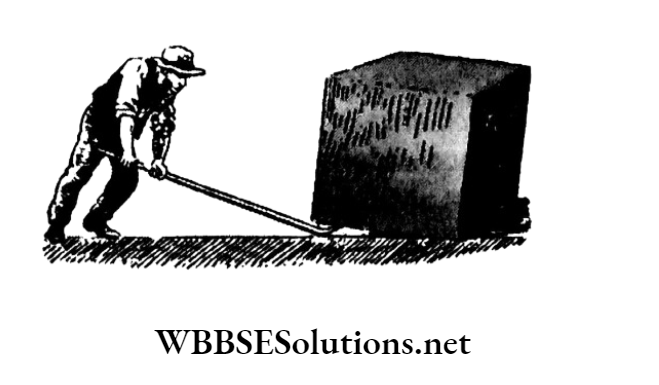
Chapter 9 Common Machines Types Of Machine
Machines can be simple or complex.
Simple machine:
In earlier times when a human being needed to move something heavy, he or she probably picked up a long stick, stuck it under the edge of the heavy object, and then pushed it down on the other end of the stick.
Thus the first simple machine was invented. The simplest form of using one thing to accomplish something faster or better. They were the first ones created and we still use them today.
Definition of a simple machine:
A simple machine is a device that simply transforms the direction or magnitude of a force. It has fewer parts and uses human force to work.
Simple machines help us to do our work faster by either increasing or decreasing the force that we apply.
It may change the direction of the applied force also. Keep in mind that the ratio of the output obtained from a simple machine to the applied force is called the mechanical advantage.
There are 6 basic simple machines:
The lever, the wheel and axle, the inclined plane, the wedge, the pulley, and the screw.
Several of these simple machines are related to each other as shown below Wheel and axle and pulley are modifications of the lever whereas the wedge and screw are modifications of the inclined plane.
The idea of a simple machine originated with the Greek philosopher Archimedes around the 3rd century BC, who studied the Archimedean simple machines lever, pulley, and screw.
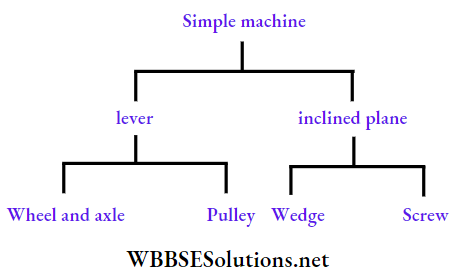
Complex machine:
Simple machines can be regarded as the elementary “building block” of which all more complex machines (sometimes also called “compound machines”) are composed.
Thus complex machines have two or more simple machines working together.
Many of our everyday tools and the objects we use are really complex machines. Let us take a few examples to get the idea clear. Scissors are a good example.
The edge of the blades is wedged. But the blades are combined with a lever to make the two blades come together to cut.
The bicycle that you ride consists of wheels, levers, and pulleys all used in the mechanism of it to make it work.
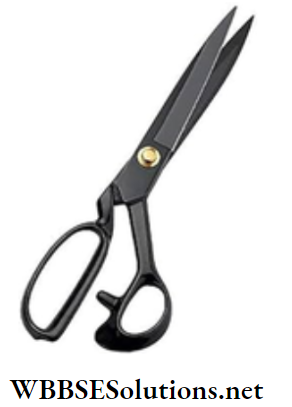
A lawnmower combines wedges (the blades) with a wheel and axle that spins the blades in a circle. But there is even more.
The engine that drives the lawnmower probably works in combination with several simple machines and the handle that you use to push the lawnmower around the lawn is a form of a lever.
So you see that even something complicated can be broken down into the simplest of machines. Other examples of complex machines include sewing machines, printing machines, computers, vehicles, etc.
Definition of a complex machine:
Complex machines have two or more simple machines working together.
Thus the mechanical advantage of a complex machine is just the product of the mechanical advantages of the simple machines of which it is composed.
Chapter 9 Common Machines Lever
Idea of Lever
Levers were probably the first machines used by human beings. It is a long tool such as a pole or a rod put under an object to lift it.
Levers are all around us. The handle of the spoon is a lever since it makes it easier for us to open the lid of a can. The lever becomes more efficient when combined with a fulcrum.
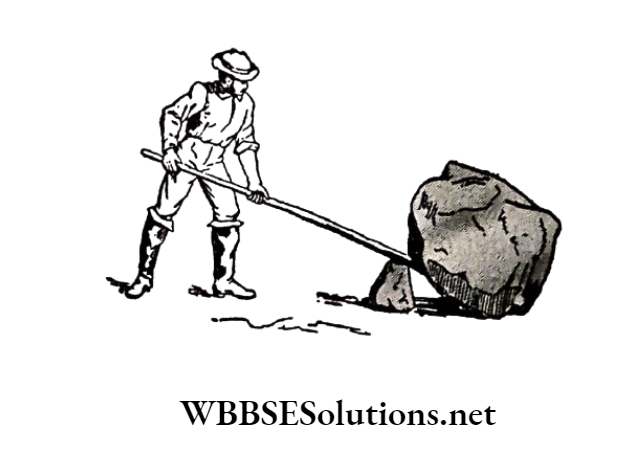
The fulcrum is another object, maybe a rock, used to give alginate Lana to tone support or brace under the long tool. This gives the long pole something to push down against.
Let us take another example to get the matter clear. When you sit on a see-saw, you have probably found out that you need to sit further from the balance point if the person at the opposite end is heavier than you.
The balance or pivot point acts as the fulcrum here. The further away from the fulcrum you sit, the more you can multiply the force of your weight.
If you sit a long way from the fulcrum, you can even easily lift a much heavier person sitting at the other end provided of course they sit very close to the fulcrum on their side.
The force you apply with your weight is called the effort. The fulcrum produces a bigger force to lift the load (here it is the weight of the other person).
The words “effort” and “load” are associated with the working of the lever. However, the important thing fo to remember about levers is that the force you produce (which drives the load) is bigger than the force you apply as effort.
Some examples of levers are:
Door handles the claws of a hammer (for removing nails), light switches, bottle openers, tongs, knives, screwdrivers, wrenches, scissors, and hinges.
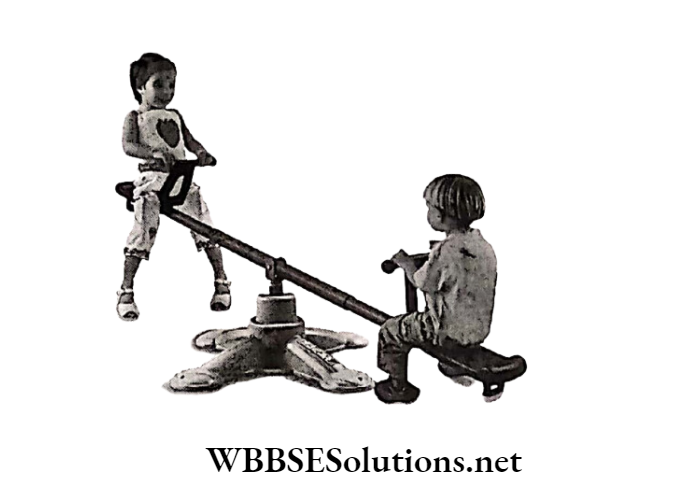

The force that is used on the lever is called the effort (E).
The weight that is moved or lifted by the lever is called the load (L).
The point on the lever that does not move while the lever does the work is called the fulcrum (F). Hence it acts as a fixed point of support for the lever.
The arm that extends from the fulcrum to the point of application of the effort is called the effort arm. In the same way, the arm that extends from the fulcrum to the load point is called the load arm.
The location of the fulcrum helps to determine how well the lever will perform work.
The closer the fulcrum is to the load being lifted (meaning a shorter load arm compared to the effort arm), the higher shall be the load that the person can lift.
The longer the lever, the easier shall be on the part of the person to put effort to lift the load. Thus with a long lever, you can exert a lot of leverage.
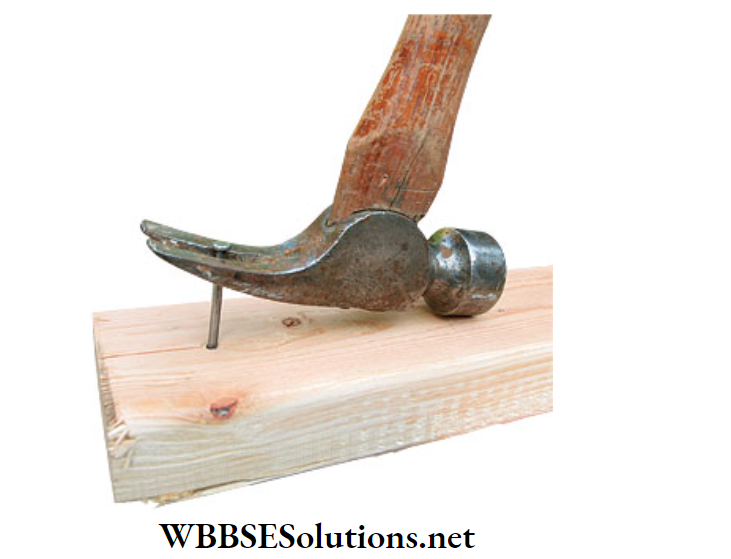
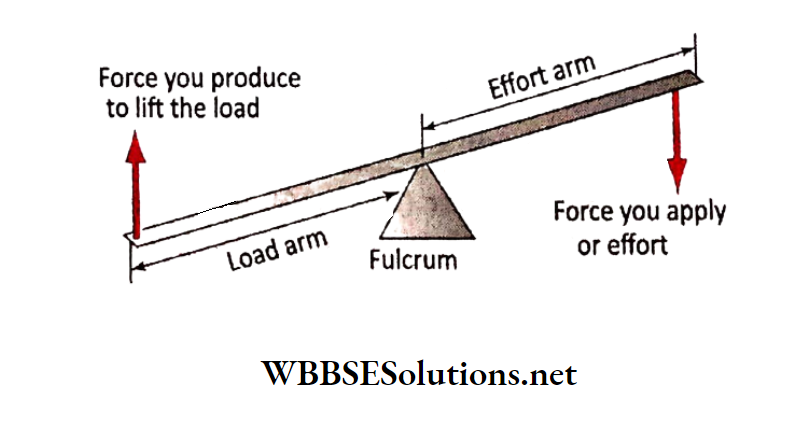
When you use The fulcrum is another object, maybe a rock, used to give alginate Lana to tone support or brace under the long tool. This gives the long pole something to push down against.
Let us take another example to get the matter clear. When you sit on a see-saw, you have probably found out that you need to sit further from the balance point if the person at the opposite end is heavier than you.
The balance or pivot point acts as the fulcrum here. The further away from the fulcrum you sit, the more you can multiply the force of your weight.
If you sit a long way from the fulcrum, you can even easily lift a much heavier person sitting at the other end provided of course they sit very close to the fulcrum on their side.
The force you apply with your weight is called the effort. The fulcrum produces a bigger force to lift the load (here it is the weight of the other person).
The words “effort” and “load” are associated with the working of the lever.
However, the important thing fo to remember about levers is that the force you produce (which drives the load) is bigger than the force you apply as effort.
Some examples of levers are:
Door handles, the claws of a hammer, light switches, bottle openers, tongs, knives, screwdrivers, wrenches, scissors, and hinges.
The force that is used on the lever is called the effort (E).
The weight that is moved or lifted by the lever is called the load (L).
The point on the lever that does not move while the lever does the work is called the fulcrum (F). Hence it acts as a fixed point of support for the lever.
The arm that extends from the fulcrum to the point of application of the effort is called the effort arm. In the same way, the arm that extends from the fulcrum to the load point is called the load arm.
The location of the fulcrum helps to determine how well the lever will perform work.
The closer the fulcrum is to the load being lifted (meaning a shorter load arm compared to the effort arm), the higher shall be the load that the person can lift.
The longer the lever, the easier shall be on the part of the person to put effort to lift the load. Thus with a long lever, you can exert a lot of leverage.
When you use an axe or a wrench, the long handle helps to magnify the force you can apply. The longer the handle, the more leverage you get.
So a long-handled wrench is always easier to use than a short-handled one. And if you can’t budge a nut or bolt with a short wrench, try one with a longer handle.
Hence it can be easily understood that it’s really all in the distance between the effort, the fulcrum, and the load upon which the actions of the lever vary.
Take the case of a spoon. The point at which the spoon touches the outer edge of the can is the fulcrum (F).
Here the load arm is very small, just extending from the fulcrum to the end of the spoon handle that touches the inner edge of the lid.
The effort arm is the longest, which is extended from the fulcrum to the spoon head.

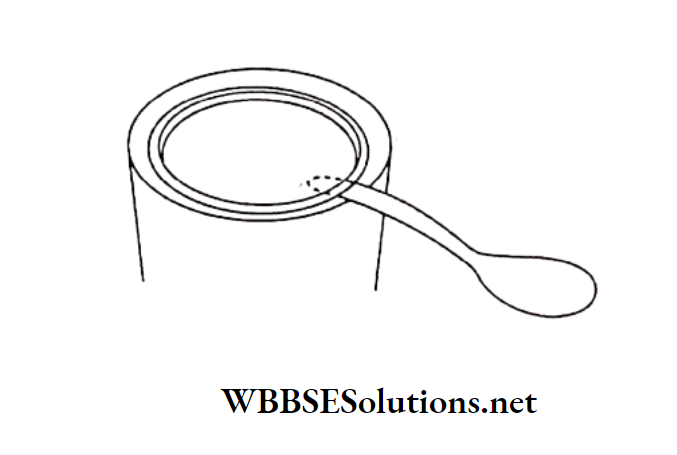
Chapter 9 Common Machines Classes of Lever
All levers give leverage, but not all of them work the same way. There are actually three different kinds of levers (sometimes known as classes).
The class of a lever depends on the relative positions of the efforts, load, and fulcrum.
First-class or Class-1 levers
In a First class lever, the effort or force we apply is on the opposite side of the fulcrum to the force the lever produces.
Hence the fulcrum is placed between the effort and the load. See-saw, beam balance, and scissors are all first-class levers.
Hence the load is placed between the fulcrum and the effort. Nutcrackers, bottle openers,s, and wheelbarrows are all examples of Second class levers.
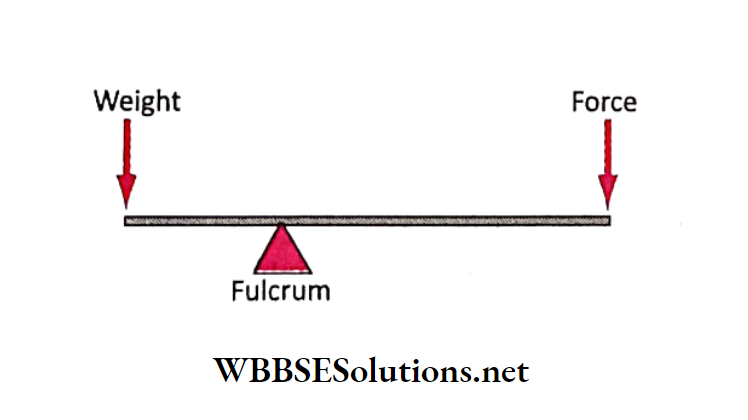
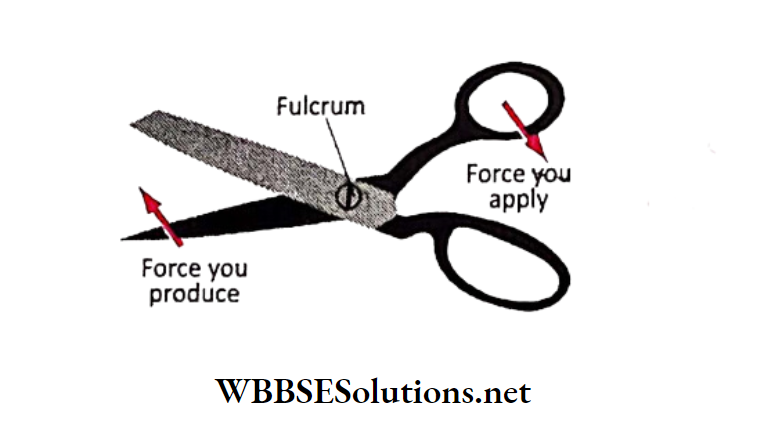
Second-class or Class-2 levers
A Second class lever is arranged in a different way, with the fulcrum at one end. The effort or force is applied at the other end and the force is produced in the middle of the level.
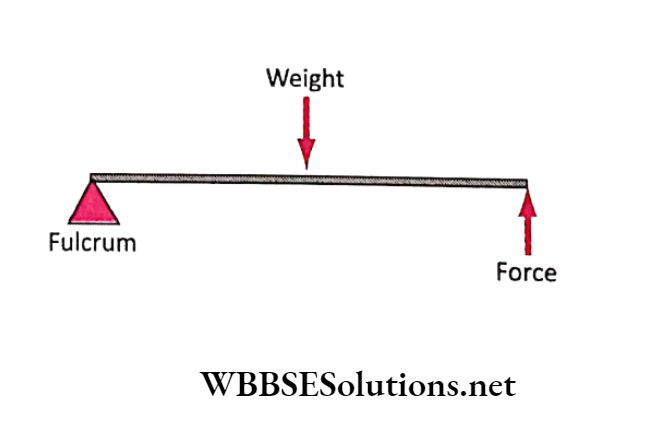
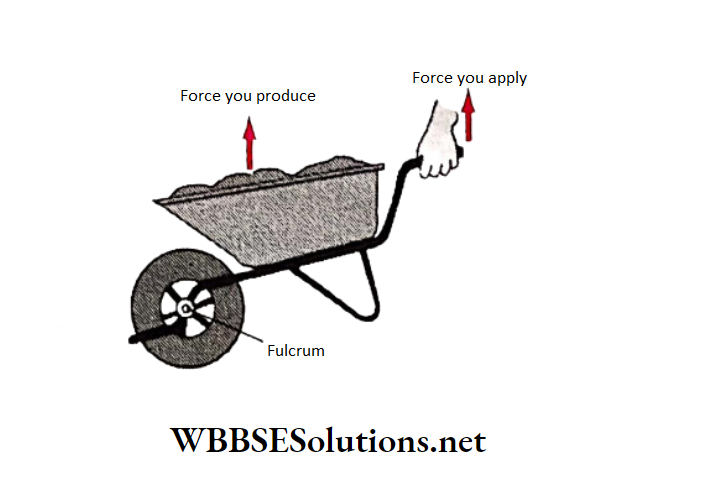
Third-class or Class-3 levers
A Third class lever, like a Second class lever, has the fulcrum at one end.
But the two forces switch around. Hence the effort or force is applied at the middle and the force is produced at the opposite end. Thus the effort is placed between the fulcrum and the load.
Third Class levers reduce the force you apply, giving you much greater control. Stapler, fishing
rod and tongs are examples of Third Yowlega pro-class levers.
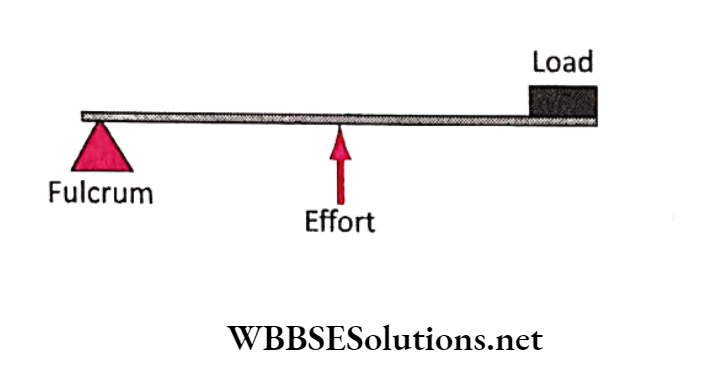
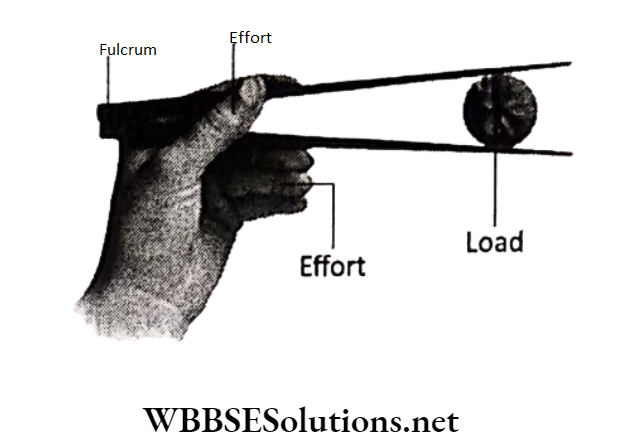
Chapter 9 Common Machines Mechanical Advantages of Various Classes of Lever
Machines are usually designed so that a small effort may overcome a large load. This makes the work easier to be done by the machine.
The advantage that we get from the machine is called its mechanical advantage.
It is a number that expresses the relationship between the load overcome by the machine and the effort applied to the machine.
First-class levers
Here the fulcrum is nearer to the B-end, the B effort (P) is applied at the end A, and the load
(W) is at the end of B.
Since AC (effort arm) is longer than BC (the load arm), W will be greater than P. This means that a big load may be raised by a small effort.
So, the lever of the first class has sufficient mechanical advantage. But depending on the position of the fulcrum C, the mechanical advantage of the lever may be equal to 1.
For example, in a common balance, the fulcrum is exactly at the midpoint of the balance beam which makes the length of the effort arm equal to that of the load arm.
Hence the mechanical advantage of a common balance is equal to 1.
Mechanical advantage \(\text { Mechanical advantage }=\frac{\text { Load }(W)}{\text { Effort or force }(P)}=\frac{\text { Effort arm }}{\text { Load arm }}\)
Second class levers
Here the fulcrum C is situated at one end of the rod, the effort P is at the other end and the load W is applied in between them but nearer to the fulcrum C.
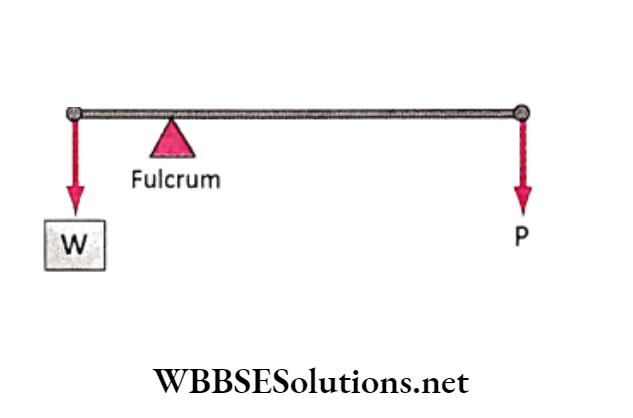

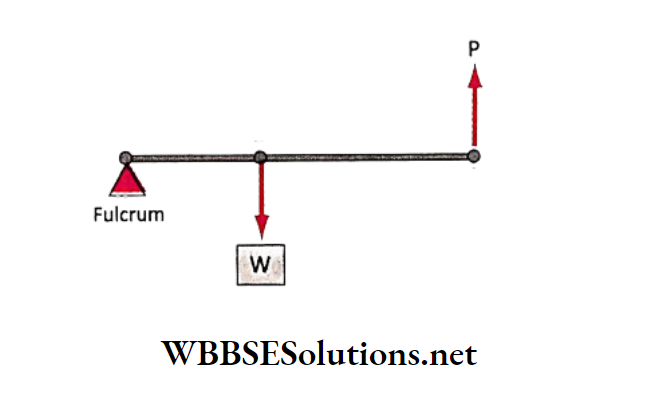
The mechanical advantage =\(\frac{W}{P}\)=\(\frac{AC}{BC}\)
Since the arm AC (effort arm) is always longer than the arm BC (load arm), the load will be always greater than the effort.
In other words, in the lever of the second class, a small effort will always overcome a heavy load. The lever has, therefore, a mechanical advantage always greater than 1.
Third class levers
A third-class lever does not have the mechanical advantage of either the first or the second-class levers and so, examples are less common.
Here the fulcrum C is situated at one end of the rod, the load W is applied at the other end and then but nearer to the load.
The mechanical advantage =\(\frac{W}{P}\)=\(\frac{AC}{BC}\)
Since AC (effort arm) is always smaller than BC (load arm), the load will be always smaller than the effort. In other words, a small load is overcome by a greater effort.
For this reason, this lever has no mechanical advantage. Sometimes it may so happen that the load cannot be lifted directly by applying a force nor is it convenient to use the levers of the first two classes.
In such cases, the third-class lever is used al- although it has no mechanical advantage.
These levers are good for grabbing something small, fiddly, or dirty or picking up something that could be squashed or broken if too much pressure is applied.
Hence, the human arm is an example of the lever of the third class.
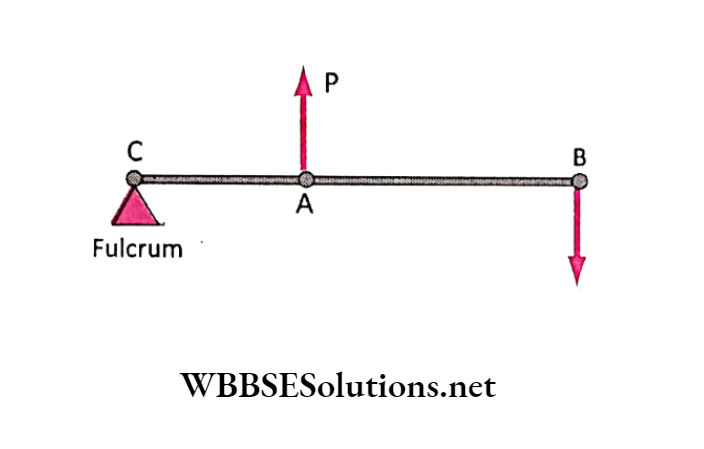
Chapter 9 Common Machines Concept of an Inclined Plane
The inclined plane is simply a ramp whose one end is higher than the opposite end. This allows things to go from a low place to a higher place without much effort.
But the load has to be moved over a longer distance as compared to pulling it up vertically. Whether the inclined plane is long or short, the amount of work done shall be the same.
Thus an inclined plane does not decrease work but makes it easier. On the other hand, gravity makes it easier to move an object down a ramp than up that ramp.
A slide in the children’s park, a d-leaning ladder, a staircase, and a sloping wooden plank are examples of inclined planes.
The acute angle that the inclined plane makes with the ground is called the angle of incline or slope.
If the slope of the inclined plane is low meaning that a smaller angle between the ground and the plane, then it is easier to climb up.
The mechanical advantage of an inclined. the plane is linked to the slope or angle of the incline.

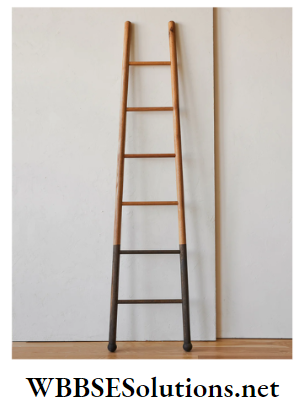
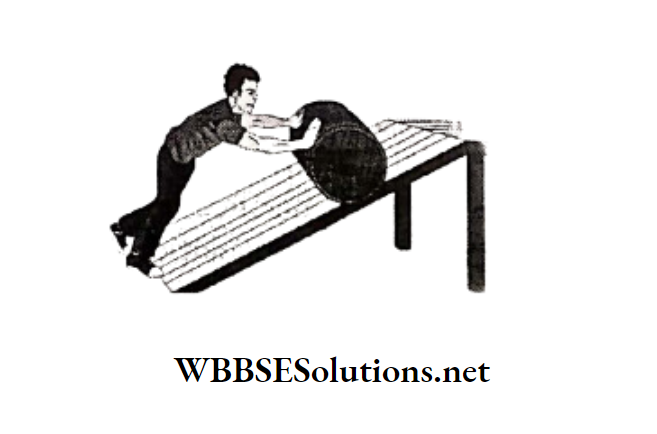
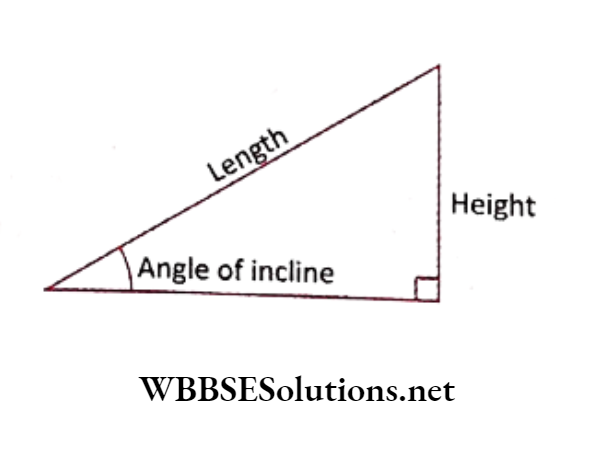
The mechanical advantage=\(\frac{\text { Length }}{\text { Height }}\)
It is apparent that the length of the inclined plane is greater than its height. Hence, by applying a small effort, the big load may be raised. The inclined plane has a mechanical advantage always greater than 1.
Uses of the inclined plane
- As loading ramps to load and unload goods on trucks, ships, planes, etc. FEAR
- As wheelchair ramps for aged, invalid persons and patients.
- As staircase and escalators.
- As conveyor belts.
Chapter 9 Common Machines Wheel And Axle, Wedge, Pulley, Screw
The Wheel and Axle
The wheel has always been considered a major invention in the Wheel history of mankind. But it really would not work till it is attached to the axle.
An axle is a rod or a pole centered in the wheel that allows the wheel to turn around it.
The wheel then spins in a balanced circle to be used for transportation as in a car or bike or to turn the hands of a clock.
Wheels are found where things turn in a circle such as an electric fan, a motor, a merry-go-round, etc.
Both of wheel and axle can rotate freely together about a fixed axis that passes through their common center. This axis is called the axis of rotation.
In recent days we see wheels also under the legs of computer tables, office chairs, traveling bags, and shopping trolleys.
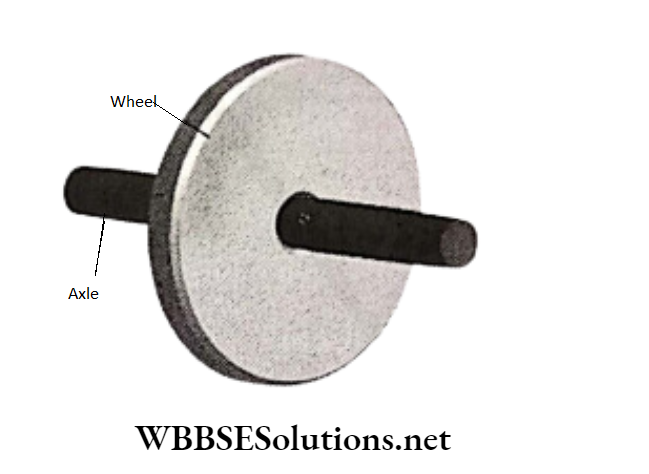
Wheel and axle arrangement can be put to use in lifting loads. How much load the effort can lift, depends on how many times the wheel is larger than the axle.
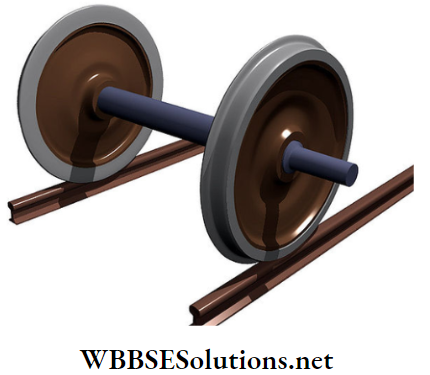
If the diameter of the wheel is twice that of the axle, then, a certain effort given to the axle shall lead to the wheel, being twice as large as the axle, capable of lifting a load twice as heavy.
The mechanical advantage of wheel and axle is defined as.
Mechanical advantage =\(\text { mechanical advantage }=\frac{\text { Radius of the wheel }}{\text { Radius of the axle }}\)
Chapter 9 Common Machines The Wedge
The wedge might appear to be just an inclined plane, but it is actually two inclined planes that meet at a sharp edge. The use of a wedge is actually different in nature.
The wedge is used to separate an object apart. This is needed to cut, tear, or break something in two. A wedge can also be used to keep things together or secure things from movement.
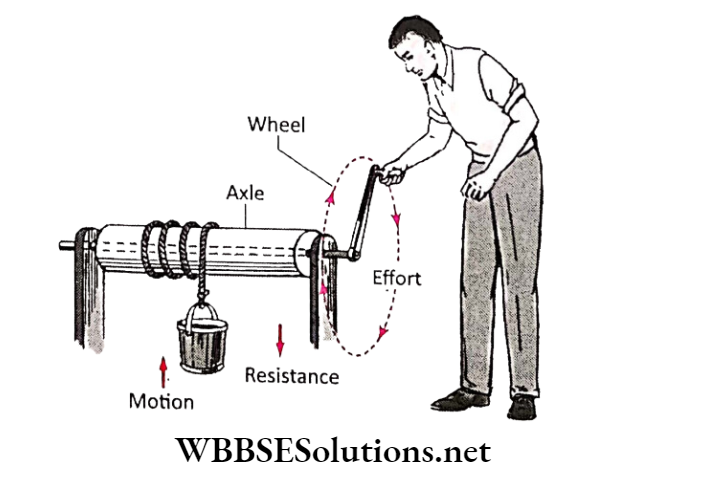
Some examples of wedges that are used for separating might be a shovel, a knife, an axe, a pick axe, a saw, a needle, scissors, or an ice pick.
But wedges can also hold things together as in the case of a staple, push pins, tack, nail, doorstop, or a shim.
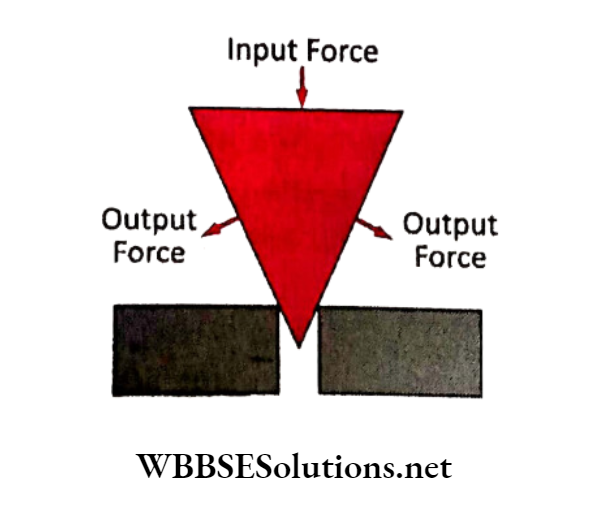
Chapter 9 Common Machines The Pulley
The pulley is actually a modified version of a wheel and axle that is combined with a rope, chain or other cord passing through a groove to allow moving something up and down or back and forth.
The rod that passes through the center of the pulley is called the axle. The pulley rotates freely about the axle.
The pulley can be combined with other pulleys to reduce the amount of work necessary to lift huge amounts of weight or to lower them down.
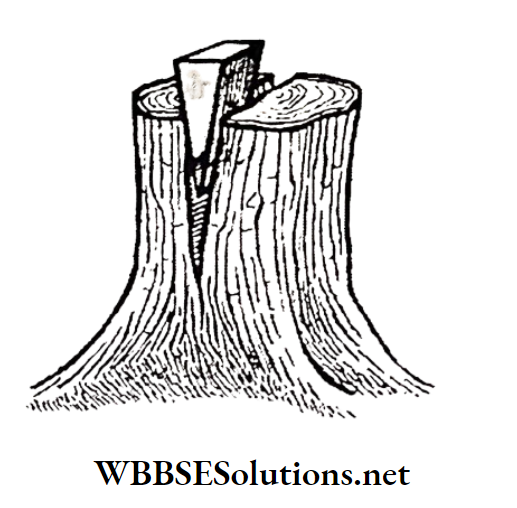
It can also make moving something such as a flag up the pole convenient to do from the ground. It changes the direction of the applied force necessary to do the work.
You pull down on the rope, but the flag goes up. Pulleys are used in window blinds and drapery to move them up and down or back and forth.
Pulleys are also used on ships to raise and lower sails, in the industry to raise and lower heavy cargo, or on cranes for use in moving construction equipment.
Elevators also use pulleys to move the car up and unban down from floor to floor.
There are three types of pulleys-fixed, movable, and compound. A fixed pulley is fastened to some support by means of a hook.
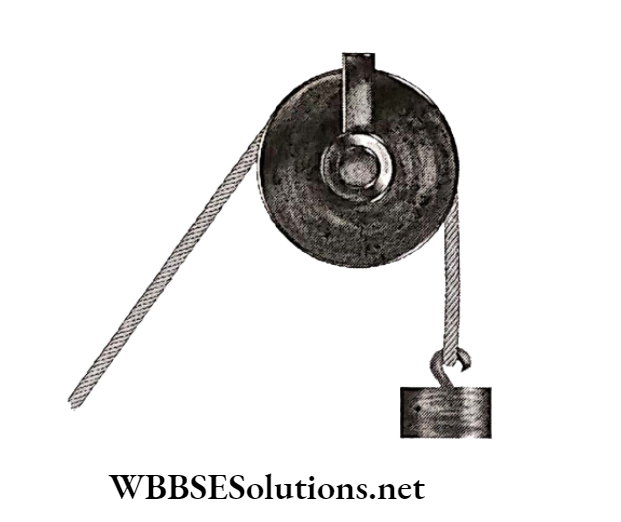
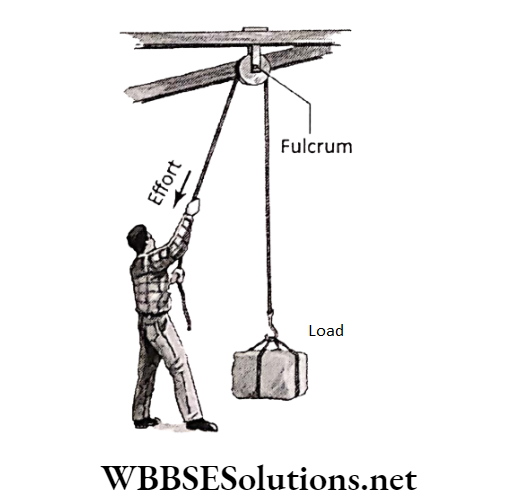
A very common use of a single fixed pulley is in lifting water from wells. A movable pulley is one that remains fastened to the load itself. This type of pulley is free to move up and down.
Examples of movable pulleys include construction cranes, modern elevators, and some types of weight-lifting machines at the gym.
The third type of pulley is the compound pulley, which consists of combinations of fixed and movable pulleys.
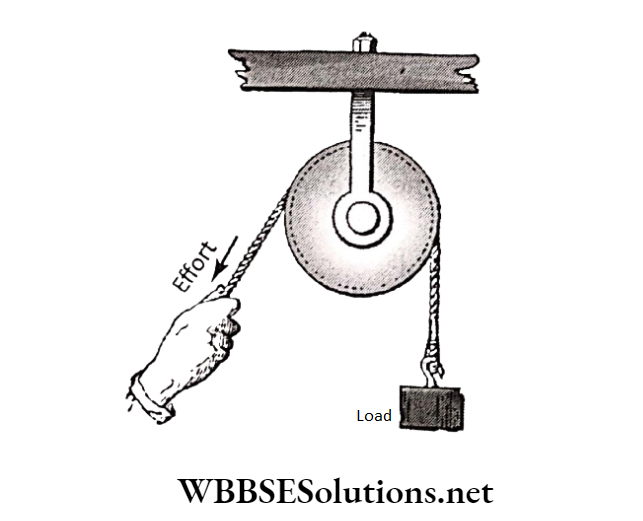
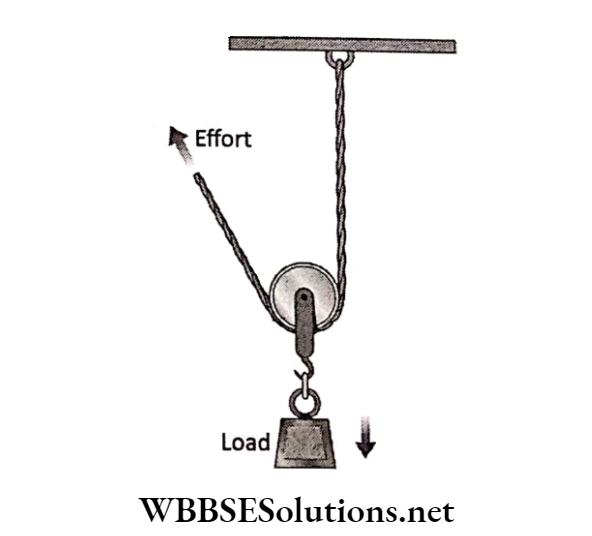
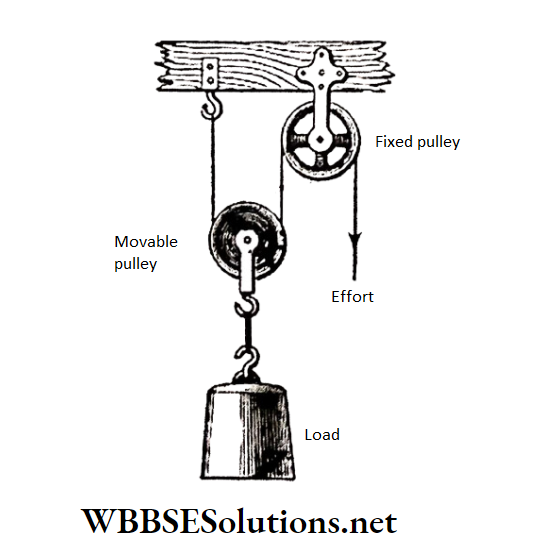
Chapter 9 Common Machines The Screw
Cut out a triangular piece of paper as shown in. This piece of paper resembles an inclined plane. Apply a deep color along the margin of the inclined plane ie., along the inclined side of the paper.
Now if you roll the paper along a pencil as shown, you would see that the darkened inclined margin of the paper would create spiral markings on the pencil’s body.
These spiral markings on the pencil’s body are similar to those on the body of a screw.

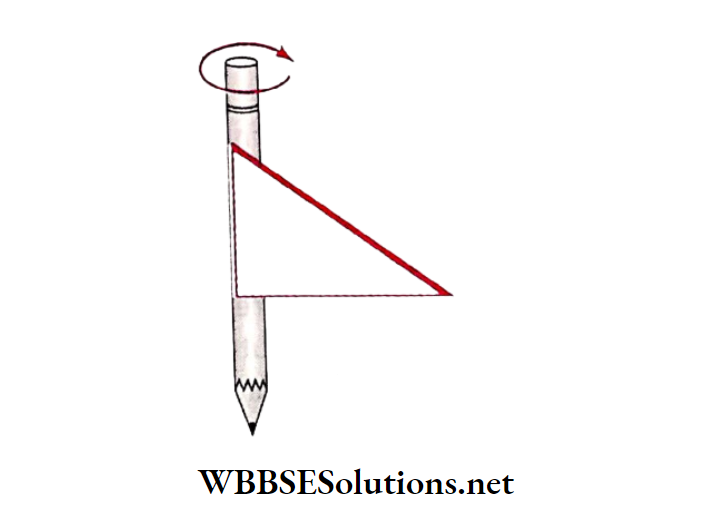
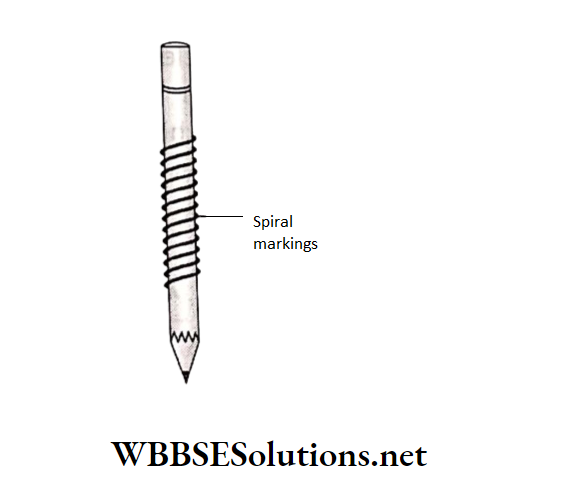
The screw is thus a twisted inclined plane wrapped around a rod, cylinder, or pole. The sharp spiral ridges on the body of the screw actually make an inclined plane.
It allows movement from a lower position to a higher position but at the same time, it moves in a circle. That makes it take up less horizontal space.
A screw can also act to hold things together in some cases due to the sharp ridges. Since the sharp ridges of a screw are spiral, they get driven easily inside wooden planks with the help of a screwdriver.
This is why carpenters prefer using screws to nails. Some examples of the uses of a screw are in a jar lid, a drill, a bolt, the cap of a light bulb, faucets, a car lifting jack, and bottle caps.
Circular stairways are also a form of a screw. Another use of the screw is in a device known as a screw pump.
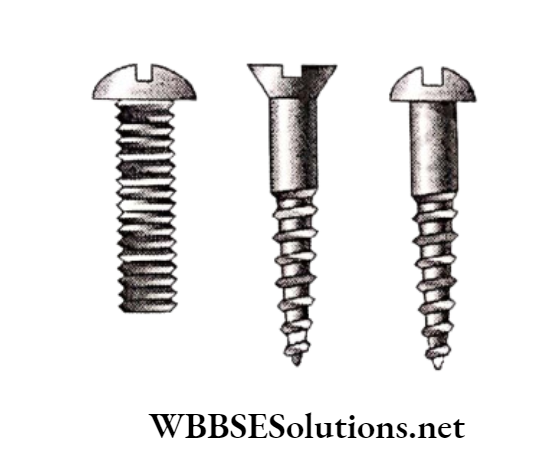
A huge screw shape is lowered into the water and by turning the screw the water is moved up the twisted shaft and lifted to where it is needed.
Screw pumps are often used in agricultural settings such as farms and for irrigation. When a screw is turned once round, it advances a distance equal to the space between its two neighboring threads.
This distance is known as the pitch of the screw. You will find that it is more difficult to drive a screw with a bigger pitch into a piece of wood than a screw with a smaller pitch.
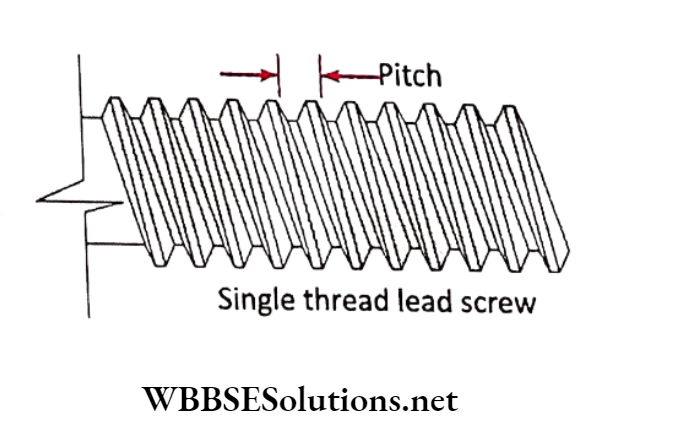
Chapter 9 Common Machines Maintenance Of Machines
Machines undergo wear and tear as they are put to use on a regular basis.
If not taken care of properly, this may lead to permanent damage to the component parts, discoloration or rusting, malfunctioning, decreased efficiency, and above all, serious danger to the person operating the machine.
Hence regular upkeep and maintenance on the overall functionality and condition of machines are a must to keep the continuity of what is expected and the standard performance of the machines.
Simple steps to follow for maintenance of machines :
1. Keep it routine:
Just like the annual check-up with a physician, a regular check-up has to be made to inspect the conditions of the parts of a machine in order to ensure desired performance it.
This is an absolute emergency for heavy and complex machines.
2. Cleaning:
Routine cleaning after every use increases the longevity and performance of a machine many times.
3. Lubrication:
Lubrication of moving parts using grease or oil is an important part of regular machine maintenance. The lubrication procedure may be repeated in line with the degree of usage.
4. Rust prevention:
Metallic parts of a machine shall be protected from rusting caused by moisture ingress by suitably applying an anti-rust synthetic enamel paint or oil paint.
5. Don’t overwork the machine:
It is always advisable that the stated performance of a machine should not be exceeded at any point in time.
Overwork leads to greater wear and tear and finally to the shorter life span of the machine under consideration.
WBBSE Notes For Class 6 School Science Chapter 8 The Human Body
Chapter 8 The Human Body Introduction
The human body refers to the entire structure of a human being and comprises a head, neck, trunk (which includes the thorax and abdomen), forelimbs (arms and hands), and hind limbs (legs and feet).
Every part of the body is composed of various types of cells.
The human body is a complex, highly organized structure made up of unique cells that work together to accomplish the specific functions necessary for sustaining life.
Many people have compared the human body to a machine. Think about some common machines, such as drills and washing machines.
Each machine consists of many parts, and each part does a specific job, yet all the parts work together to perform an overall function.
Read And Learn More: WBBSE Notes For Class 6 School Science
The human body is like a machine in all these ways. In fact, it may be the most fantastic machine on earth.
Human beings are arguably the most complex organisms on this planet.
Imagine billions of microscopic parts, each with its own identity, working together in an organized manner for the benefit of the total being.
The human body is a single structure but it is made up of billions of smaller structures of four major kinds.
1. Cells:
Cells have long been recognized as the simplest units of living matter that can maintain life and reproduce themselves.
The human body, which is made up of numerous cells, begins as a single, newly fertilized cell.
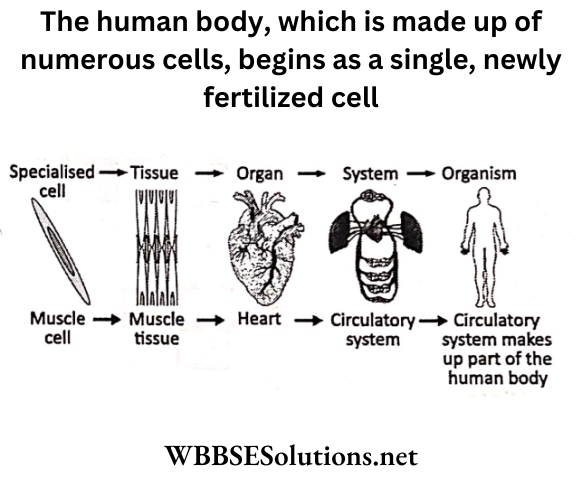
2. Tissues:
Tissues are somewhat more complex units than cells. By definition, a tissue is an organization of a great many similar cells with varying amounts and kinds of non-living, intercellular substance between them.
3. Organs:
Organs are more complex units. than tissues. An organ is an organization of several different kinds of tissues so arranged that together they can perform a special function.
For example, the stomach is an organization of muscles, connective, epithelial, and nervous. tissues.
4. System:
Systems are the most complex of the component units of the human body. A system is an organization of varying numbers and kinds of organs so arranged that together they can perform complex functions for the body.
Chapter 8 The Human Body Systems of the Human Body
Our body consists of a number of biological systems that carry out specific functions necessary for everyday living.
The job of the circulatory system is to move blood, nutrients, oxygen, carbon dioxide, and hormones, around the body.
It consists of the heart, blood, and blood vessels (arteries, veins, and capillaries).
The digestive system consists of a series of connected organs that together allow the body to break down and absorb food, and remove waste (unabsorbed food residues).
It includes the mouth, esophagus, stomach, small and large intestine, rectum, and anus. The liver and pancreas also play a role in the digestive system because they produce digestive juices.
The endocrine system consists of eight major glands that secrete several hormones into the blood.
These hormones, in turn, travel to different tissues and regulate various bodily functions, such as metabolism, growth, and sexual function.
The immune system is the body’s defense against bacteria, viruses, and other pathogens that may be harmful.
It includes lymph nodes, spleen, bone marrow, the thymus, and leukocytes, which are white blood cells such as lymphocytes (including B-cells and T-cells).
The lymphatic system includes lymph nodes, lymph ducts, and lymph vessels, and also plays a role in the body’s defense.
Its main job is to make and move lymph, a clear fluid that contains white blood cells, which helps the body to fight infections.
The lymphatic system also removes excess lymph fluid from body tissues and returns it to the blood.
The nervous system controls both voluntary action (like conscious movement) and involuntary action (like breathing) and sends signals to different parts of the body.
The central nervous system includes the brain and spinal cord. The peripheral nervous system consists of nerves that connect every other part of the body to the central nervous system.
muscle and cardiac muscle) that aid in movement, blood flow, and other bodily functions. Skeletal muscle is connected to bone and helps in voluntary movement.
There are about 650 skeletal muscles. Smooth muscle is found inside organs and helps to move substances through organs.
Cardiac muscle is found in the heart and helps to pump blood. The reproductive system allows humans to reproduce. The male reproductive system includes the penis and a pair of testes that produce sperm.
The female reproductive system consists of the vagina, the uterus, and a pair of ovaries that produce eggs.
During conception, a sperm cell fuses with an egg cell, which creates a fertilized egg that implants and grows in the uterus.
Our body is supported by the skeletal system, which consists of 206 bones, connected by ligaments.
The skeleton not only helps us to move but also is involved in the production of blood cells and the storage of calcium.
The respiratory system allows us to take in vital oxygen and expel carbon dioxide in a process called breathing. It consists mainly of the trachea with its branches and a pair of lungs.
The urinary system helps to eliminate the water-soluble waste products from the body (separated from blood), in the form of urine.
The chief waste product called urea is produced when a certain food is broken down. The whole system includes two kidneys, two ureters, the bladder, two sphincter muscles, and the urethra.
Urine produced by the kidneys travels down the ureters to the bladder and finally exits the body through the urethra.
The skin or integumentary system, is the body’s largest organ. It protects us from the outside world and is our first defense against bacteria, viruses, and other pathogens.
Our skin also helps to regulate body temperature and eliminate waste through perspiration. In addition to skin, the integumentary system includes hair and nails.
Chapter 8 The Human Body Vital Organs Of The Human Body
Humans have several vital organs for survival. Some of these are The brain is the body’s control center, o receiving and sending signals from and to other organs through the nerves and also through corn-secreted hormones.
It is responsible for our thoughts, feelings, memory storage, and general perception of the world.
The heart is responsible for pumping blood throughout our body.
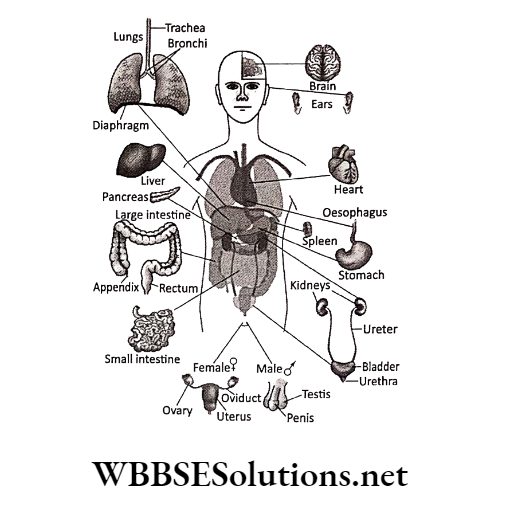
The job of the kidneys is to remove waste and extra fluid from the blood. The kidneys eliminate urea and other waste products in the form of urine.
The liver has many functions including detoxifying harmful chemicals, breakdown of drugs, secretion of bile, and production of blood-clotting proteins.
The lungs are responsible for removing oxygen from the air we breathe in and transferring it to our blood so that it can be sent to our cells.
The lungs also remove carbon dioxide produced in the body which we exhale. albo bould
Chapter 8 The Human Body Heart
We see and hear about the heart everywhere. A long time ago, people even thought that their emotions came from their hearts, maybe because the heart beats faster when a person is scared or excited.
Now we know that emotions come from the brain and in this case, the brain directs the heart to speed up. So what’s the heart up to then? How does it function? What does it look like? Let’s find out.
The human heart is a small organ, shaped somewhat like an upside-down pear. But actually, the heart is a muscle.
The weight of the heart can be anything in between 200-400 grams. It is about a fist in size. The heart sends blood around the whole body.
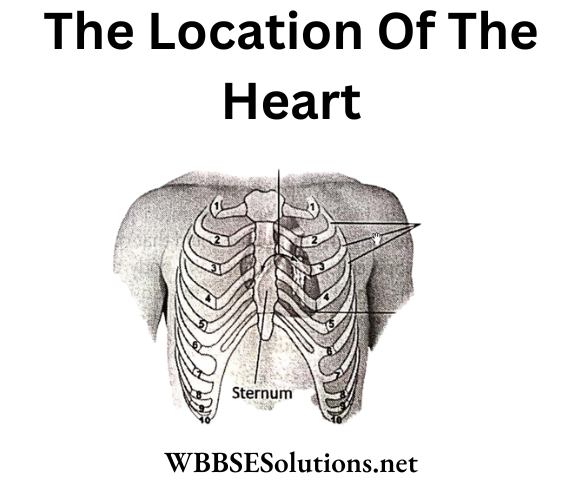
Definition:
The heart is hollow muscular organ brains that pump blood through the circulatory system in a rhythmic contraction and dilation.
Location of the human heart: In simplest terms, if you wish to know the exact location of the human heart, note that it is placed in the upper part of the body, on the left side of the chest.
The chest is just behind the sternum (the long flat bone at the front of the rib cage) and in front of the vertebral column.
In short, it is located anterior to the vertebral column in the back and posterior to the sternum in the chest.
If you look at the anatomy of the human heart and the human body, you will find that the heart is located in between the two lungs.
In 99% of the cases, the heart is located on the left side of the chest. However, in rare cases, the heart can also be found on the right side of the chest. This condition is known as dextrocardia.
Structure of the human heart:
The heart is the hollow, muscular organ in the thoracic cavity (chest) that maintains the circulation of blood throughout the body. It is surrounded by a membrane called the pericardium.
The pericardial cavity-the potential space between the pericardium and the heart-contains the watery pericardial fluid. This fluid prevents friction between the pericardium and the heart.
The heart wall consists of the epicardium (outer layer), the myocardium (middle layer comprised of cardiac muscle tissue), and the endocardium (lining of the myocardium that covers the heart valves).
The heart of a normal adult human beats at the rate of about 72 per minute. How does the heartbeat? Before each beat, the heart gets filled with blood.
Then its muscle contracts to squirt the blood along. When the heart contracts, it squeezes-try squeezing your hand into a fist. That’s what your heart does so that it can squirt out the blood.
Your heart does this all day and all night, all the time. The heart is a hard worker.
The heart is made up of four different blood-filled areas and each of these areas is called a chamber. There are two chambers on each side of the heart.
One chamber is at the top and one chamber is at the bottom. The two chambers on top are called the atria. If you are talking only about one, call it an atrium.
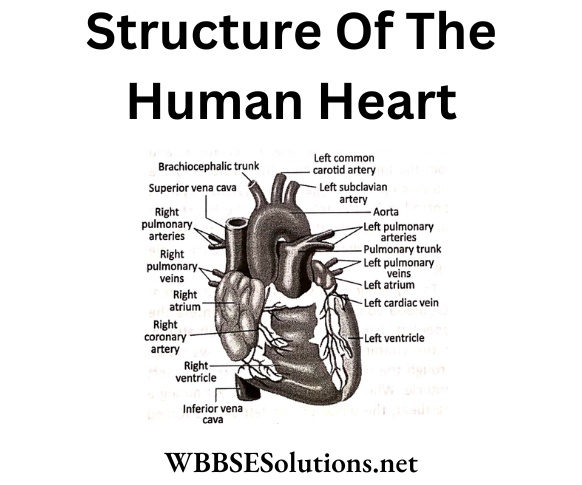
The atria are the chambers that are filled with the blood returning to the heart from the body and lungs. The heart’s right atrium.
The two chambers at the bottom are called the ventricles. The heart has a left ventricle and a right ventricle. Their job is to squirt out the blood to the body and lungs.
Running down the middle of the heart is a thick wall of muscle called the septum. The septum’s job is to separate the left side and the right side of the heart.
The atria and ventricles work as a team-the atria get filled with blood, then dump it into the ventricles. The ventricles then squeeze, pumping blood out of the heart.
While the ventricles are squeezing, the atria are refilled and get ready for the next contraction.
Blood flow relies on four special valves inside the heart. A valve lets something in and keeps it there by closing-think of walking through a door. The door shuts behind you and keeps you from going backward.
Two of the heart valves are the mitral or bicuspid valve and the tricuspid valve. They let blood flow from the atria to the ventricles.
The other two are called the aortic valve and pulmonary valve and they are in charge of controlling the flow as the blood leaves the heart.
These valves all work to keep the blood flowing forward. They open up to let the blood move ahead, then they close quickly to keep the blood from flowing backward.
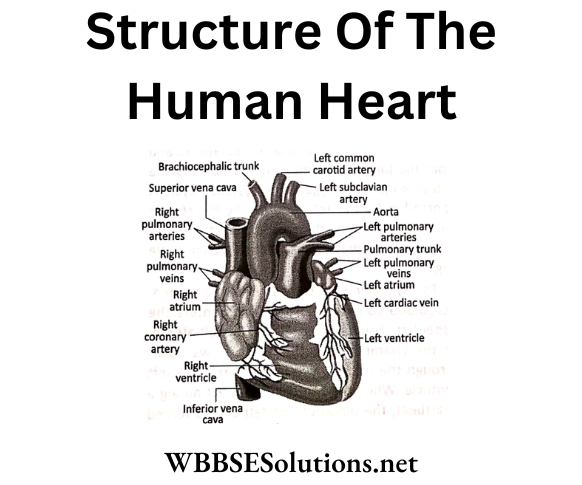
You probably guessed that the blood just doesn’t slosh around your body once it leaves the heart. It moves through many tubes called arteries and veins, which together are called blood vessels.
These blood vessels are attached to the heart. The blood vessels that carry blood away from the heart are called arteries. The ones that carry blood back to the heart are called veins.
The movement of the blood through the heart and around the body is called circulation and your heart is really good at it. It takes less than 60 seconds to pump blood to every cell in your body.
Your body needs this steady supply of blood to keep it working right. Blood delivers oxygen to all the body’s cells. To stay alive, a person needs healthy, living cells.
Without oxygen, these cells would die. If that oxygen-rich blood doesn’t circulate as it should, a person could die.
The left side of the heart sends that oxygen-rich blood out to the body. The body takes the oxygen out of the blood and uses it in the body’s cells.
When the cells use oxygen, they make carbon dioxide and other stuff that is carried away by the blood. It is like the blood delivers lunch to the cells and then has to pick up the trash.
The returning blood enters the right side of the heart. The right ventricle pumps the blood to the lungs for a little freshening up.
In the lungs, carbon dioxide is removed from the blood and sent out of the body when we exhale.
An inhale, in the form of a fresh breath of oxygen, enters the blood to start the process again. And remember, it all happens in about a minute.
When we go for a checkup, our doctor uses a stethoscope to listen carefully to our hearts. A healthy heart makes a lub-dub sound with each beat.
This sound comes from the valves shutting on the blood inside the heart. The first sound (the lub) happens when the mitral and tricuspid valves close.
The next sound (the dub) happens when the aortic and pulmonary valves close after the blood has been squeezed out of the heart.
Even though your heart is inside you, there is an easy way to know it is working from the outside. It is your pulse.
You can find your pulse by lightly pressing on the skin anywhere there is a
Running just beneath your skin. Two good places to find it are on the side of your neck and the inside of your wrist, just below the thumb.

You will know that you have found your pulse when you can feel a small beat under your skin. Each beat is caused by the contraction (squeezing) of your heart.
If you want to find out what your heart rate is, use a watch with a second hand and count how many beats you feel in 1 minute. When you are resting, you will probably feel between 70 and 80 beats per minute.
When you run around a lot, your body needs a lot more oxygen-filled blood. Your heart pumps faster to supply the oxygen-filled blood that your body needs.
You may even feel your heart pounding in your chest. Try running in a place or jumping rope for a few minutes and taking your pulse again-now how many beats do you count in 1 minute?
The circulation of blood:
The human circulatory system is really a two-part system whose purpose is to bring oxygen-bearing blood to all the tissues of the body.
When the heart contracts it pushes the blood out into two major loops or cycles.
In the systemic loop, the blood circulates into the body’s systems, bringing oxygen to all its organs, structures, and tissues and collecting carbon dioxide waste.
In the Pulmonary loop, the blood circulates to and from the lungs, to release the carbon dioxide and pick up new oxygen.
The systemic cycle is controlled by the left side of the heart, and the pulmonary cycle by the right side of the heart. Let’s look at what happens during each cycle.
The systemic loop begins when the oxygen-rich blood coming from the lungs enters the upper left chamber of the heart, the left atrium.
As the chamber fills, the blood flows down through the mitral valve into the relaxing left ventricle. When the ventricles contract during a heartbeat, the blood on the left side is forced into the aorta.
This largest artery of the body is an inch wide. The blood leaving the aorta brings oxygen to all the body’s cells through the network of ever-smaller arteries and capillaries.
The used blood from the body returns to the heart through the network of veins. All of the blood from the body is eventually collected into the two largest veins the superior vena cava.
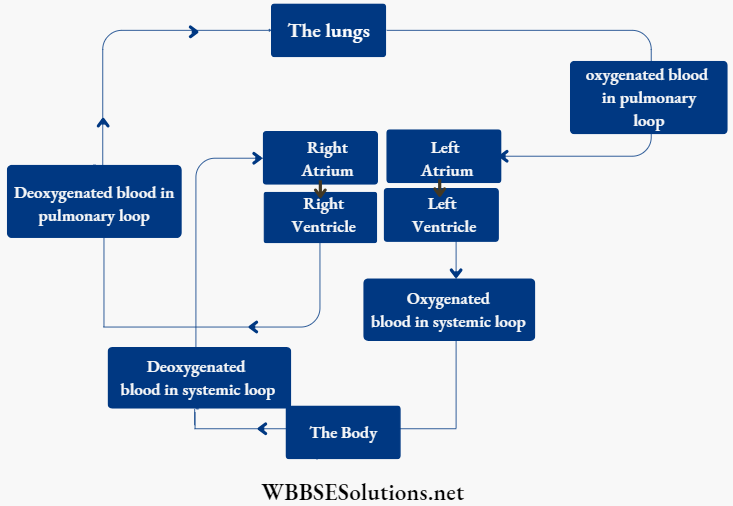
Which receives blood from the upper body, and the inferior vena cava, which receives blood from the lower body region. Both venae cavae empty the blood into the right atrium of the heart.
From here the blood begins its journey through the pulmonary cycle. From the right atrium, the blood descends into the right ventricle through the tricuspid valve.
When the ventricles contract, the blood in the right ventricle is pushed into the pulmonary artery that branches into two main parts one going to the left lung, and one to the right lung.
The fresh, oxygen-rich blood returns to the left atrium of the heart through the pulmonary veins.
Although the circulatory system is made up of two cycles, both happen at the same time. The contraction of the heart muscle starts in the two atria, which push the blood into the ventricles.
Then the walls of the ventricles squeeze together and force the blood out into the arteries: the aorta to the body and the pulmonary artery to the lungs.
Afterward, the heart muscle relaxes, allowing blood to flow in from the veins and fill the atria again.
In healthy people, the normal (resting) heart rate is about 72 beats per minute, but it can go much higher during strenuous exercise.
Scientists have estimated that it takes about 30 seconds for a given portion of the blood to complete the
Entire cycle:
from lungs to heart to body, back to the heart, and out to the lungs.
Conduction system:
An electrical impulse travels through the heart and initiates contractions in the chambers.
The heart’s “spark plug” is an area of specialized heart tissue called the sino- atrial node (SA node), which is located in the right atrium.
Each time the SA node “fires”, an electrical impulse is generated, that travels through the right and left atria, signaling these chambers to contract and pump blood into the ventricles.
Isidore to The impulse then travels into another area of specialized heart tissue called the atrioventricular node (AV node), which is located between the atria and the ventricles.
The 2 electrical impulses are conducted through the AVA node and wire-like pathways (Bundle of His and d Purkinje fibers) to the ventricles, signaling the ventricles to contract and pump blood into the lungs and throughout the body.
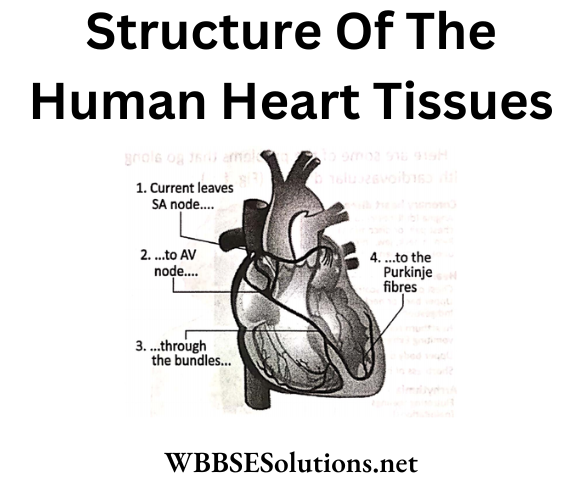
As the SA node maintains the pace of the heartbeat, it is also known as a natural pacemaker. If it does not function, an artificial pacemaker has to be implanted.
The normal sequence of electrical activation of the chambers of the heart is called sinus rhythm. It occurs each time the heart beats, usually about 60 to 80 times every minute.
In a normal heartbeat, the atria contract simultaneously while the ventricles relax. Then, the ventricles relax, and the atria contract.
The term systole refers to contraction and the term diastole refers to relaxation. A heartbeat consists of the systole and diastole of the atria and the systole and diastole of the ventricles.
Problems of the Heart:
You know how important your heart is, so it is no wonder people worry when they hear someone has heart problems. Heart disease, also called.
Cardiovascular disease:
Mainly affects older. people and means that there are problems with the heart and blood vessels.
You might know someone who has cardiovascular disease because several people in our society have some form of it.
This disease includes a variety of problems, including high blood pressure, hardening of the arteries, chest pain, heart attacks, and strokes.
Milanese te The heart is the center of the cardiovascular system. Through the body’s blood vessels, the d heart pumps blood to all of the body’s cells.
The blood carries oxygen, which the cells need. A cardiovascular disease is a group of problems that occur when the heart and blood vessels are not working the way they should.
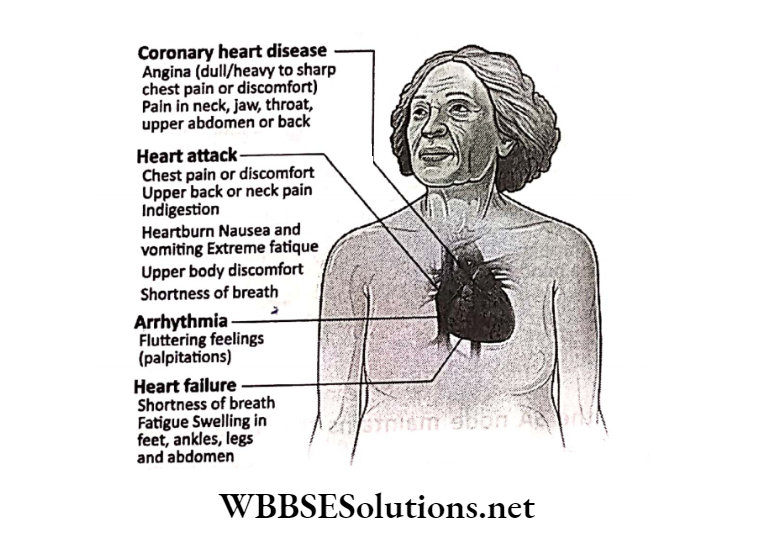
Here are some of the problems that go along with cardiovascular disease:
1. Arteriosclerosis:
Also called hardening of the arteries, arteriosclerosis means the arteries become thickened and are no longer flexible.
2. Atherosclerosis:
A buildup of cholesterol things a risk factor. Some of these risk factors a and fat which makes the arteries narrower, so less blood can flow through. Those buildups are called plaque.
3. Angina:
People with angina feel pain in the chest which means the heart muscle is not getting enough blood and oxygen.
4. Arrhythmia:
It is an irregular or abnormal er heartbeat. This can be a slow heartbeat en (bradycardia), a fast heartbeat (tachycardia), or an irregular heartbeat.
5. Heart attack:
When a blood clot or other blockage cuts blood flow to a part of the heart.
6. Ischemic heart disease:
A pathological condition of the heart muscle caused by lack of oxygen supply marked by pain and discomfort.
7. Heart valve disease:
It occurs when one or more of the four valves in the heart are not working properly. Heart valves help to ensure that the blood being pumped through the heart keeps flowing forward.
A disease of the heart valves (e.g., stenosis, mitral valve prolapse) makes it difficult for the heart to work efficiently.
8. Congenital heart disease:
It is a type of birth defect that causes problems with the heart at birth and occurs in about one out of every 100 live births.
Some of the most common types of congenital heart disease include atrial septal defects (ASD) and ventricular septal defects (VSD).
This occurs when the walls that separate the right and left chambers of the heart are not completely closed and consequently, there is a hole in the wall.
Babies born with congenital heart disease (ASD) may not have symptoms. When they grow up, adults may notice symptoms such as shortness of breath, heart palpitations, fatigue, swelling in the legs, feet, or abdomen, etc.
Symptoms of VSD include a bluish tinge to the skin, lips, and fingernails, along with poor feeding, poor weight gain, and fast breathing.
Heart disease is not contagious-we cannot catch it like we can the flu or a cold. Instead, certain things increase a person’s chances of getting cardiovascular disease.
Doctors call these people who can’t do anything about are like being older and having other people in the family who have had the same problems.
But people do have control over some risk factors smoking, having high blood pressure, being overweight, and not exercising can increase the risk of getting cardiovascular disease.
Chapter 8 The Human Body Blood
Know what blood is- It is that red stuff that oozes out if you get an open wound. The average person has about 4-6 liters of it.
But what is blood, really, and where does it come from?
Components of blood:
It is not made in a kitchen, but blood has ingredients, just like a recipe. To make blood, your body needs to mix:
- Red blood cells, which carry oxygen throughout the body,
- White blood cells, which fight infections,
- Platelets, which are cell fragments that help you stop bleeding if you get a cut, and
- Plasma is a yellowish liquid that carries nutrients, hormones, and proteins throughout the body.
- Your body does not go to the store to buy those ingredients. It makes them. Bone marrow, which is goopy stuff inside your bones, makes the red blood cells, the white blood cells, and the platelets.
Plasma is mostly water, which is absorbed from the intestine from what you drink and eat, with the liver supplying important proteins.
Put all these ingredients together and you have blood- an essential part of the circulatory system.
Thanks to your heart (which pumps blood) and your blood vessels through which blood travels throughout your body from your head to your toes. Let’s find out more about each ingredient.
1. Red blood cells (RBCs)
Red blood cells (also called erythrocytes) look like flattened basketballs. Most of the cells in the blood are red blood cells.
They carry around an important chemical called hemoglobin that gives blood its red color. Blood and breathing go hand in hand.
How? The hemoglobin in blood delivers oxygen, which you get from the air you breathe to all parts of your body. Without oxygen, your body couldn’t keep working and stay alive.
2. White blood cells (WBCs)
White blood cells (also called leukocytes) are bigger than red blood cells. There are usually not a whole lot of white blood cells floating around in your blood when you are healthy.
Once you get sick, your body makes some more to protect you. There are different types of white blood cells that do different things to keep you well.
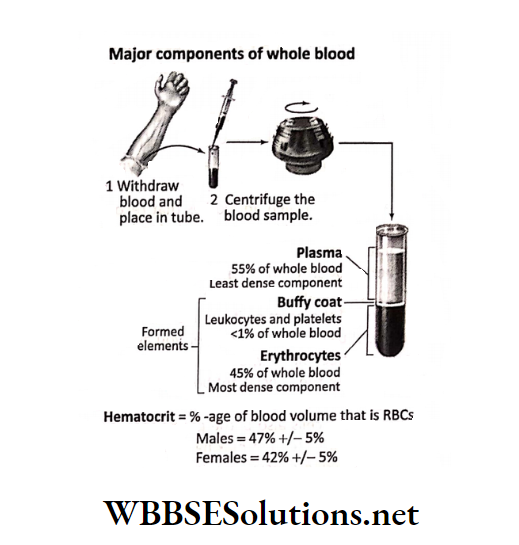
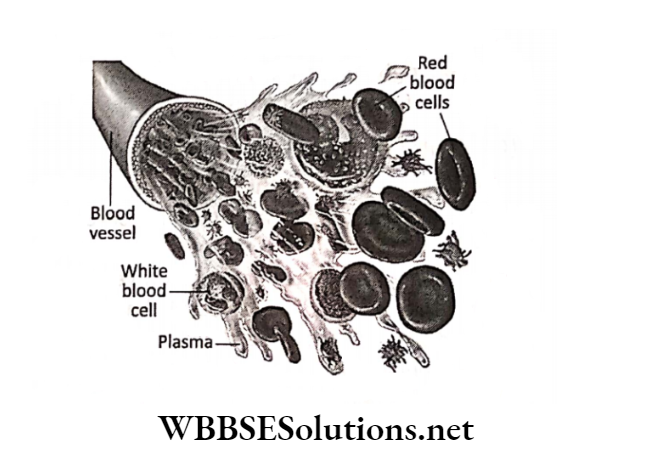
Granulocytes:
Do you know how your skin gets a little red and swollen around a cut or scrape? That means the granulocytes are doing their jobs.
They have a lot to do with how your body cleans things up and helps wounds heal after an injury.
Granulocytes also help to prevent infection by surrounding and destroying things that aren’t supposed to be in your body and by killing germs.
Granulocytes may be of three different types-Neutrophil, Eosinophil, and Basophil.
Agranulocytes: These are of two types- Lymphocytes and Monocytes.
1. Lymphocytes:
There are two types of lymphocytes:
B cells and T cells. B cells help make special proteins called antibodies that recognize stuff that should not be in your body, like bacteria or a virus you get from a sick friend.
Antibodies are, very specific, and can recognize only a certain type of germ. Once the antibody finds it, it gets rid of the germ so it cannot hurt you.
The really cool part is that even after you are better, B cells can become memory cells that remember how to make the special antibody so that if the same germ infects you again, it can kill the germ even faster.
T cells also battle germs that invade the body, but instead of making antibodies, they work by making special chemicals that help to fight the infection.
2. Monocytes:
Monocytes are white blood cells that fight infection by surrounding and destroying bacteria and viruses.
3. Platelets:
Platelets, also called thrombocytes, are tiny round cell fractions that help to make sure you do not bleed too much once you get a cut or scrape.
Cuts and scrapes break blood vessels. If a platelet reaches a blood vessel that’s been broken open, it sends out a chemical signal that makes other nearby platelets stick together inside the vessel.
After the platelets form this plug, they send out more chemical signals that attract clotting factors.
These clotting factors work together to make a web of tiny protein threads within which other blood cells too (RBCs and WBCs) are entangled.
The platelets and this web of protein together with other blood cells make a blood clot. The clot keeps your blood inside the vessel while the break in the blood vessel heals up.
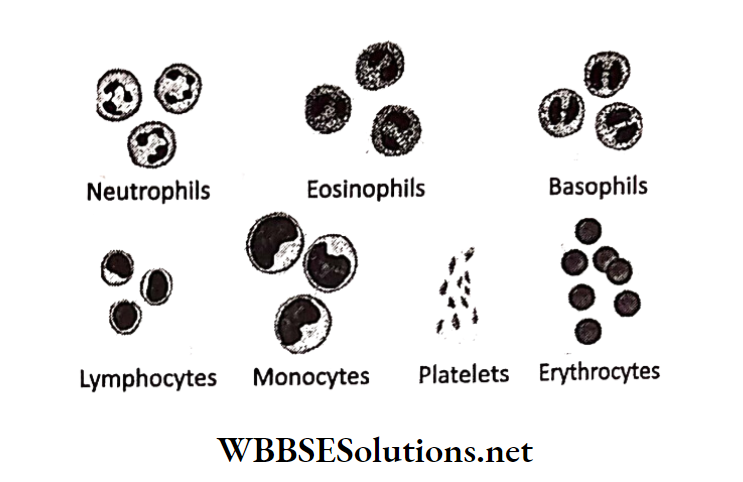
4. Plasma:
Plasma is a yellowish liquid that is mostly. water. But it also carries important nutrients, hormones, and proteins throughout the body.
Nutrients are chemicals from the food you eat that gives your body energy and other things your body’s cells need to do their work and keep you healthy.
Many proteins in plasma are really important to your body, like the clotting factors that help you stop bleeding if you get a cut or a scrape.
Plasma also carries away cell wastes- chemicals that the cell doesn’t want anymore.
Nutrients, hormones, proteins, and waste are dissolved in the plasma-kind of like the cocoa mix that dissolves in a cup of hot water. What are marshmallows? The blood cells-they float in the plasma.
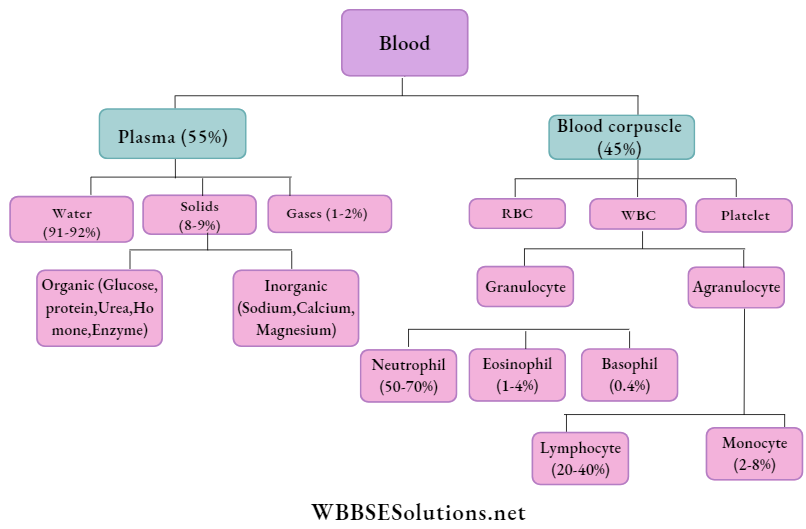
Blood Types:
Everybody’s blood is red, but it’s not all the same. There are eight blood types, described using the letters A, B, and O.
Those letters stand for certain proteins found in the red blood cells. Not everyone has the same proteins. In addition to getting a letter or two, a person’s blood is either “positive” or “negative”.
That doesn’t mean one person’s blood is good and another person’s blood is bad. It’s a way of keeping track of whether someone’s blood has a certain protein called Rh protein.
This protein is called “Rh” because scientists found it while studying Rhesus monkeys. If your blood is positive, you have this protein.
If it is negative, you do not. Either way is totally fine. Blood types are important if a person ever wants to donate blood or needs a blood transfusion. Getting blood of the wrong type can make a person sick.
The disease of the red blood cells:
The most common condition affecting the red blood cells of teens is anemia, a lower-than-normal number of red cells in the blood.
Anaemia is accompanied by a decrease in the amount of hemoglobin present in the blood.
Causes of anemia can be grouped into two categories anemia caused by insufficient RBC production and anemia caused by RBCs being destroyed too soon.
1. Diseases of platelets:
1. Thrombocytopenia, or a lower-than-normal number of platelets, is usually diagnosed because a person has abnormal bruising or bleeding.
2. Diseases of the clotting system:
The body’s clotting system depends on platelets as well as many clotting factors and other blood components.
If a hereditary defect affects any of these components, a person can have a bleeding disorder.
Diseases of the white blood cells:
- Neutropenia happens when there aren’t enough of certain types of white blood cells (neutrophils) to protect the body against bacterial infections.
- Human Immunodeficiency Virus (HIV) is a virus that attacks certain types of WBCs (lymphocytes) that work to fight infection.
Infection with the virus can result in AIDS (Acquired Immunodeficiency Syndrome), leaving the body prone to infections and certain other diseases. - Leukemias are cancers of the cells that produce WBCs.
Different types of WBCs defend the human body against the attack of micro-organisms. They collect at the site of infection and engulf the invaders.
WBC also manufacture antibodies that provide immunity to the body. Every day various microbes invade and enter the human body.
There are certain mechanisms through which these microbes are destroyed once they enter our bodies. The mechanism acts through discharge.
The flow of fluid from part of the body such as from the nose is called a discharge.
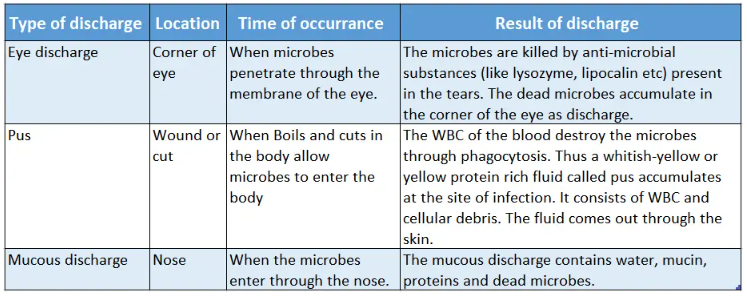
Chapter 8 The Human Body Lungs
Breathing air is necessary for keeping. humans (and many animals) alive. Your lungs make up one of the largest organs in your body, and they work with your respiratory system to allow you to take in fresh air, get rid of impure air, and even talk.
Location of lungs :
Your lungs are in your chest, and they are so large that they take up most of the space there. You have two lungs, but they aren’t of the same size as your eyes or nostrils.
Instead, the lung on the left side of your body is a bit smaller than the lung on the right. This extra space on the left leaves room for your heart.
Your lungs are protected by your rib cage, which is made up of 12 sets of ribs.
These ribs are connected to your spine in your back and go around your lungs to keep them safe.
Beneath the lungs is the diaphragm, a dome-shaped muscle that works with your lungs to allow you to inhale (breathe in) and exhale (breathe out) air.
You can’t see your lungs, but it’s easy to feel them in action: Put your hands on your chest and breathe in very deeply. You will feel your chest getting slightly bigger.
Now breathe out the air, and feel your chest returning to its regular size.
Structure of lungs :
From the outside, the lungs are pink and a bit squishy, like a sponge. At the bottom of the trachea, or windpipe, there are two large tubes.
These tubes are called the main stem bronchi, and one heads left into the left lung, while the other heads right into the right lung.
Each main stem bronchus is the name for just one of the bronchi-then branches off into tubes, or bronchi, which get smaller and even smaller still, like branches on a big tree.
The tiniest tubes are called bronchioles, and there are about 30,000 of them in each lung. Each bronchiole is about the same thickness as a hair.
At the end of each bronchiole is a special area, that leads into clumps of tiny air sacs called alveoli.
There are about 600 million alveoli in our lungs and if we stretch them out, they would cover an entire tennis court.
Each alveolus-what we call just one of the alveoli- has a mesh-like covering of very small blood vessels called capillaries.
These capillaries are so tiny that the cells in your blood need to line up a single file just to march through them.
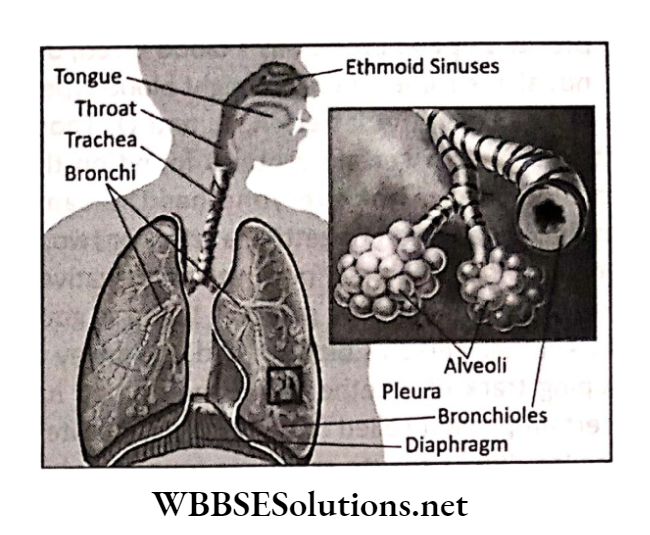
Functioning of lungs:
When you are walking with your pet, cleaning your room, or playing football, you probably do not think about inhaling (breathing in)-you have got other things on your mind.
But every time you inhale air, dozens of body parts work together to help get that air in there without you ever thinking about it.
As you inhale or breathe in, your diaphragm contracts and flattens out. This allows it to move down, so your lungs have more room to grow larger as they fill up with air.
“Move over, diaphragm, I’m filling up!” is what your lungs would say. And the diaphragm is not the only part that gives your lungs the room they need.
Your rib muscles also lift the ribs up and outward to give the lungs more space. At the same time, you inhale air through your mouth and nose, and the air heads down your trachea or windpipe.
On the way down the windpipe, tiny hairs called cilia move gently to keep mucus and dirt out of the lungs.
The air then goes through the series of branches in your lungs, through the bronchi and the bronchioles.
The air finally ends up in the 600 million alveoli. As these millions of alveoli get filled up with air, the lungs get bigger. It’s the alveoli that allow oxygen from the air to pass into your blood.
All the cells in the body need oxygen every minute of the day. Oxygen passes through the walls of each alveolus into the tiny capillaries that surround it.
The oxygen enters the blood in the tiny capillaries, hitching a ride on red blood cells and traveling through layers of blood vessels to the heart.
The heart then sends the oxygenated (filled with oxygen) blood out to all the cells in the body.
When it’s to exhale (breathe out), everything happens in reverse. Now it’s the diaphragm’s turn to say, “Move it!” Your diaphragm relaxes and moves up, pushing air out of the lungs.
Your rib muscles become relaxed and your ribs move in again, creating a smaller space in your chest.
By now your cells have used the oxygen they need, and your blood is carrying carbon dioxide and other wastes that must leave your body.
The blood comes back through the capillaries and the wastes enter the alveoli.
Then you breathe them out in the reverse order of how they came in the air goes through the bronchioles, out the bronchi, out the trachea, and finally out through your mouth and nose.
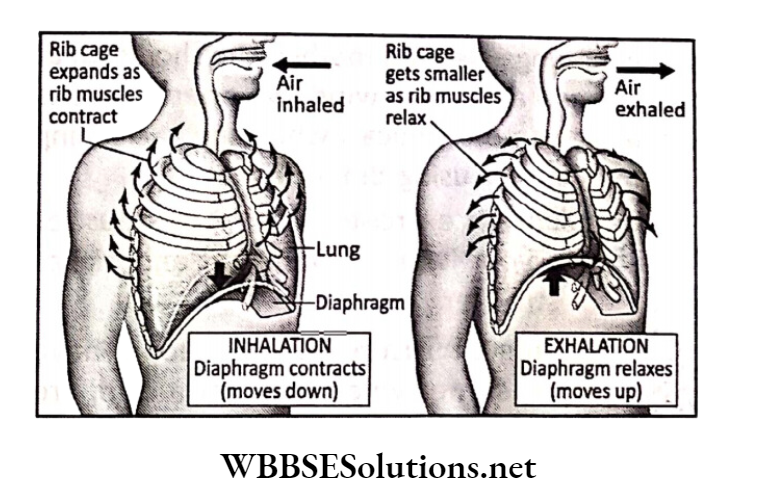
The air that you breathe out not only contains waste and carbon dioxide, but it’s warm too art balls and to me Sequence As air travels through your body, it picks up heat along the way.
You can feel this heat by putting your hand in front of your mouth or nose as you breathe out. With all this movement, you might be wondering why things don’t get stuck as the lungs fill and empty.
Luckily, your lungs are covered by two really slick special layers called pleural membranes.
These membranes are separated by a fluid that allows them to slide around easily while you inhale and exhale.
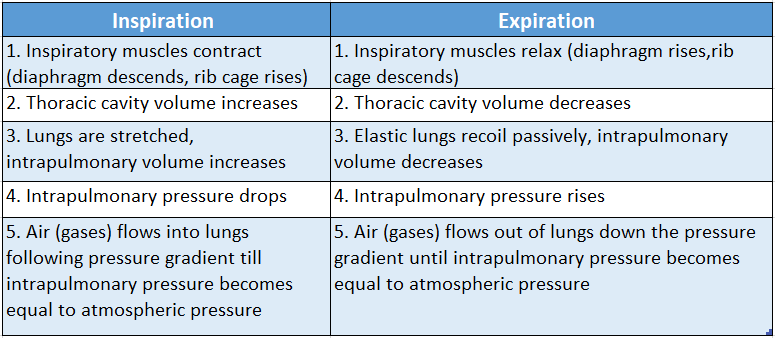
Talking:
Your lungs are important for breathing and also for talking. Above the trachea (windpipe) is the larynx, which is sometimes called the voice box.
Across the voice box are two tiny ridges called vocal cords, which open and close to make sounds. When you exhale air from the lungs, it comes through the trachea and larynx and reaches the vocal cords.
If the vocal cords are closed and the air flows between them, the vocal cords vibrate and a sound is made.
The amount of air you blow out from your lungs determines how loud a sound will be and how long you can make the sound.
Very deeply and saying the names of all the kids in your class-how far can you get without taking the next breath? The next time you’re outside.
Try shouting and see what happens- shouting requires lots of air, so you’ll need to breathe in more frequently than you would if you were only saying the words.
Take care of your lungs :
- Do not smoke and keep away from others who smoke. Lungs do not like cigarette smoke, it can damage them, and cause disease and even death.
Stay out of the workshop if someone is using chemicals, as some chemicals can damage your lungs. - Remind mother, she should wear a mask and have windows open if she is using some chemicals when she is cleaning the oven or using drain cleaner.
- Get plenty of exercise. It makes the muscles around your lungs work harder and makes them stronger.
Problems of lungs:
Some people have asthma. Sometimes when they get a cold, are in contact with something they are allergic to, or exercise hard, the tiny tubes in their lungs get tighter and there is a lot more mucus.
This makes it hard to get air into the alveoli. They can become very short of breath and need medication to help their lung work well.
Illnesses like bronchitis and pneumonia also make it hard for air to get into the alveoli.
When the lungs do not work well, that means there is not enough oxygen getting around to all the cells of the body, and the body systems do not work as well as usual and you feel short of breath.
People affected with Tuberculosis spit blood while coughing, and suffer from mild fever (especially at night), respiratory trouble, and chest pain.
Severe weakness is felt and loss of body weight takes place rapidly.
Chapter 8 The Human Body Bones, Bone-Joints, and Muscles
Every time you move your body from place to place, your bones, muscles, and joints are working together. The bones that make up your skeletal system provide shape and protection.
Your skull protects your brain, your backbones protect your spinal cord and your ribs protect your heart and lungs.
Wherever two bones meet, there is a joint to hold them together and allow them to move, but there would be no movement without the 650 muscles that make up your muscular system.
Bones form the structural framework for our body, while muscles are responsible for pulling the joints, allowing us to move.
The cartilage, muscles, ligaments, and tendons, all work as one, holding bones together and letting joints move. Muscles connect the joints to the bones.
Flexing of the muscles and the ability to bend at the joints moves the bones to accomplish skilled body motions.
1. Bones
Bones make up the framework of our bodies. We call this framework the skeleton. Bones are living, growing, and changing parts of our bodies.
Baby skeletons are made up of more than 300 parts, but by the time we become adults we only have 206 bones. No, we don’t lose any.
It’s just that some of our baby bones are made, partly or completely, of cartilage. As we grow bigger and heavier, cartilage is slowly replaced by harder bone.
Some smaller bones are joined together to make one bigger bone.
Bones are largely made of calcium and other minerals. They are hard enough to support our weight and daily stress. Bones protect our major organs and give our bodies shape.
Bones are actually living tissue. The center of the bone, or marrow, is where your blood is created.
Parts of bones: Most bones have 4 parts:
- The outside part of the bone is called the periosteum. This is a thin but very dense layer that has the nerves and blood vessels which nourish the bone.
- Compact bone is next. It is smooth and very hard.
- Cancellous bone comes next and this looks a bit like a sponge but is much stronger.
- On the very inside of many bones is the bone marrow. It looks a bit like a jelly and it makes new blood cells for the body.
Functions of bones:
- The bones of the skeleton give us our shape and our posture. Without our spine (backbone) and leg bones, we would be unable to stand erect. Bones also protect the softer parts of our bodies.
- The skull is like a natural helmet that protects the brain.
- The spine protects the nerves in the spinal column.
- The rib makes a shield around our lungs and heart.
- They act as a base for muscles, ligaments, and tendons. Ligaments connect bones to bones and tendons connect muscles to bones.
- They all work together to help us move around.
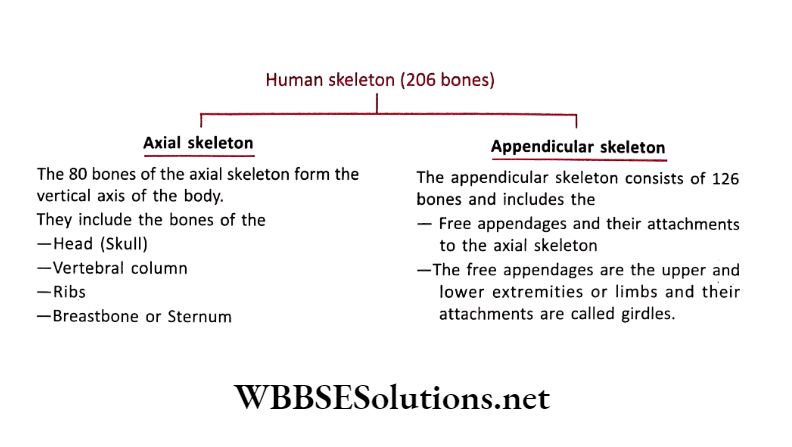
Different major bony parts of our body
- Some bones protect the brain. You can feel the bone at the back of your head and forehead.
- Some bones make the framework for your face. You can feel the bones around your eyes.
- Some bones in the middle part of your ear carry sound from your eardrum to the inner De ear.
- You can feel the jawbone under your chin and where it hinges just under your ear. It is the only bone in your skull that you can move.
2. Spine (Vertebral Column)
The spine has 26 bones which are like circles with wings on the sides and back. They are called vertebrae. There are small discs made of cartilage between each vertebra.
They act like shock absorbers and stop the bones from rubbing against each other. There is also a hole through each of the vertebrae where the spinal cord goes.
- The top 7 are called the cervical vertebrae and they support your head and neck.
- The next 12 are called the thoracic vertebrae. These hold one end of your ribs.
- The next 5 are the lumber vertebrae.
- The next, the sacrum, is a large bone that is actually made of 5 vertebrae fused (joined) together.
- At the bottom of the spine is the coccyx, which is one bone made of 4 small vertebrae fused together.
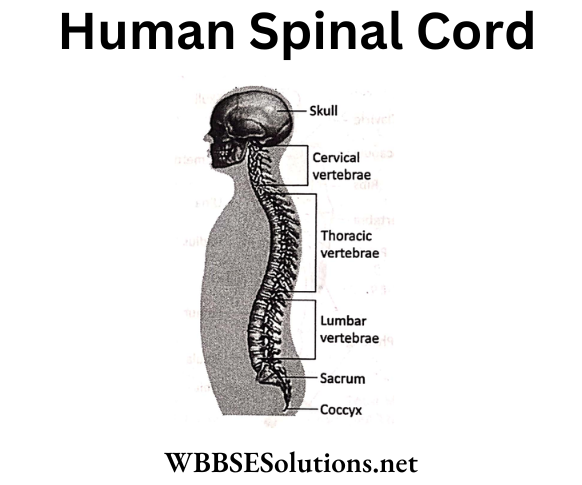
3. Ribs
Ribs make a protective cage around your lungs and heart. There are usually 12 pairs of ribs, each pair attached to the spine at the back.
Each rib is attached to the ribs above and below it by muscles and ligaments.
- At the front of the body, the top 7 ribs are attached to the sternum (or breast bone).
- The next 3 pairs are joined to the ribs above and to the sternum, by cartilage.
- The last 2 pairs of ribs are called the ‘floating’ ribs. They are called floating because they are attached only to the vertebrae and not to the sternum. They don’t have sharp edges sticking out.
4. Arms
Each arm is fastened to the scapula (the shoulder blade) at the back, (which is a triangle-shaped bone near the top of the ribs) and to the clavicle at the front (the collar bone).
The arm has 3 bones-the humerus, the radius, and the ulna. The humerus is the bone between your shoulder and the elbow.
The radius and ulna bones go from the elbow to the wrist. At the end of the radius and ulna is your wrist. Your wrist has 8 small bones, so it is really flexible. In each hand, there are 19 bones.
5. Legs
Your legs are fastened to your pelvis at the hips. The pelvis is shaped like a bowl and supports the contents of your tummy.
- Legs need to be large and strong to support something to pull them. This job is done by the rest of the body.
- The femur is the largest bone in the body and it goes from the pelvis to the knee.
- Another bone called the patella, or kneecap covers the knee joint to protect it.
- Below the knee, there are 2 bones. These are the tibia and the fibula. They join up to a large bone in the ankle called the talus.
- There are 6 other bones here so you can move your ankle around but you cannot move it as much as you can move your wrist. Your feet and ankles have a total of 52 bones in them.
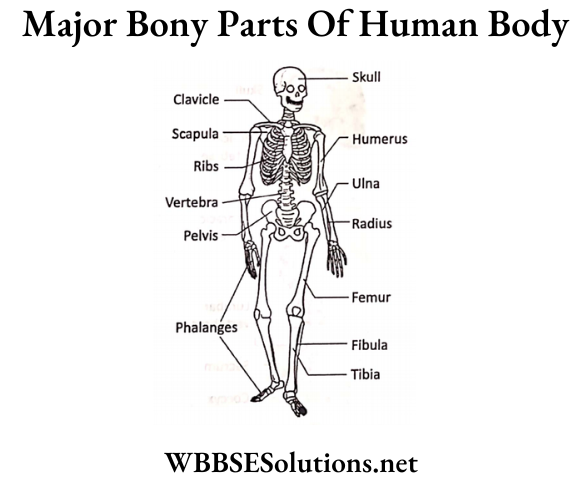
Common orthopedic problems:
Anything that is concerned with muscles, ligaments, and joints is considered orthopedic. Some common problems are
- Arthritis is a rheumatic disease that has symptoms of pain, limited movement, swelling, and pain in connective tissues.
- Osteoarthritis is a degenerative joint disease that middle-aged and older adults experience. The joint cartilage breaks down with the progress of your age and it can occur in the hands, knees, spine, or hips.
- Rheumatoid arthritis is a disease listed in the orthopedic section that causes severe inflammation of the joints. joints. The inflammation is so severe that the functioning of the extremities becomes severely limited.
- Fractures are definite orthopedic problems.
- Low back pain is an orthopedic condition that affects one in ten people. Low back pain presents from mild and annoying to persistent and severe.
- Neck pain can come from injuries or damage to the muscles and ligaments of the neck, a herniated cervical disk of arthritis.
2. Bone Joints
The human body moves in many different ways. You can bend, stretch, turn, and twist. You can move because your bones move at your joints, places where your bones meet.
But your bones can’t move by themselves-they need muscles, which are joined to your bones in order to move them.
There are many joints that help your body move. When you turn your head, bend your knees, or twist your wrists, your joints are in action. Some joints, such as those in your skull, do not move.
These are called fixed joints. Each of the other kinds of joints does a specific type of movement.
What are joints? Joints are places where bones meet. The study of joints is called “arthrology”, which is derived from the Greek words “Atheros” meaning joint, and “logos” meaning study.
One bone can have two or more joints. An example is your jaw or mandible. It is connected to the temporal bones on either side of your skull.
You can feel these joints when you place your hands on the junction of your cheeks and your ears and simulate chewing motions.
What are the functions of your joints:
Aside from smooth movement, joints also have other functions. They allow you to grow. When your brain grows, the sutures in your skull accommodate.
The primary cartilaginous joints of your knees and elbows allow you to grow to your full height. Joints also serve to minimize friction and cushion the bones against impact.
Joints are very important areas in your body. They give you space for growth and allow you to move the way you want.
What are the classifications of joints:
Joints can be classified according to what material unites the bones. The three main types of joints are fibrous joints, cartilaginous joints, and synovial joints.
Fibrous joints are joined by fibrous tissue cartilaginous joints are united by cartilage or a mix of cartilage and fibrous tissue; synovial joints are connected by a synovial membrane that surrounds the joint cavity.
1. Fibrous joints:
The movement allowed by these joints is dependent on the length of the fibrous tissue connecting the bones. In the skull, these joints are called sutures.
Sutures are connected by strong connective tissues and allow very little or no movement in adults. These are known as immovable joints.
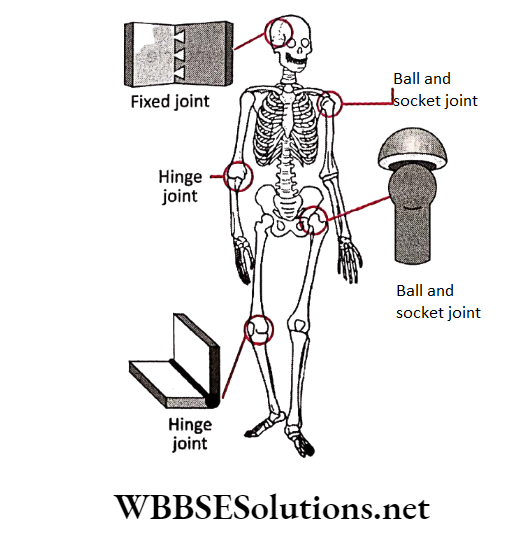
2. Cartilaginous joints:
These joints can be primary cartilaginous joints and secondary cartilaginous joints. Primary cartilaginous joints are connected by cartilage temporarily, early in life.
An example is your knee joint. Later on, the cartilage becomes bone. Secondary cartilaginous joints. consist of bones with the ends covered by cartilage and connected with fibrous. tissue.
These joints are found in the vertebral column and allow slight movement. These are known as partly movable joints.
3. Synovial joints:
These joints are present in the shoulder, hip, knee, ankle, toes, elbow, and the joints of the limbs including the loot fingers.
Their name is derived from the fact sling that they have synovial fluid and is du enclosed within a synovial capsule.
joints allow considerable movement but have ligaments to prevent excessive movement. These are known as movable lee joints.
What are the types of synovial joints?
Synovial joints can be categorized into six types based on the movement they allow. The first type, a plane joint, allows gliding or sliding movement, and the bones involved usually have flat surfaces.
An example of a plane joint is found in the shoulder, between the shoulder blade (acromion of the scapula) and the clavicle.
A hinge joint can move in the axis at a right angle to the joints involved. An example is the elbow joint, which connects the humerus and the ulna.
The movement allowed by this joint includes flexion (bending) and extension (straightening) of your elbow.
The third type of synovial joint is the condyloid joint.
In Greek, “condyloid” means knuckle-like. This type of joint allows movement in two axes. Therefore you can bend it, straighten it, move it from side to side, and rotate it.
An example is your wrist joint. song yen send scrawled The fourth synovial joint type is the saddle joint.
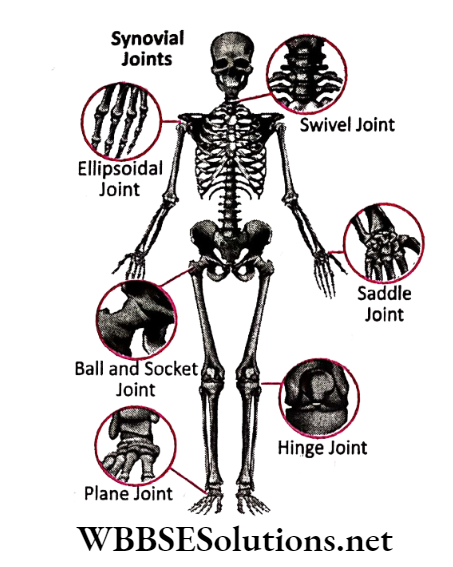
This joint is so-named because the opposing surfaces of the involved bones look like a saddle-one has a convex surface, while the other has a concave surface.
The thumb joint, which can also move in two axes, is a good example of this joint.
Ball and socket joints are perhaps the most versatile synovial joints. They are multi-axial joints, which means they can move in many axes. One joint has a ball and the other joint has a socket.
The shoulder joint and the hip joints are examples of this type. In the hip joint, the ball is the head of the leg bone (femur) while the socket is the acetabulum of the hip (pelvis).
Try to experiment with the kinds of movement you can make with your hip joint. You can bend, flex, open, close, rotate and circularly move your legs.
These movements of the hip joint are very important for ballerinas and dancers who have complex leg routines.
The last type of synovial joint is the pivot joint. These joints only allow rotation. One bone serves like a ring while the other bone has a rounded process rotating within the ring.
This type is found in your neck, particularly in your first two cervical bones called the atlas (the ring) and the dens (the rounded process). This allows you to rotate your head.
Problems of bone joints:
Joints form the connections between bones. They provide support and help you move. Any damage to the joints from disease or injury can interfere with your movement and cause a lot of pain.
Joint pain can be caused by injury affecting any of the ligaments, bursae, or tendons surrounding the joint. Injury can also affect the ligaments, cartilage, and bones within the joint.
Many different conditions can lead to painful joints including osteoarthritis, rheumatoid arthritis, bursitis, gout, strains, sprains, and other injuries. Joint pain is extremely common.
Joint pain can range from mildly irritating to debilitating. It may go away after a few weeks (acute), or last for several weeks or months (chronic).
Even short-term pain and swelling in the joints can affect your quality of life. Whatever the cause of joint pain, you can usually manage it with medication, physical therapy, or alternative treatments.
3. Muscles
Did you know you have more than 600 muscles in your body? They do everything from pumping blood throughout your body to helping you lift your heavy backpack.
You control some of your muscles, while others–like your heart- do their jobs without you thinking about them at all.
Muscles are all made of the same material, a type of elastic tissue (sort of like the material in a rubber band). Thousands or even tens of thousands of small fibers make up each muscle.
Types of muscles:
You have three different types of muscles in your body: smooth muscle, cardiac muscle, and skeletal muscle.
1. Smooth muscles or Involuntary muscles
Smooth muscles-sometimes also called involuntary muscles-are usually in sheets, or layers, with one layer of muscle behind the other. You cannot control this type of muscle.
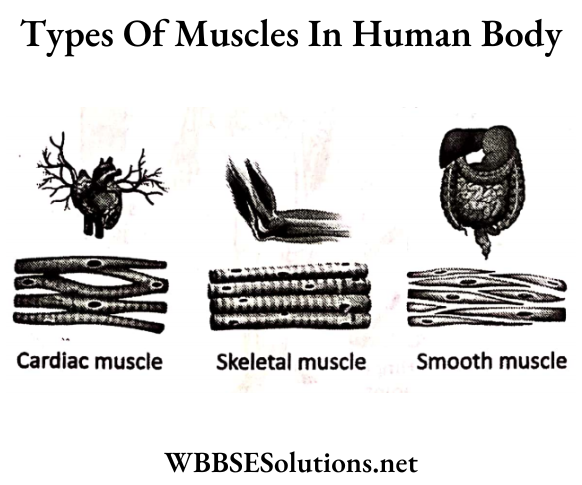
Your brain and body tell these muscles what to do without you even thinking about it. But smooth muscles are at work all over your body.
In your stomach and digestive system, they contract (tighten up) and relax to allow food to make its journey through the body. Smooth muscles are also found in your bladder.
When they are relaxed, they allow you to hold in urine until you can get to the bathroom. Then they contract so that you can push the urine out.
2. Cardiac muscles
The muscle that makes up the heart is called cardiac muscle. It is also known as the myocardium. The thick muscles of the heart contract to pump blood out and then relax to let blood in after it has circulated through the body.
Just like smooth muscle, cardiac muscle works all by itself with no help from you. A special group of cells within the heart are known as the pacemaker of the heart because it controls the heartbeat.
3. Straited muscles or Voluntary muscles
Now, let’s talk about the kind of muscle you think of when we say “muscle”-the ones that show how strong you are and let you boot a soccer ball into the goal.
These are your skeletal muscles-sometimes called striated muscles because the light and dark parts of the muscle fibers make them look striped. are voluntary muscles, which means you can control what they do.
Your leg will not bend to kick the soccer ball unless you want it to. These muscles help to make up the musculoskeletal system-the combination of your muscles and your skeleton, or bones.
Skeletal muscles are held to the bones with the help of tendons Tendons are cords made of tough tissue, and they work as special connector pieces between bone and muscle.
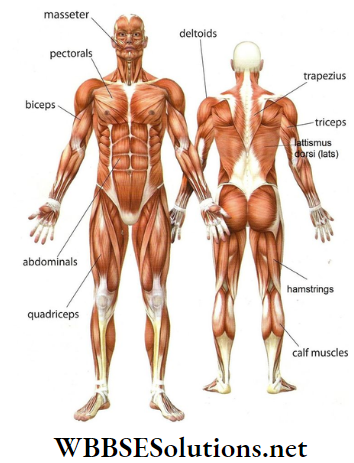
The tendons are attached so well that when you contract one of your muscles, the tendon and bone move along with it.
Skeletal muscles also give your body the power it needs to lift and push things. Muscles in your neck and the top part of your back aren’t as large, but they are capable of some pretty amazing things.
Try rotating your head around, back and forth, and up and down to feel the power of the muscles in your neck. These muscles also hold your head high.
How do muscles work? Muscles work by expanding and contracting. Muscles have long, thin cells that are grouped into bundles.
When a muscle fiber gets a signal from its nerve, proteins, and chemicals release energy to either contract the muscle or relax it.
When the muscle contracts, this pulls the bones it’s connected to, closer together. Many of our muscles come in pairs. An example of this is the biceps and triceps in our arms.
When the biceps contract the triceps will relax, which allows our arm to bend. When we want to straighten our arm back out, the biceps will relax and the triceps will contract.
Muscle pairs allow us to move back and forth. Caring muscles Muscles get most of their energy from glucose.
Glucose is made from several types of carbohydrates such as sucrose (which is usually called sugar), lactose (from milk), or fructose (from fruits).
When muscles need to get energy from glucose they do this by changing the glucose into other chemicals such as water and carbon dioxide which release the energy.
We sometimes call this ‘burning’ glucose. They use the oxygen being carried in the blood to help them do this.
Muscles need to move to remain healthy and strong. You can help your muscles stay strong and healthy by exercising every day and using moms have different sets of muscles when they exercise.
When you exercise a lot, your muscles become tired from all the contracting and relaxing. Your muscles might get hurt then.
Have you ever had a cramp? This is when your muscles seem to lock up, and you have a pain in your foot or your leg, or a ‘stitch’ in your side.
This happens when one or more of your muscles contract and will not relax again (called a spasm).
Sweating and not drinking enough on a hot day may mean that you are more likely to get a muscle cramp.
Try drinking water, and stretching and massaging the muscle that hurts and it will get better.
Diseases that can affect muscles: Polio is a virus that attacks the spinal cord. The brain can’t send messages to the muscles and they stop working.
Not long ago a lot of kids would catch this illness, but nowadays not many people get poliomyelitis (that’s its full name) because kids are given an immunization against it.

Tetanus also affects muscles and kids have already had ‘shots’ to stop them from getting this too. There are some other diseases that can affect muscles.
If a person spends long hours in front of a computer then he may sustain injuries from occupational poor posture. The most common such injuries are
- Mouse shoulder.
- Computer back
- Lumbar strains and sprains
- Disc injuries
- Tennis elbow.
Chapter 8 The Human Body The Growth And Development Of The Human Body
There are clear stages that children pass through from birth to adulthood. These stages are the same for boys and girls, but girls generally mature before boys. This is clearly shown in the diagram below.
Physical development:
Physical growth is obviously important to performance. We will start by looking at how the body changes during development.
There are important changes in body size and proportions. These changes affect the way where children can perform different skills and activities. our gas Patterns of growth ou mot varans
1. Changes in size
Children grow in size at a very fast rate. At birth, infants are only about a quarter of their adult height.
This final adult height is usually reached at about twenty years of age. There are four characteristic stages of growth from birth to adulthood.
- Rapid growth in infancy and early childhood
- Slow, steady growth in middle childhood
- Rapid growth during puberty bow sort
- Gradual slowing down of growth in adolescence until adult height is reached. Both sexes are of comparable shape and size during infancy and childhood.
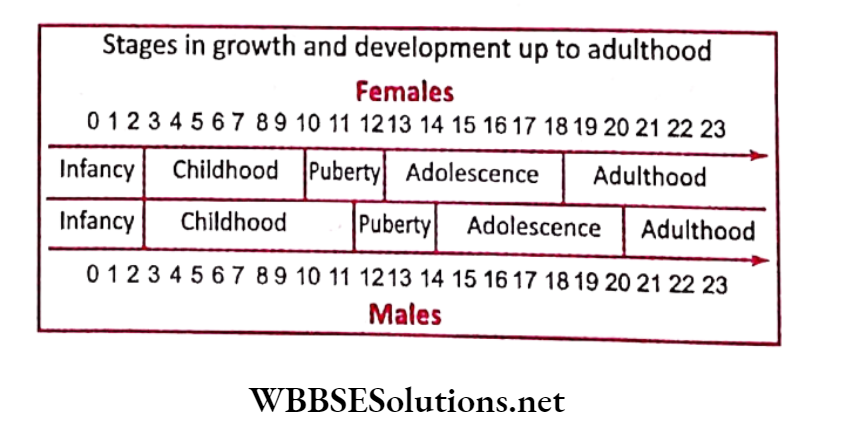
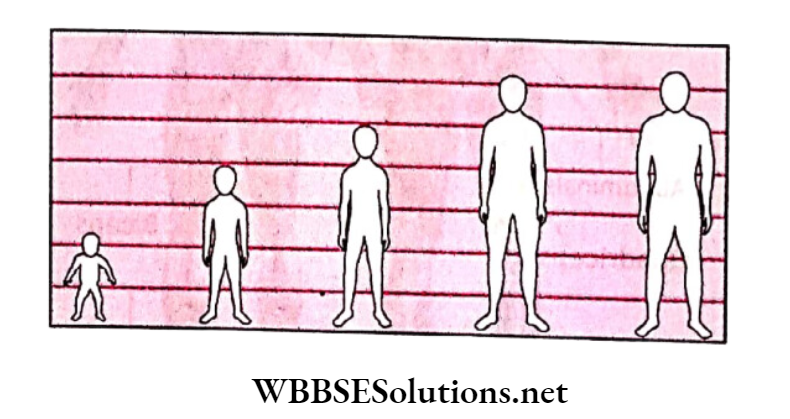
2. Changes in proportions
The physical proportions of the body at birth are very different from those of the adult. Some body parts grow more than others during g development to each of the final adult proportions.
The illustration shows the relative size of body parts at different ages. The head is proportionally large and the legs are proportionally short during childhood.
At birth, the head is one-quarter of the length of the body compared with about one-sixth in the adult. The legs are about one-third the length of the body at birth and one-half in the adult.
Because the body proportions change this means that not all of the body segments grow by the same amount.
Changes in the size and shape of the body. are caused by different segments growing at different times.
These changes in body proportions will have a great influence on how skills will be performed.
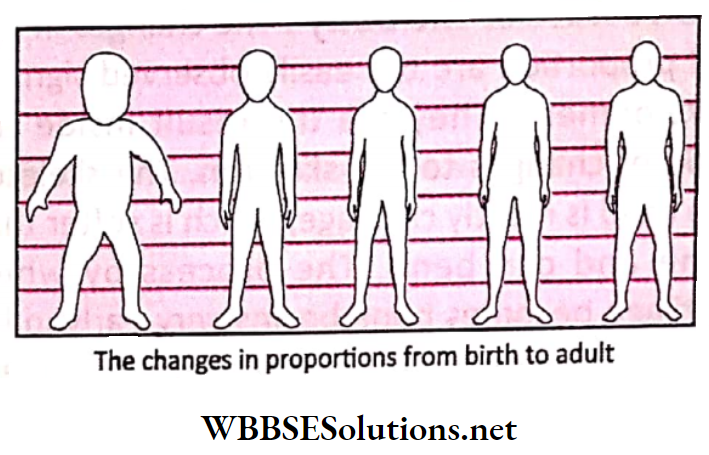
For example, changes in the relative size of the head in childhood affect the balance of the body during movement and the relative shortness of the legs at a very young limit running ability.
At the beginning of puberty, children have long arms and legs. They are better suited for running but the rapid growth may make them appear to be clumsy and to have difficulty in coordination.
Nous Growth spurts:
When the rate of growth increases rapidly it is called a growth spurt. The most important growth spurt is the one that occurs at puberty. This spurt produces a rapid increase in both weight and height.
The peak of this growth spurt occurs at about age 12 for girls and age 14 for boys. Before this growth spurt, there are no important differences between boys and girls in weight and height.
During growth spurts, most of the child’s energy is used for growing.
Children will be easily tired and may not be able to keep up their usual Birth to 1 year to puberty Adolescence growth of trunk growth of legs growth of trunk Areas of growth volume or intensity of training.
Light training will stimulate bodily growth if the child has enough energy.
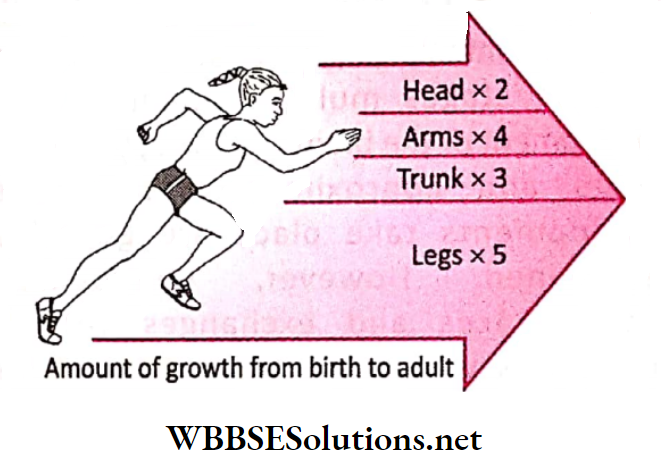
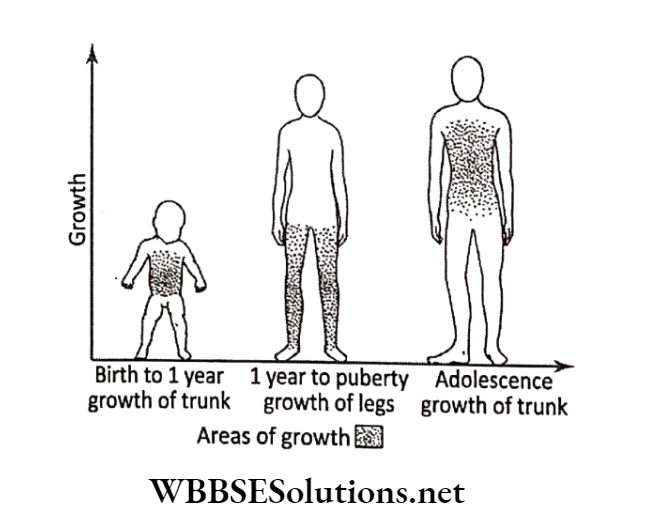
Difference between boys and girls:
The growth spurt and puberty occur at different ages for girls and boys. Girls usually start and finish the stages of puberty and adolescence earlier than boys.
The characteristic differences between boys and girls occur at puberty in response to changes in hormones produced by shoulders and little change in hip width in boys’ bodies.
Typically, this results in broader and broader hips and little change in shoulder width in girls.
Structure of the body:
The changes in size and proportion are easily observed signs of development. They are the result inside the body of changes to the skeleton.
The skeleton of a child is mostly cartilage, which is softer than bone and can bend. The process by which cartilage becomes bone begins very early in life in special growth areas in the bones.
These special growth areas are called growth plates.
Psychological development:
Children go through distinct periods of development as they move from infants to young adults. During each of these stages, multiple changes in the development of the brain are taking place.
What occurs and approximately when these developments take place are genetically determined.
However, environmental circumstances and exchanges with key individuals within that environment have a significant influence on how each child benefits from each development event.
Ages and stages is a term used to broadly outline key periods in the human development timeline.
During each stage growth and development occur in the primary developmental domains including physical, intellectual, language, and social-emotional.
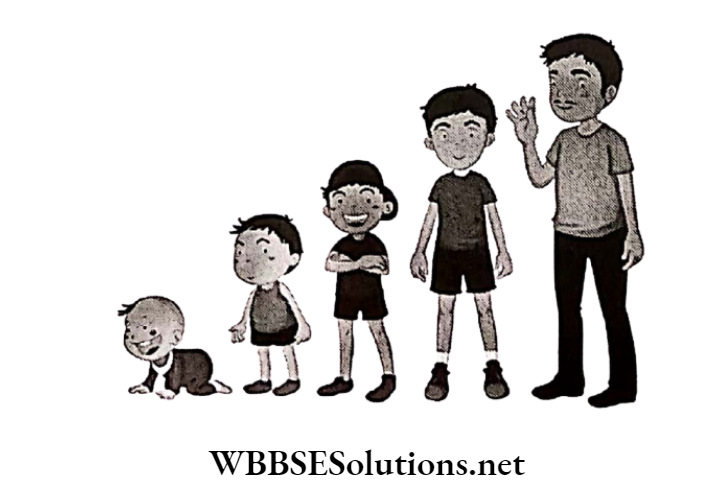
1. Infants/Babies (0-2 years)
This is a time for developing the bonds that will last a lifetime providing the child with the inner resources to develop self-esteem and the ability to relate positively with others.
2. Toddlers/Pre-schoolers (2-5 years)
When a child takes the first step on his or her own, a new phase in development begins. At this stage, children are now free to roam around the world.
It is a time for active exploration of their environment.
Language development takes major leaps which leads to learning the names of objects of interest, the ability to ask for things, and as they discover their independent nature.
During this developmental stage, a major challenge is developing what psychologists call emotional regulation.
This is also a stage of rapid physical and intellectual development preparing these children for starting school which includes interacting cooperatively with peers while at the same time being able to compete physically and intellectually.
3. School-age children (6-12 years)
While toddlers and pre-schoolers need constant supervision, school-age children become gradually ready for more independence.
However, learning to make good choices and exercise self-discipline does not come easily for many. Parents need to impart a moral code that the child gradually internalizes.
As children struggle with these important tasks parents must be able to provide praise and encouragement for achievement but parents must also be able to allow them to sometimes experience the natural consequences for their behavior or provide logical consequences to help them learn from mistakes.
4. Adolescents/Teenagers (13-18 years)
It is a time to really begin defining one’s self and realistically contemplating the future. Skill development is accelerated to prepare for college or job training programs.
Talents are perfected. Social skills are honed and relationships take on more of a serious nature. Peer pressure is at its maximum and in today’s teen society there are more tempting sidetracks than ever.
During adolescence, kids need their parents more than ever.
With age, children grow both in weight and height. Their rates of growth are not uniform throughout the whole of childhood.
Growth in the first few years of life is very rapid, and then it slows down later.
Another spurt of growth their birth weight at 5 months and treble it at 1 takes place in adolescence. Most babies have a double year.
While the average length of the baby at birth is about 50 cm (20 inches), it rises to 75 cm (30 inches) at 1 year, i.e., one and a half times more than at birth.
Boys, even in infancy, tend to be taller, heavier and grow faster than girls do. There is a lot of difference in height and weight of children at different ages.
There are also significant variations in the height and weight of children from different regions and communities in a vast and diverse country like India.
The expected average weight and height of Indian children of different ages are given below:
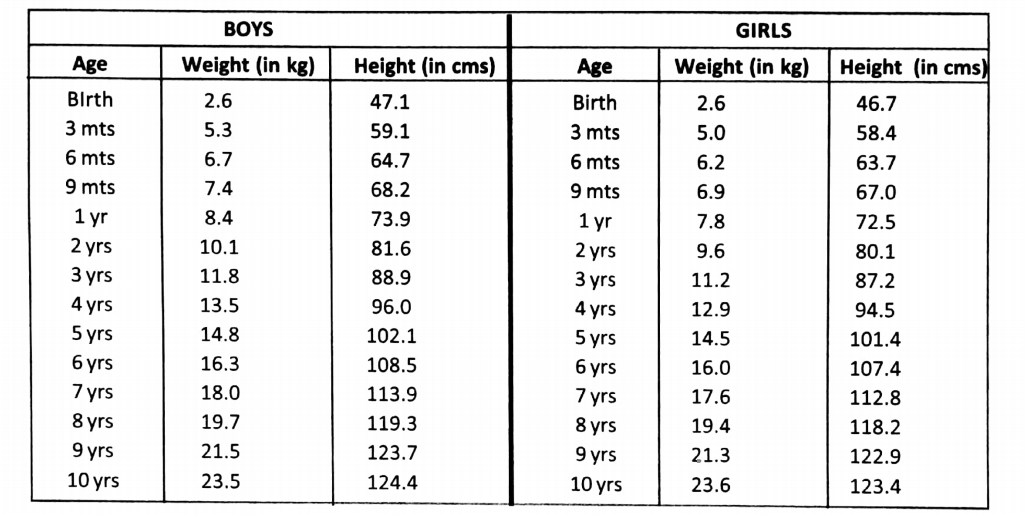
Abnormal development:
Fairy tales are filled with stories of giants and little people. The stories were written hundreds of years ago, and they sometimes tried to explain why these people looked different from others around them.
These old-fashioned fairy tales might have been different if the writers had known what today’s doctors have learned about growth.
What is Growth Disorder? Everyone grows and matures differently. You may be taller than your best friend in fourth grade. But then in sixth grade, your best friend may be an inch taller than you.
Usually, this is totally normal. A growth disorder, however, means that a kid has abnormal growth-for example, growing a lot slower or a lot faster than other kids at the same age.
What is Normal Growth? If growth is not the same for all kids, how do doctors know what is normal? By feet and inches (or meters and centimeters).
Over the years, lots of height and weight measurements have been taken for lots of children of different ages.
These measurements have been put together in what is called a standard growth chart, which tells doctors about how most kids grow.
From the time you were a baby; your doctor has weighed and measured you whenever you have had a checkup.
Because kids grow differently, your doctor checks your height against the standard growth chart.
If you are in the 50th percentile on the growth chart, it means half of the kids of your age are taller than you are and half are shorter.
If you fall in the 25th percentile that means 75% of the kids of your age are taller and 25% are shorter, and so on.
But some children who are under the 3rd percentile or over the 97th percentile, or who are growing a lot slower or faster than most other kids, may have a growth problem. In this situation, the doctor will usually want to check things out.
One thing your doctor will want to know is how tall your mother and father are and how they grew when they were children.
You may have inherited short or tall genes from them. You may also have inherited the tendency to have your growth spurt earlier or later than most other kids do.
Problems with puberty:
Glands in your body produce chemical messengers called hormones. Normal increases in the amounts of some of these hormones being produced trigger the changes your body goes through during puberty.
Puberty is the stage of your life when sexual development happens, like breast development and menstrual periods in girls and growth of the penis and testicles in boys.
One of the body changes that happen during puberty is a big increase in your rate of growth-a growth spurt.
When these changes happen before the age of 7 or 8 in girls or 9 in boys, it’s called precocious or early puberty.
At first, these kids may be taller than their friends. Later, however, they may stop growing sooner than most other kids do, and they may not become as tall when they are adults as they might have been otherwise.
Usually, kids with precocious puberty can be treated with medications that help correct this problem.
Delayed or late puberty occurs when the hormonal and body changes that should happen with puberty take place later than normal, or sometimes not at all.
Girls who have not begun puberty by age 13 and boys who have not begun by age 15 have delayed puberty and are sometimes called late bloomers.
When puberty finally occurs, either by itself or with treatment, these teens have a growth spurt and tend to catch up to their peers. Sometimes they even grow to be taller than their friends.
Hormones and Growth Disorders:
One of the glands in your body is called the pituitary gland. It’s found at the bottom of your brain and is shaped like a peanut. It may be small in size, but it’s pretty big in importance.
One of the chemical messengers the pituitary gland sends out to your body is called growth hormone, which is essential for growth.
When the pituitary gland doesn’t make enough growth hormone and sometimes other pituitary hormones as well, the condition is called hypopituitarism. This can slow down a kid’s growth.
Special tests can find out if kids don’t produce enough growth hormone. If they don’t, daily shots of growth hormone can often help them grow to be normal-sized adults.
Another gland that produces hormones important for growth is your thyroid. You may be able to feel it if you press gently with your fingers across the front of your neck, just under your Adam’s apple (elevated throat region of males).
It is shaped like a butterfly and moves up and down when you swallow.
Your thyroid makes a hormone called thyroxin. If it makes too little, the condition is called hypothyroidism.
Having too little thyroxin makes a kid grow more slowly. Doctors can do a simple blood test for hypothyroidism. If it’s needed, a kid can take the missing hormone as a pill.
Other reasons why kids might not grow normally:
Hormones play a major role in growth, but kids might not grow normally for other reasons, including:
1. Chronic diseases:
These include heart and kidney problems, cystic fibrosis, juvenile rheumatoid arthritis, and sickle cell anemia, which may slow growth in some cases.
2. Complications during pregnancy:
One of the reasons a pregnant woman is warned not to smoke or drink is because it may slow down her baby’s growth. A baby may be too small when it’s born and some remain small for life.
Some infections during pregnancy, other pregnancy problems, and certain. genetic diseases can also cause this problem.
3. Failure to thrive :
Some babies do not grow and gain weight normally after they are born. This is called failure to thrive (FTT). FTT may happen when a child simply doesn’t get enough to eat.
Some babies may have an illness that needs to be treated, but most will grow normally after they start
4. Genetic conditions:
Some genetics eating enough food. conditions can also cause children to not grow as they should.
Many of these growth disorders can be successfully treated today. With help, kids who might once have ended up very short can grow up more like other children.
Body Mass Index (BMI):
The body mass index (BMI) or Quetelet index is a value derived from the mass (weight) and height of an individual.
The BMI is defined as the body mass divided by the square of the body height and is universally expressed in units of kg/m2, resulting from mass in kilograms and height in meters.
The BMI is an attempt to quantify the amount of tissue mass (muscle, fat, and bone) in an individual, and then categorize that person as underweight, normal weight, overweight, or obese based on that value.
However, there is some debate about where on the BMI scale the dividing lines between categories should be placed.
The body mass index (BMI) is a statistic developed by Adolphe Quetelet in the 1900s for evaluating body mass.
It is not related to gender and age. It used the same formula for men as for women and children.
The body mass index is calculated based on the following formula:
BMI=\(\frac{Weight in Kilograms}{height in Metre2}\)
Example for 175 cm height and 70 kg weight: BMI-70/(1.75 x 1.75) = 22.86
The result is in kilograms by meter square, or kg/m2. BMI is a crude method to estimate obesity. Body Mass Index (BMI) is one of the ways to determine when extra fat accumulates.
translates into health risks. Body mass index is a measure that takes into account a person’s weight and height to gauge total body fat in adults.
The higher the body mass index, the greater the risk of developing additional health problems. The following chart describes the various categories of obesity based on body mass index
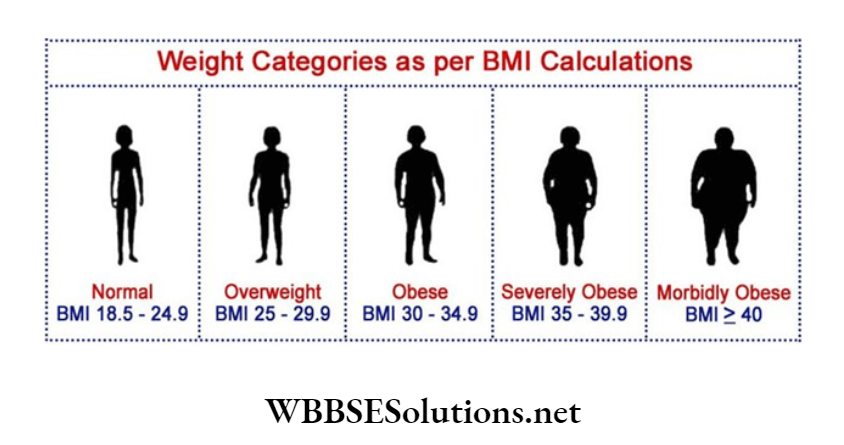
BMI < 15 (Excessively low weight)
BMI 16-18 (Low weight)
BMI 19-24.9 (Desirable)
BMI 25-29.9 (Overweight)
BMI30-34.9 (Obese, category 1)
BMI 35-39.9 (Obese, category 2)
BMI > 40 (Severe obesity)
Heart disease, diabetes, and high blood pressure are all linked to being overweight and obese.
Interesting Facts About Human Body
The human body is made up of a head, a neck, a torso (trunk), two arms, and two legs. The average height of an adult human is about 5 to 6 feet.
The human body is made to stand erect, walk on two feet, use the arms to carry and lift, and have opposable thumbs (able to grasp).
The adult body is made up of 100 trillion cells, 206 bones, 650 muscles, and 22 internal organs.
Every square inch of the human body has about 19 million skin cells.
In every hour about 1 billion cells in the human body must be replaced.
The average human head has about 100,000 hairs.
The average adult takes over 20,000 breaths a day.
The circulatory system of arteries, veins, and capillaries is about 60,000 miles long.
The heart beats more than 2.5 billion times in an average lifetime.
There are about 9,000 taste buds on the surface of the tongue, in the throat, and on the roof of the mouth.
The strongest (powerful) muscle in the body is the tongue.
The human heart creates enough pressure when it pumps out to the body to squirt blood bo 30 feet.
You blink over 10,000,000 times a year.
The human brain weighs about 3 pounds.
The brain uses over a quarter of the oxygen used by the human body.
Your heart beats around 100000 times a day, 36500000 times a year, and over a billion times if you live beyond 30.
Red blood cells carry oxygen around the body. They are created inside the bone marrow of your bones.
The color of human skin is determined by the level of pigment melanin that the body produces. Those with a small amount of melanin have light skin while those with a large amount have dark skin.
Adult lungs have a surface area of around 70 square meters.
Humans have a stage of sleep that features rapid eye movement (REM). REM sleep makes up around 25% of total sleep time and is often when you have your most vivid dreams.
Most adults have 32 teeth.
The smallest bone found in the human body is located in the middle ear. The stapes (or stirrup) bone is only 2.8 millimeters long.
Infants blink only once or twice a minute while adults average around 10.
As well as having unique fingerprints, humans also have unique tongue prints.
The left side of your body is controlled by the right side of your brain while the right side of your body is controlled by the left side of your brain.
Antibiotics are only effective against bacteria; they do not help in fighting off a virus.
It takes about 12 hours to completely digest eaten food.
Your sense of smell is around 10000 times more sensitive than your sense of taste.
It takes about 20 seconds for a red blood cell to circle the whole body.
One-fourth of the bones in your body are in your feet.
The blood processing in the kidneys amounts to some 1.25 liters a minute, or 1800 liters a day (1.25 × 60 × 24 = 1800), which is about 400 times the total blood volume and roughly one-fourth the volume pumped each day by the heart.
Every 24 hours, 170 liters of water is filtered from the bloodstream into the renal tubules; and by far the greater part of this- some 168.5 liters of water together with salts dissolved in it is reabsorbed by the cells lining the tubules and returned to the blood.
In a 24-hour period, an average man eliminates only 1.5 liters of water, containing the waste products of metabolism, but the actual volume varies with fluid intake and occupational and environmental factors.
WBBSE Notes For Class 6 School Science Chapter 7 Statics And Dynamics Of Fluid
Chapter 7 Statics And Dynamics Of Fluid Liquid And Gas Concept Of Pressure
You have come across the concepts of force, weight, and the measurement of area. A body on earth’s surface experiences the force of gravitational attraction and this gravitational force is called the weight of the body.
The weight of our body acts through our feet as we stand on the ground. Now imagine a situation wherein you are asked to walk on pebbles in bare feet.
It’s painful, isn’t it? Surely you would try to jump over to sand in order to get rid of the pain, as walking on sand is not painful.
Since you are the same in both cases (meaning your weight does not vary), what causes it to be painful to walk on pebbles rather than on sand? It’s the pressure. How is the pressure to be defined and measured?
amount of force that is put on your foot and the area over which the force is applied.
Read And Learn More: WBBSE Notes For Class 6 School Science
Since pressure = force/area, the same force on a smaller area means more pressure and vice versa.
When you are walking on sand, the weight of your body is spread out over the entire surface of your foot as the whole of your foot touches the ground as you walk on a flat surface like sand.
Therefore, there is relatively little pressure on any one point (since pressure = force/area). When you step on pebbles it is an entirely different story.
Pebbles have pointed projections that lead to a lesser contact area of your foot touching them while you walk on them. Instead of spreading the pressure over.
Pressure:
Force per unit area of surface is your whole foot, much more of the pressure is called pressure.
Pressure Force/Area.
The SI unit of force and area are Newton and square metres respectively. Hence SI unit of pressure shall be Newton per square meter.
It is also called Pascal or Pa. Multiple of Pascal is kilo Pascal.
1 kilo Pascal = 1000 Pascal = 1000 Newton per square metre.
Now we shall go back to the previous example and try to analyze what causes more pain to walk on pebbles than on sand and how is it related to pressure.
This is because of the applied to the small area that is actually touching the pebble. So, more pressure applied on a given area of your foot causes more pain.
Let us take another example. Try to hit two nails-one having a blunt end and another having a sharp end into a wooden block by a hammer.
You would observe that the sharp-ended nail penetrates the block more easily than the blunt-ended one.
Since the area of the sharp-ended nail is less compared to the blunt-ended one, it generates more pressure for penetration than the other nail and thus penetrates relatively easily.
A simple calculation will clarify the issue. Let us assume that the length, breadth, and height of a block be 3 m, 2 m, and 0.5 m respectively.
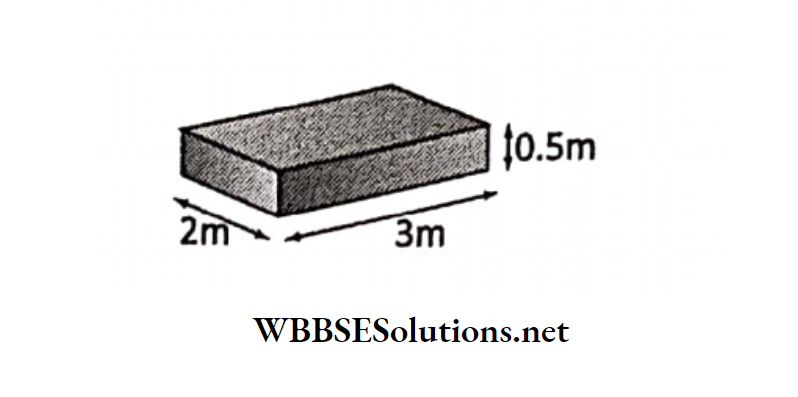
If the block weighs 60 N and is lying on a surface on its side with an area of 2 m by 3 m, what is the pressure exerted on the surface by its weight?
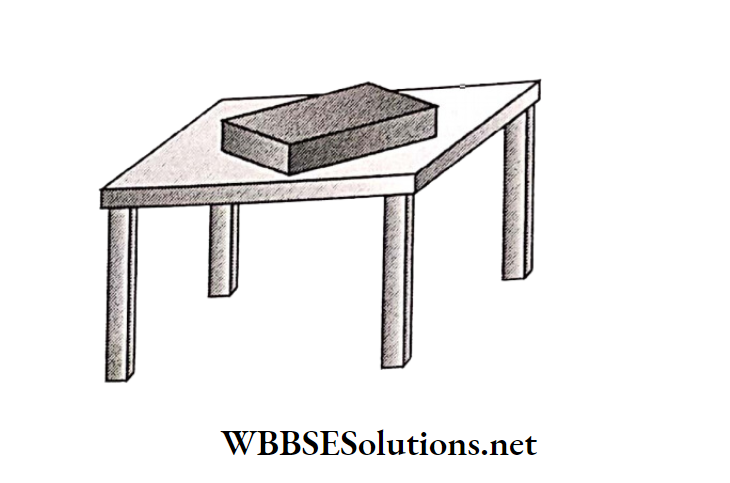
Pressure Force + Area.
So, P=60N+(2 mx3 m)=60N+(6 sq.m)=10 N/sq. m or Pa.
If the same 60 N block is now lying on its end which is 2 m x 0.5 m, then the pressure, biopic would be,
P = 60 N ÷ (2m x 0.5 m) = 60 N÷ (1 sq.m) = 60 N/sq.m or Pa.
Now you see that although the force remains the same, pressure increases by 6 times in the latter case as the area of the block coming in contact with the surface reduces by 6 times.
Chapter 7 Statics And Dynamics Of Fluid Liquid And Gas Application of Pressure
A few applications of pressure in our life:
1. A sharp knife cuts more easily than a blunt knife. That is why the cutting edge of a knife is made sharp.
A sharp cutting edge results in the cutting force distributed over a small area creating a large pressure. This makes cutting easier.
2. It is not easy to walk wearing high heel shoes. High heel shoes distribute a large amount of force in a small area and hence make it feel uncomfortable while walking on the ground.
3. Have you figured out why camels have large feet? Camels need to be able to walk around on sand without sinking into it. This means that they need to reduce their pressure on the ground.
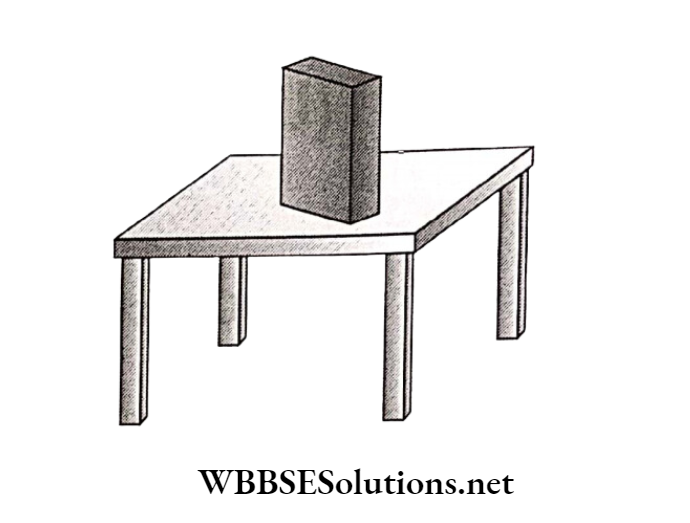
4. Porters place a round piece of cloth on their heads when they have to carry heavy loads. blu By this they increase the area of contact of the load with the head.
So the pressure on their head is reduced and they find it easier to carry the load.
5. Needles, screws, pins, and nails are made not sharp and pointed in order to reduce the Effective area of their working surface to generate more penetrating pressure.
This helps to pin up the papers or sew the cloth or penetrate planks, etc.
Chapter 7 Statics And Dynamics Of Fluid Liquid And Gas Pressure in Fluids
Any substance which has no fixed shape and can flow is called fluid. All liquids and gases are regarded as fluids.
Do fluids exert pressure? Does it also depend on the area on which the force acts? We have seen that a solid exerts pressure on another surface on account of its weight.
Similarly, a fluid has weight and hence, it exerts pressure on the walls of the container in which it is kept or enclosed.
It may be demonstrated as shown in means that they need to reduce their Dit pressure on the ground. Large feet mean a large area of contact and thus less pressure.
A piece of thin and good quality rubber sheet may be tied tightly over at one end of a long glass tube.
While holding the glass tube in the middle and in an upright condition, some water may be poured into the tube.
It would be seen that the rubber sheet would bulge out indicating that Statics and Dynamics of Fluid (Liquid and Gas) water exerts pressure.
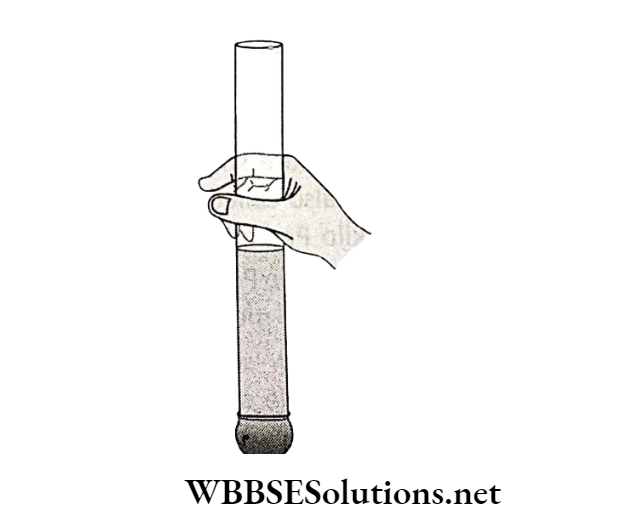
While walking down the streets you must have come across situations. where fountains of water are seen to come out of the leaking joints or holes in municipal water pipes supplying water to the city.
This happens due to the pressure exerted by the water on the walls of the pipes. When you inflate a balloon, you have to tightly close the mouth immediately or else the balloon deflates rapidly leaking out all the air.

A balloon having holes on its surface can not be inflated. This proves that air or for that matter, gases, too, exert pressure on the walls of the container.
However, unlike solids, a fluid exerts pressure in all directions. This may be demonstrated using an empty plastic water bottle. The bottle may be filled with water.
If several holes are made all around near the bottom of the bottle, water would be seen coming out of the holes.
If fingers are placed in the holes, one can feel the force of water acting on the fingers. The same thing occurs at various points on the surface of the bottle.
This proves that water contained in the bottle exerts force or thrust below its free surface at all points on the surface of the bottle.
The force per unit area at any point gives the pressure of water at that point.
The pressure which a fluid exerts on the sides of the containing vessel, below its free surface, is called lateral pressure and the pressure at the base of the vessel is simply called pressure.

Chapter 7 Statics And Dynamics Of Fluid Liquid And Gas Atmospheric Pressure
The envelope of air surrounding us is called the atmosphere. It extends up to many kilometers above the surface of the earth. The pressure exerted by this column of air is known as atmospheric pressure.
If we imagine a unit area on our head as shown in and a very long cylinder standing on it filled with air, then the weight of air belonging to this cylinder shall be the atmospheric pressure.
The reason we are not crushed under this weight of the air column is that the pressure inside our bodies is also equal to the atmospheric pressure and it cancels the pressure from outside.
Why do some passengers suffer from nose bleeding in pressurized aircraft cabins? As the altitude increases.
The air pressure decreases around passengers and therefore this can cause nose bleeding in some cases since the pressure inside the human body becomes more than that at the outside at higher altitudes.
The cabin is pressurized but not as much as it is at sea level. Therefore, it’s common among many people to have nose bleeding and is not usually a serious problem.
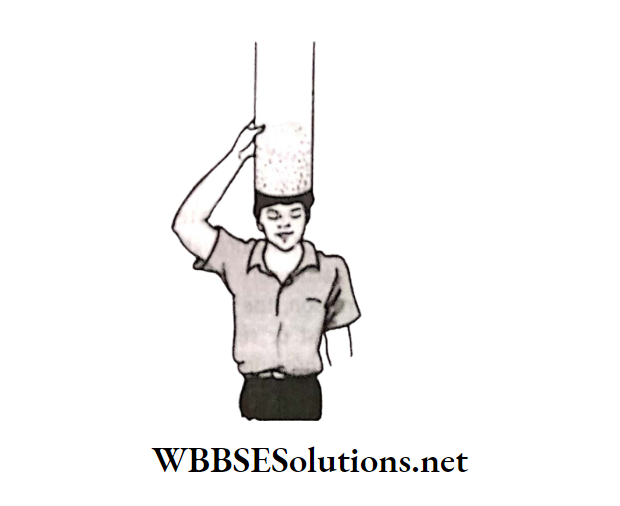
Chapter 7 Statics And Dynamics Of Fluid Liquid And Gas Effect of Pressure
There are certain laws of liquid pressure. These are as follows:
- Pressure at a point inside the liquid increases with the depth from the free surface of the liquid.
- Pressure is the same at all points in a horizontal plane at a given depth within the liquid.
- A liquid flows from a place of higher pressure to a place of lower pressure.
- A liquid seeks its own level.
Now we would explain one after another with simple demonstrations. Let us take the first law which states that pressure increases with the depth of a liquid from the free surface.
Let us prove it with the following example. A plastic bottle filled with water may be taken similar to the one shown earlier.
Three holes shall be made in the bottle one above another from top to bottom in a line.
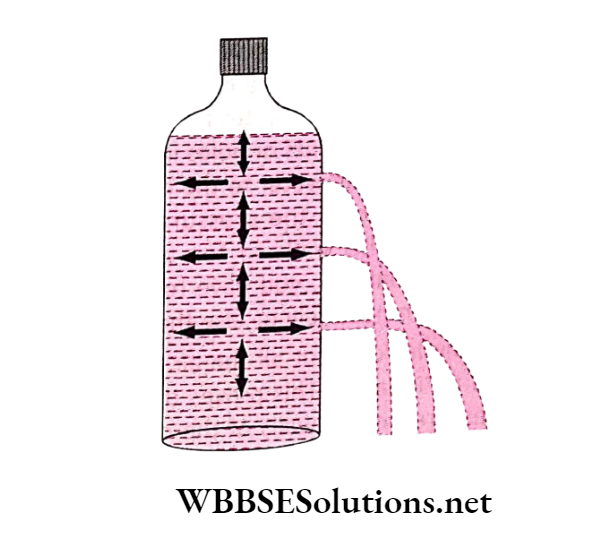
It would be found that the flow of water from the bottommost hole travels furthest because the pressure exerted at this point is the highest since this hole is situated at maximum depth from the free surface of the water.
Earlier, we saw that if some water is poured into a glass tube while holding it in the middle in an upright condition with a stretched rubber sheet tied at its end, the rubber sheet bulges out due to the pressure of water.
Now if some more water is poured into the tube it would be seen that the amount of bulge increases.
So there is a direct relation between the amount of bulge or pressure exerted by water and the height of the water column.
This proves that pressure at a point inside the liquid increases with the depth from the free surface of the liquid.
If two completely filled containers are taken having varying depths, the pressure at the base is greater whose depth is greater.
When these two containers are joined by a pipe, water or liquid flows from the container having greater depth to the other one. This applies to gas also.
Thus a fluid (gas or liquid) flows from a place of higher pressure to a place of lower pressure. This fact is made use of in supplying water to the different parts of a city.
Drinking water is raised with a pump to the main reservoir placed at such a great height that taps, tanks, etc in domestic and public uses at different parts of a city are much below it.
From the reservoir, the main pipe goes through the city and smaller pipes branch off from the main pipe and are led to different houses in the city.
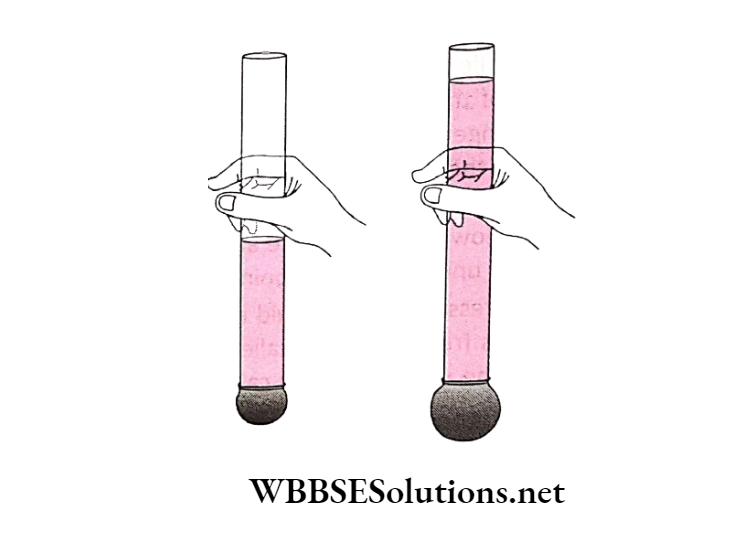
Since liquid flows from a higher level to a lower level, when water from the reservoir is allowed to flow through the pipes, water would easily reach every house in the city.
Due to the same reason, the pressure of water at the tap on the first or second floor of a house is less than the pressure on the ground floor.
Now come to the second law which states that pressure is the same at all points in a horizontal plane at a given depth within the liquid.
This point can be demonstrated by the experiment with the same plastic bottle as described earlier.
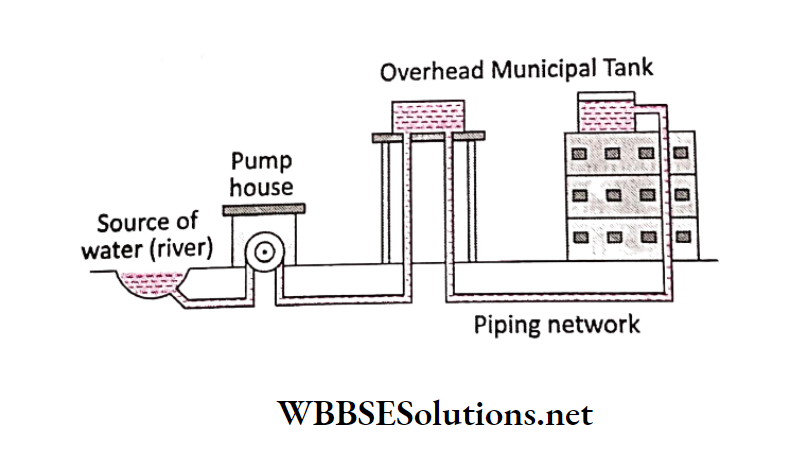
If several holes are made at the same depth from the free surface of the liquid, it would be seen that the flows of water from all the holes travel the same because the pressure exerted at this horizontal level is the same for all the holes.
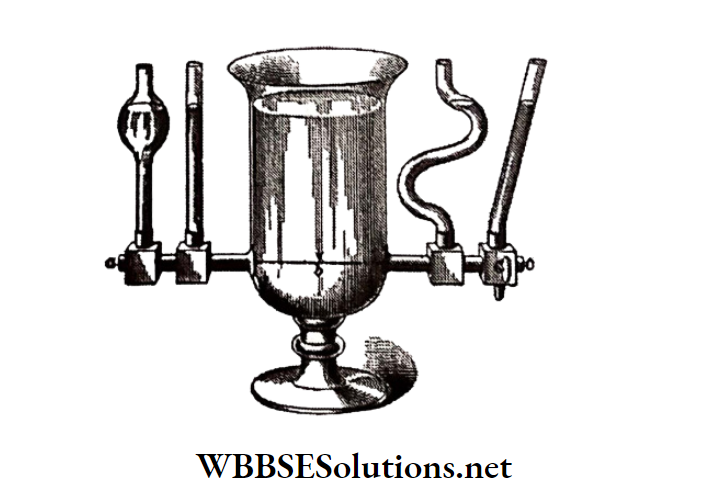
To prove that a liquid seeks its own level, a peculiar-shaped apparatus may be taken which consists of a number of tubes of different shapes and sizes connected together at the bottom.
This vessel is known as communicating vessel since a number of tubes/vessels are in communication with one another.
If water is poured into one of the tubes, then water flows into each tube till the water level in all the tubes become equal. The surface of the water in every tube is found to be horizontal.
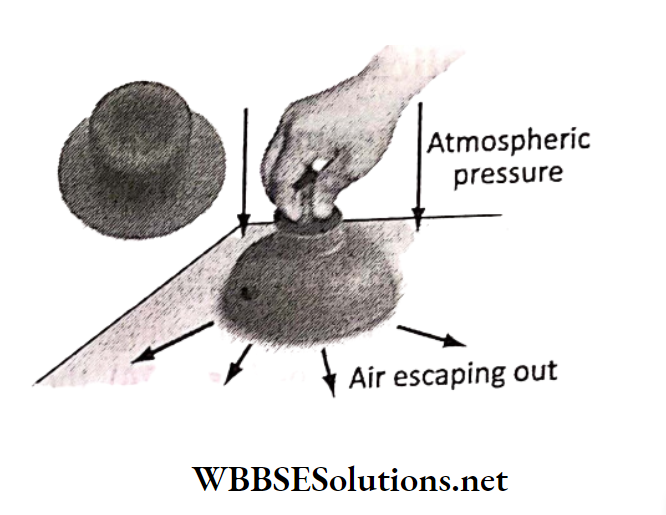
The effect of atmospheric pressure can be easily demonstrated with the help of a rubber sucker. It looks like a small rubber cup.
If it is pressed against a smooth hard surface like the glass table top, it gets stuck to the surface.
It now becomes difficult to pull it out of the surface. As the sucker is pressed, most of the air between it’s cup and the hard surface escapes out.
The sucker sticks to the surface because of the outside pressure of the atmosphere that acts on it.
To pull the sucker off the surface, the applied force should be large enough to overcome the atmospheric pressure.
Chapter 7 Statics And Dynamics Of Fluid Liquid And Gas The Concept Of Bernoulli’s Principle
You know the behavior of a river in a wide, unconstricted region, it flows slowly, but if its flow is narrowed by canyon walls (for instance), then it speeds up dramatically.
Now imagine that fluid moves from a wider pipe to a narrower one. Certainly, the volume of that fluid that moves a given distance in a given time period does not change.
But since the width of the narrower pipe is smaller, the fluid must move faster in order to achieve that result.
Bernoulli’s principle states that a slow-moving fluid exerts more pressure than a fast-moving fluid.
Since “fluid” in this context applies equally to liquids and gases, the principle has as many applications with regard to airflow as to the flow of liquids.
We shall illustrate the above principle with another example. Suppose there is a room full of children.
If each child is asked to run at top speed, children will start bouncing off each other and the walls resulting in a number of collisions.
Now if those same children are taken out of the room and again asked to run down a wide hall at top speed, they would be all said? running together.
This time all collisions between children are much more gentle than before since they are all running in the same direction.
The children in both cases may Be taken as the atoms in the fluid and the force of the collisions represents the pressure between those atoms.
In the first case, when the speed of the group as a whole is zero, the jostling (or pressure) is high. In the second case, when the speed of the group as a whole is large, the jostling (or pressure) is low.
Hence Bernoulli’s conclusion The slower the rate of flow of a fluid, the higher the pressure, and the faster the rate of flow, the lower the pressure.
Take a piece of folded paper and hold them. in front of your mouth. Blow air in between the. papers, as shown in The papers, come.
closer instead of going apart. When air moves faster in between the papers (due to blowing), the pressure decreases in that region. The force.
exerted by air outside the papers act perpendicular to the outer surface of the two sheets and push them together.
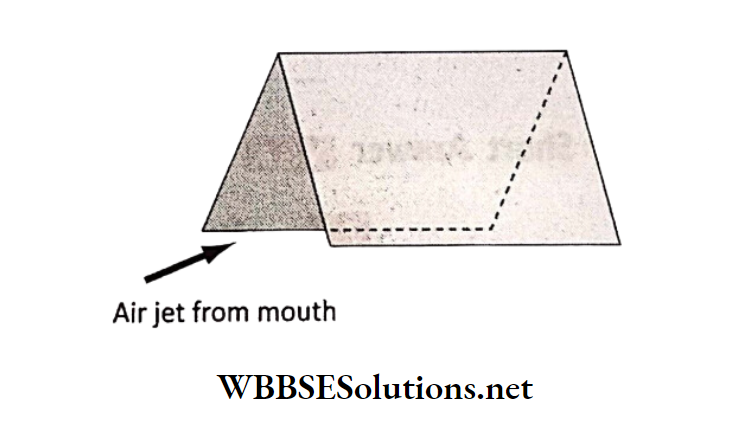
Chapter 7 Statics And Dynamics Of Fluid Liquid And Gas Application Of Bernoulli’s Principle
One of the most common everyday applications of Bernoulli’s principle is in air flight. The main way that Bernoulli’s principle works in air flight has to do with the architecture of the wings of the plane.
In an airplane wing, the top of the wing is somewhat curved, while the bottom of the wing is totally flat. While in the sky, air travels across both the top and the bottom of the wing concurrently.
Because the top part and the bottom part of the wing are designed differently, this allows for the air on the bottom to move slower, which creates more pressure on the bottom, and allows for the air on the top to move faster, which creates less pressure.
This is what creates a lift, which allows planes to fly.
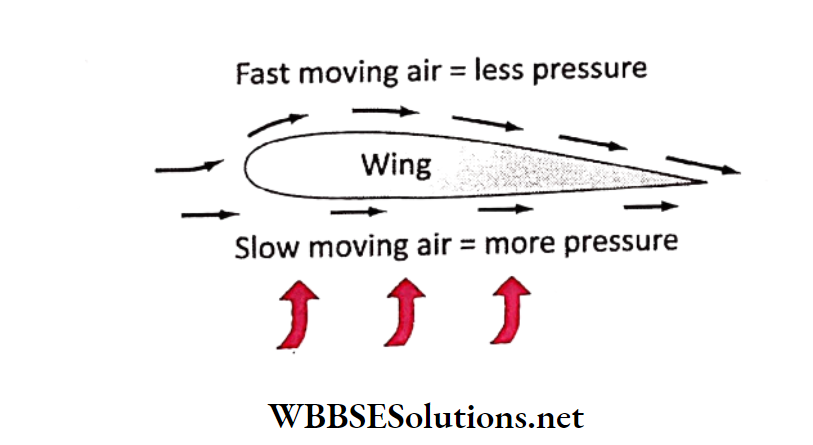
A person standing near the railway track is pulled towards the train when a fast-moving train passes close to him. The fast-moving train decreases the pressure between the person and the train.
Due to the greater pressure on the other side of the person, the person gets pushed toward the railway track.
This is why people are warned to move away from the edge of the platform when a fast-moving train is supposed to pass through it without stopping.
Tornados do not tear off roofs. It is the higher air pressure inside the house that exerts a force on the roof to lift it.
The faster the outside air moves, the lower its air pressure, and the greater force on the roof results from within. As long as the inside and outside air pressures remain the same, the roof stays up.
If the outside pressure is lowered significantly by the high winds of a tornado, the ceiling just lifts up, like a bird’s wing due to the greater atmospheric pressure below the roof.
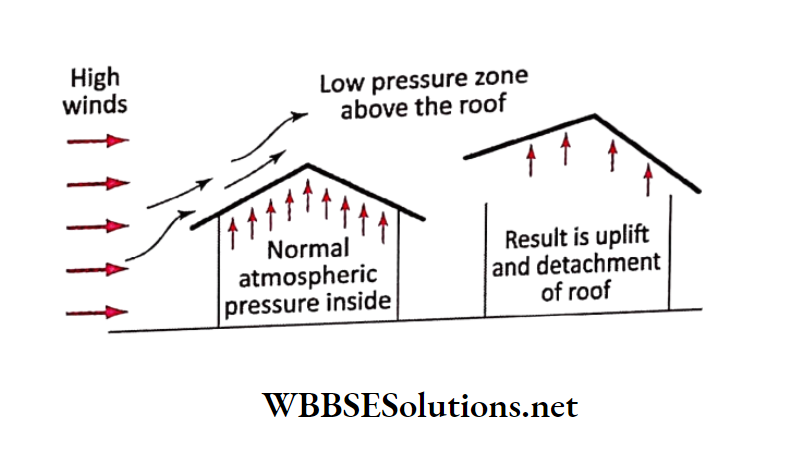
If the area of the cross-section at one end of a hose pipe is reduced by pressing with a finger, the velocity of water flow increases there.
This happens because due to the decrease in the cross-section of the pipe, the pressure of water is decreased there.
So, according to Bernoulli’s theorem, the velocity of water flow increases there. For the same reason if the area of the mouth of a water tap is reduced with a thumb, water from the tap falls with more speed.
WBBSE Notes For Class 6 School Science Chapter 6 Primary Concept Of Force And Energy
Chapter 6 Primary Concept Of Force And Energy Concept Of Rest And Motion
In our daily life, we come across various objects; some of them move but others remain where they are. Suppose you enter a room.
A chair lying in the room does not move or change its position with respect to the surroundings of the room. We say that the chair is in a state of rest.
Now coming out of the room you go to your balcony and see a car speeding along the road from there.
It means that the car is changing its position with respect to you and your building both of which are stationary. Thus the car is in a state of motion.
Hence objects around us can either be in a state of rest or in motion. Let us define rest and motion to get a clear idea
Read And Learn More: WBBSE Notes For Class 6 School Science
Rest:
When an object does not change its position with respect to its surroundings, the object is said to be at rest.
Motion:
When an object changes its position with respect to its surroundings, the object is said to be in motion.
Thus objects associated with the states of rest and motion are known as stationary and moving objects respectively. These may be defined as
Stationary object:
An object which does not change its position with respect to time is called a stationary object.
Moving object:
An object which changes its position with respect to time is called a moving object.
Seemingly, rest and motion are opposed to each other, yet there is a close relation between them and it is very difficult to say, whether an object is in a state of rest or in a state of motion.
Think about the fact that whenever we describe the motion of a body or object we knowingly or unknowingly take another body to be at rest.
In fact to measure the distance traveled by a body or how fast the body is moving, we require another body at rest to do so.
For example, we say a car is moving speedily on the road. But how can we say that? The answer is that here the road is taken to be at rest and the car is described to be moving on the stationary road with a certain speed.
Let us take another somewhat more difficult instance. A boy is found running along the corridor of a moving train.
How can we describe his motion when both the train and the boy are moving together? Actually here, to describe the motion of the boy.
The train is assumed to be at rest and the distance of the moving boy is compared with respect to a certain object inside the train, say, the door of the compartment on one side.
This simplifies our understanding of rest and motion. Again let us analyze a somewhat similar sort of situation.
When traveling in a train we can very well say that we are at rest inside the compartment (since we are sitting inside it).
But somebody standing on the platform of a station says a different story since he sees that we are moving at a certain speed.
Who is correct then? In fact, both of them are correct.
The confusion arises since they are describing the same situation standing at different locations (for us it is the compartment of the train and for the man, it is the platform outside the moving train).
We are at rest if the train is supposed to be at rest and on the other hand, we are moving if the platform is supposed to be at rest.
Thus we see that the description of the motion of a body (static or dynamic position) changes if the location of the viewer changes.
Always noiensmib remember that the location of the viewer is of utmost importance in any description of motion.
Chapter 6 Primary Concept Of Force And Energy Concept Of Force And It’s Unit
The use of the word ‘force’ is very common in our daily life. We use force to walk on the ground, lift a bucket full of water, push a heavy bookshelf, or throw a cricket ball.
In fact, it is our common experience that unless we apply force on a stationary body, it will not move out on its own and will remain stationary forever.
On the other hand, it is equally true that a moving body will continue its motion forever along a straight line unless it is disturbed by some force.
But unlike the previous case this time our senses cannot accept it since we never see such a motion.
Does a moving ball continue to roll forever? Before answering the puzzle let us discuss a commonly observed phenomenon.
You must have noticed that if a ball is rolled on a smooth floor, it goes further than it goes on ordinary ground.
Why does it happen like that? Actually, a ball gets various sorts of resistance while it is in motion-some may be due to the nature of the ground or floor and others may be due to the air surrounding the ball.
All these invisible resistances are actually forces that try to stop the motion of the ball. A ball thus does not roll forever because external forces retard the motion of the ball.

A smooth floor offers less retarding force compared to the ground and hence the ball goes further on it.
In this way, we can make a conception that if the external force be eliminated, the force-free ball would go on moving in a straight line forever.
Hence the lesson we get from the discussion is that an external force is required to change either the state of rest or of motion of a body.
A force can thus make a body move, or make a moving body stop, or make it move slower or faster, or change the direction of motion of the moving body.
Force:
A force may be defined as an external cause that changes or tends to change the state of rest or of the uniform motion of a body in a straight line.
In the CGS system, a unit of force is called dyne. In the SI system, the unit of force is called Newton.
carefully observe the fact that the word ‘force’ There are different types of forces, but generally denotes a push or a pull.
We can exert and apply a push through something rigid, while a push and pulls. We must pull can act through a non-rigid connector such as a rope or a wire.
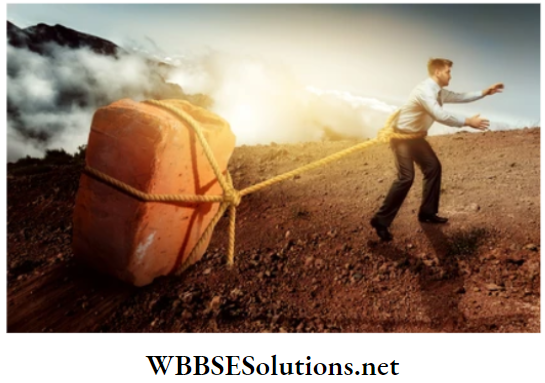
Chapter 6 Primary Concept Of Force And Energy Effects Of Force
A force can bring about the following effects as shown below:
1. It can set a stationary body into motion.
- A railway engine can move a stationary train by applying a pull or push.
- A boy can set a ball into motion by hitting it with a bat.
2. It can stop a moving body.
- A speeding car is stopped by the application of brakes.
- A boy can stop a rolling football directed towards him in the field.
3. It can change the speed or direction of the old movement of a moving body.
- A moving bicycle runs faster when
- A stone is thrown vertically upward slows down after attaining a height, Sal changes its speed and stops for an instant
4. It can bring about change in the dimensions of a body
A stretching force increases the length ady of a rubber band. A compressive force shortens the length of a spring
Chapter 6 Primary Concept Of Force And Energy Force Without Touch
Push and pull were discussed earlier. These forces are to be applied through something rigid or non-rigid. Hence these are called contact forces.
There are other forces that do not make contact with the objects and yet act on them through space. These are called non-contact forces or forces at a distance.
Gravity is an invisible force, with which a body is attracted or pulled towards the earth. There is nothing attached to the body by which the force is applied.
A body on the earth’s surface is in a very strong gravitational field of earth and hence, the body experiences the force of attraction due to the earth’s gravity.
This gravitational force is called the weight of the body. It has the same units as those of force stated earlier.
Another example of the non-contact type of force is found in a magnetic field. When a magnet attracts another magnet or a magnetic substance (such as Iron, Cobalt, Nickel, etc.), there is nothing visible, which is pulling them together or separating them.
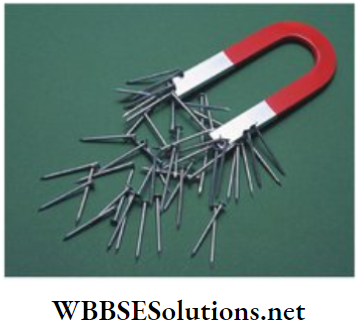
Thus around a magnet, there is a magnetic field that is responsible for this type of non-contact force. The magnetic field pushes or pulls other magnets or magnetic materials.
Electromagnetism and nuclear force are other two examples of non-contact forces.
Electromagnetism is the force that causes the interaction between electrically charged bodies or between an electrically charged body and a magnet.
The area inside which this force is active is called the electromagnetic field. The nuclear force is active between fundamental particles like protons, neutrons, etc inside the nucleus of an atom.
It is charge independent. However, its range is very very small compared to gravity and electromagnetic forces.
Based on the above examples some characteristics of non-contact type of forces may be mentioned as under :
- The gravitational force is always attractive in nature, while the electromagnetic, magnetic, and electrostatic forces can be either attractive or repulsive.
- The non-contact forces depend on the distance of separation between the bodies. It decreases with the increase in separation and increases with the decrease in separation.
- These are action-reaction types of forces,90107 to atole. they are mutual.
- The forces may be long-range or short-range forces.
Chapter 6 Primary Concept Of Force And Energy Concept Of Energy Its Different Forms Energy Sources And Energy Crisis
When we wake up in the morning after a good night’s sleep we are full of capacity to start
the day’s work. As the day progresses, gradually our capacity to do work diminishes.
At night our capacity reduces to a minimum. We say that we are extremely tired since our energy is exhausted throughout the day in doing various jobs.
Similarly, if we do not eat for a long time, we feel tired and hence lose the capacity to do any work. These happen due to a lack of energy.
Thus energy may be defined as follows:
Energy The capacity of a body to do work is called energy.
Chapter 6 Primary Concept Of Force And Energy Types of Energy
For the sake of understanding, energy is divided into two kinds: Kinetic energy and Potential energy.
A shooting arrow can pierce through a log. A wall may collapse if a speeding car collides with it. A stone thrown towards an earthen pot from a distance can break it when it hits it. These are known to us.
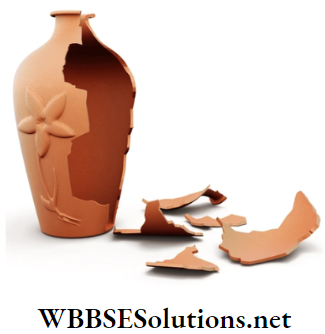
Now think about the above cases in a different way. Can an arrow pierce a log if it vans gently touches it?
Can a wall collapse if a comes in contact with it extremely slowly Can a stone break a pot if it is gently kept on it? The answer is ‘no’ in all the cases.
What then is the cause behind these phenomena whereby a work is done by a moving body? The arrow, the car, or the stone acquires kinetic energy due to motion by virtue of which they are able to perform the intended work.
Hence, when a body does work by virtue of its motion, it is said to have kinetic energy.
Similarly, the destruction of huts by fast-blowing stormy wind, carrying of load by running water in its path, etc., are other indign examples of kinetic energy.
Let us now understand what is potential energy by an example. Keep a nail on a wooden plank. Gently touch the head of the nail with a hammer.
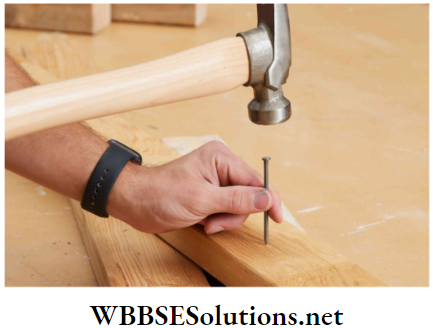
Nothing happens. The nail does not penetrate into the plank. The hammer sainerbandiser ofni bolondr af ygrone fralstoola nin s 19ns frant una lesinedasin is now raised a bit and the nail is hit with it i botrovic.

It is seen that the nail gets penetrated into the plank. The change in position of the hammer makes it accumulate energy which does the work in the latter case.
Hence, if a body does work by virtue of its position or configuration, it is said to have potential energy. Another example may be a catapult and a stone.
The stone is set in the catapult by stretching the string. When the string is released, the stone flies off due to the stretched string.
Here it is the change of shape of the string which provides potential energy to the string to do work on the stone.
When a spring is pressed forcefully, it undergoes compression. Pressure changes the shape of the spring and it contracts.
Thus it gains potential energy. This potential energy develops an ability inside the spring to do some work. For this reason, it jumps away when the pressure is removed and it recovers its normal shape.
If a block is used to pressurize the spring, the block flies away as the spring elongates and jumps back to its normal shape and configuration.
Kinetic energy and potential energy are together called Mechanical energy.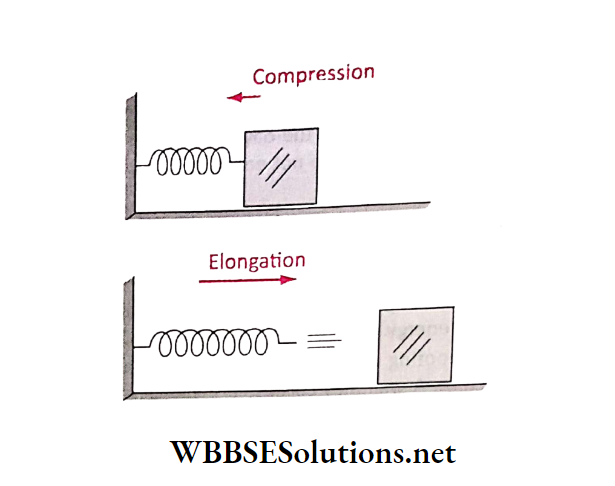
Chapter 6 Primary Concept Of Force And Energy Transformation Of Energy
In actual practice, there are 8 forms of energy prevalent in nature such as mechanical energy, heat energy, light energy, sound energy, electrical energy, magnetic energy, chemical energy, and atomic energy.
Whenever work is done anywhere in the universe, one form of energy gets converted to another form of energy. No new energy is created or destroyed in the universe.
1. Conversion of mechanical energy into other forms of energy:
- When palms are rubbed, the mechanical energy due to rubbing is converted into heat energy and palms become warm.
- During hitting a drum with sticks, mechanical energy is transformed into sound energy.
- When a knife is rubbed against the grinding stone mechanical energy changes into heat, light, and sound energy.
2. Conversion of heat energy into mechanical energy:
In a steam engine heat energy is converted into mechanical energy.
3. Conversion of electrical energy into other forms of energy:
- When a motor is run, electrical energy is converted into mechanical and heat energy.
- When a fan rotates, electrical energy is transformed into mechanical and heat energy.
- When light is put on, electrical energy changes into light and heat energy.
- During the charging of a battery, electrical energy is converted into chemical energy.
4. Conversion of light energy into other forms of energy:
- During photosynthesis, light energy is converted into chemical energy.
- In photovoltaic cells, light energy is transformed into electrical energy.
5. Conversion of chemical energy into other forms of energy:
- When fuels are burnt, chemical energy is converted into heat and mechanical energy.
- When the cracker explodes, chemical energy changes into heat, light, and sound energy.
- When water is poured on quick lime, chemical energy is converted into heat energy which vaporizes the water.
6. Conversion of magnetic energy into other forms of energy:
When a magnet attracts iron particles, magnetic energy is converted into mechanical energy.
7. Conversion of atomic energy into other forms of energy:
During nuclear fusion or fission, atomic energy changes into heat and light energy.
8. Conversion of sound energy into other forms of energy:
When an explosion occurs, sound energy is converted into mechanical energy and vibration occurs.
Chapter 6 Primary Concept Of Force And Energy Sources of Energy
All forms of energy which are available on Earth have their origin from the sun. The solar energy that Earth receives every day, gets transformed into various sources of energy.
The transformation of solar energy into other forms of energy is depicted in the flow chart. it may be described as follows:
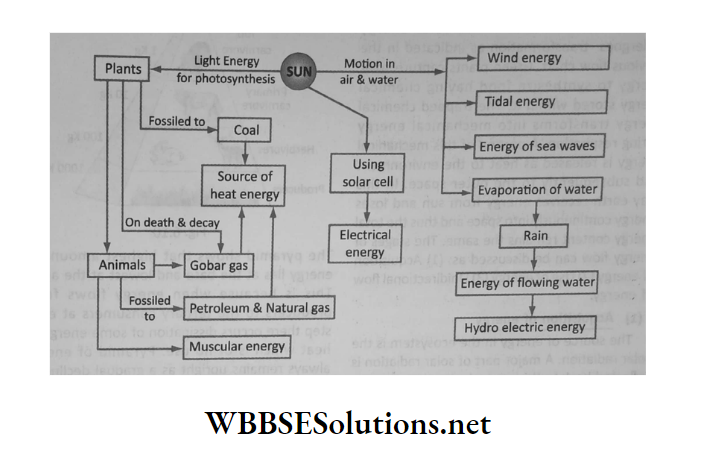
1. Solar energy is stored in green plants during photosynthesis as chemical energy. Hence they are termed as producers.
2. The chemical energy stored inside plants remains intact when they are buried for very long periods under the surface of the earth to form fossil fuels such as coal.
Coal is excavated out and used as a source of energy in thermal power plants or in domestic and other industrial sectors.
3. If the green plants do not form fossils after death, they can be converted into biogas. This process converts the stored chemical energy of dead plants into heat energy on burning.
4. When plants are consumed by animals, the chemical energy of plants changes into heat energy during respiration.
This heat energy supplies the necessary mechanical energy required to perform the daily work and keeps the body warm.
5. When animals die, their bodies get buried under the earth for a long period to be converted into petroleum and natural gas. These are the sources of heat energy for all industries and automobiles.
6. Remains of dead animals can be utilized to generate biogas.
7. Solar energy provides light energy which helps us to see things around.
8. Solar energy is directly converted into electrical energy by solar photovoltaic cells.
9. Solar energy provides wind energy, tidal energy, and energy from sea waves.
10. Solar energy maintains the water cycle. It causes large-scale evaporation of water from water bodies. The water vapor condenses to form clouds.
Clouds cause rain which ultimately creates running or flowing streams. The energy of flowing streams is utilized to produce hydroelectric power and to drive water mills.
Chapter 6 Primary Concept Of Force And Energy Concept of Energy Flow
The sun is the source of all energy. Energy never goes back to its source. In other words, the incoming solar energy to Earth never returns back to the sun.
The solar energy undergoes a transformation as indicated in the previous flow chart. Green plants capture solar energy to synthesize food having chemical energy stored within it.
The trapped chemical energy transforms into mechanical energy during respiration. A portion of this mechanical energy is released as heat to the environment and subsequently to outer space.
In this way, the earth receives energy from the sun and loses energy continuously into space and thus the total energy content remains the same.
The stages of energy flow can be discussed as:
- Acquisition of energy
- Use of energy
- Unidirectional flow of energy.
1. Acquisition Of Energy
The source of energy in the ecosystem is solar radiation. A major part of solar radiation is reflected back to space due to the presence of clouds, smoke, dust particles, etc.
Some portion of the solar energy is absorbed by the suspended solid particles of the atmosphere and some part is reflected by the surface of the earth.
Thus the remaining portion of the solar energy is entrapped by the chlorophyll of leaves where photosynthesis takes place.
As a result, light energy gets transformed into chemical energy and this chemical energy remains stored as potential energy inside the carbohydrate food matters produced by the green plants.
The green plants are called producers. Primary production is the amount and the rate of energy produced by the producers.
2. Use Of Energy
The transfer of energy takes place through the consumption of food. Producers are consumed by herbivorous animals and thus the potential energy of producers enters into the system of herbivores.
Herbivores are termed primary consumers. When carnivores feed on the herbivores they also acquire potential energy.
Thus the carnivores are termed secondary consumers. Thus when tertiary consumers consume secondary consumers, a similar flow? to School Science of potential energy takes place.
The representation of the energy flow in an ecosystem is called a pyramid of energy.
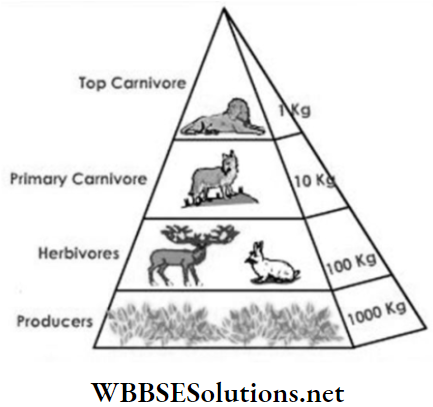
The pyramid shows that the highest amount of energy lies at the base and the lowest at the apex.
This is because when energy flows from producers to the tertiary consumers at each step there occurs dissipation of some energy as heat which is of no use.
The pyramid of energy always remains upright as a gradual decline of energy takes place from initiation to termination.
The energy stored by the various types of consumers in their tissues is known as secondary production.
The transfer of food energy from the source in green plants (producer) through a series of organisms (consumers) with repeated eating and being eaten occurs through the food chain.
The sequence of the eaters being eaten in an ecosystem is called the food chain.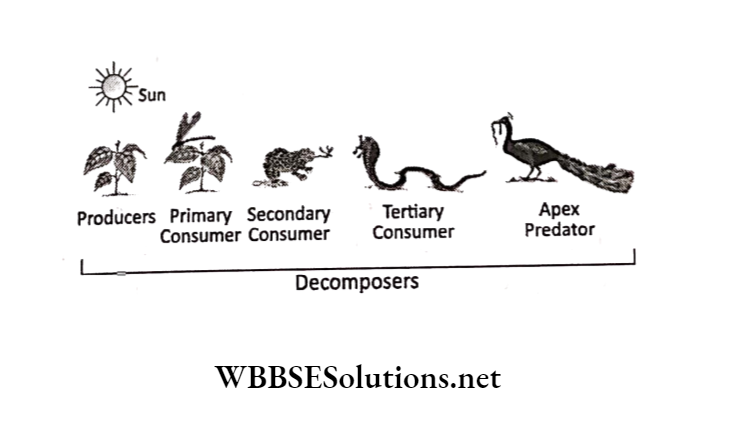
In an ecosystem the producer-consumer arrangement represents the trophic structure and each food level is called the trophic level.
Green plants at the base of the energy pyramid occupy the first trophic level.
Herbivores or primary consumers are second trophic level, carnivores or secondary consumers are at the third trophic level and tertiary consumers are fourth trophic level.
In the year 1942, Raymond Lindemann formulated the law called the 10 percent law.
According to this law, about 10% of total energy is transmitted during energy flow through several trophic levels to be used up for building the body mass, and the rest is dissipated as heat energy.
That is why we notice a diminution in the amount of energy from the first trophic level at the base to the fourth trophic level at the apex of the pyramid.
Energy used up by a body in order to function properly is called respiratory energy.
For example, 100 kg biomass in the grass will make 10 kg biomass for herbivorous animals (ex. Deer) and 1 kg biomass for carnivorous animals (ex. Tiger).
When different food chains of the same habitat are interconnected with each other to form a complicated network then the feeding relationship is known as a food web.
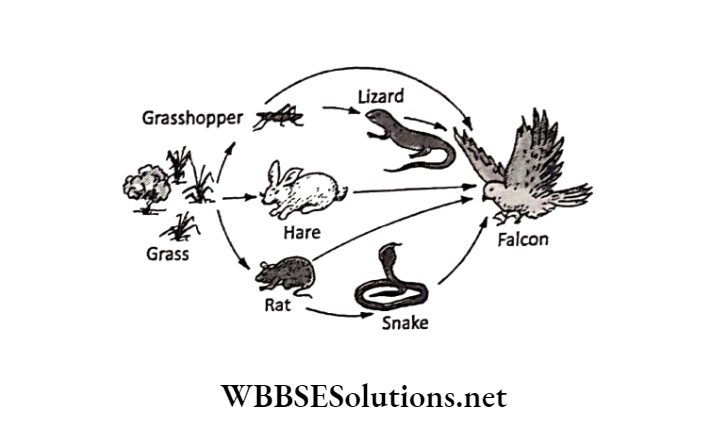
The interconnection and the inter-dependency in the food web make it more fundamental than the food chain.
Chapter 6 Primary Concept Of Force And Energy Energy Crisis
The energy needs of human beings are increasing day by day because the use of energy provides comfort to modern life. The increasing population is leading to the growth of cities.
This, coupled with technological innovations, is resulting in the setting up of more industries.
The growth of transport and the modernization of agriculture are putting a heavy demand on energy consumption.
Because of this heavy demand and limited resources, the prices of energy sources are steadily increasing.
The indiscriminate use of energy resources on the one hand is leading to an energy crisis and on the other hand to global environmental pollution.
Unless some clean and cheap sources of energy are developed this energy crisis is likely to continue.
There are two types of resources of energy:
1. Non-renewable resources and
2. Renewable resources.
1. Non-renewable resources The sources of energy that, once finished, can not be.
Hence food web is more stable than a food chain. It is through the food web only that one animal of a food chain depends on many animals of other food chains and also of different trophic levels as food.
Regenerated over a reasonable period of time are called non-renewable resources of energy. Coal and petroleum fall in this category.
2. Renewable resources The sources of energy which do not exhaust or can be grown over a reasonable period of time are called renewable resources of energy. These resources include solar, tidal, hydel, wind, biomass, etc.
The need for non-conventional or renewable energy sources arises because:
- It was the energy crisis of 1973 and 1978 which forced people to recognize the vulnerability of oil-based energy solutions all over the world and sincere efforts were undertaken to develop renewable sources of energy.
- Conventional sources of energy like coal, petroleum, natural gas, etc are non-renewable and they’re on a wide scale. use is invariably associated with severe environmental pollution.
- Hydroelectric power generation is limited by topography and seasonal factors.
- The use of wood in villages leads to deforestation.
- Renewable sources provide energy in a decentralized manner to small areas and can be cultivated in places where it is difficult to carry fossil fuels or power lines.
- Large-scale use of renewable sources of energy can enlarge the life spans of fossil fuels and thereby, can reduce the burden of future energy crises.
For this reason, to cater to the energy crisis, the whole world, including India, is now conducting research on renewable resources of energy.
The major thrust is centered around the following sources
- Utilization of solar energy
- Conversion of solar energy into electricity
- Wind energy
- Biomass-based energy sources.
Chapter 6 Primary Concept Of Force And Energy Frictional Forces In Our Daily Life
When a ball is rolled on the ground its speed decreases gradually and ultimately it stops after going through a certain distance.
If the same ball is rolled on a smooth floor, it goes further than it goes on the ordinary ground before stopping altogether.
Hence it does not roll forever whatever may be the surface. What causes it to stop after going through a certain distance? There must be an opposing force acting on the ball while it rolls which causes its speed to decrease gradually.
This retarding force is called friction. This retarding force also acts on a body while it is stationary. For example, if you are asked to push a heavy almirah you would see that a gentle push does not serve the purpose.
Even if you go on increasing the push, the heavy almirah moves only when your push exceeds a certain limit.
Hence friction prevents the almirah from being moved while it is stationary. It is therefore a contact force.
Friction: The force developed along the surface of contact of two bodies, which opposes the tendency of relative motion.
and the relative motion of the two bodies is called the force of friction or simply friction.
Chapter 6 Primary Concept Of Force And Energy Phenomena Associated With Friction
1. Friction produces heat:
1. When two palms are rubbed together, they become warm.
2. If a stone is rubbed on a metallic surface for some time, the metal becomes hot.
3. When we want to ignite a matchstick, we rub the stick on the rough surface of a matchbox.
The rough surface of the matchbox and the head of the matchstick both contain gunpowder on them. Rubbing causes the temperature to increase and heat is produced which ignites the matchstick.
2. Friction causes erosion of contact surfaces:
1. The tires of cars or cycles get eroded after a long run.
3. The smoother the surface the lesser is the friction:
1. If a ball is rolled on a smooth floor, it goes further than it goes on the ordinary ground before stopping altogether.
4. Friction Depends On the Mass Of The Body:
1. It is easier to push a single book on the
the surface of a table then pushing a number of books placed one on top of the other.
5. Friction Does Not Depend On Surface Area Of Contact:
1. If a book is pushed with its broader flat surface on the table and in another instance, its shorter flat surface on the table, on both occasions, it would be found that the same force is required to overcome friction through the same distance.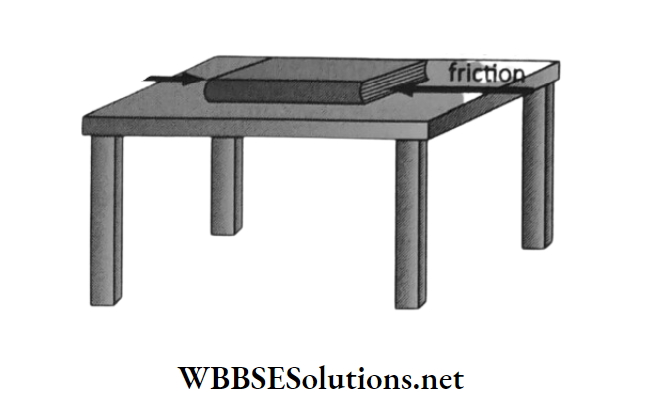
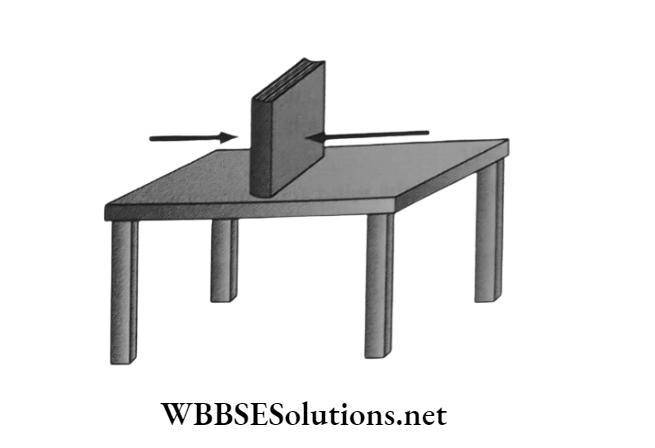
Chapter 6 Primary Concept Of Force And Energy Causes Of Friction
The cause of friction is the roughness of the surfaces in contact. A surface is rough means there are irregular small projections (hills and dells) on the surface.
When one body is resting on another there is interlocking between these projections. So to move the body, it must be dislodged continuously from those interlockings.
An additional force is necessary. Hence we feel the friction.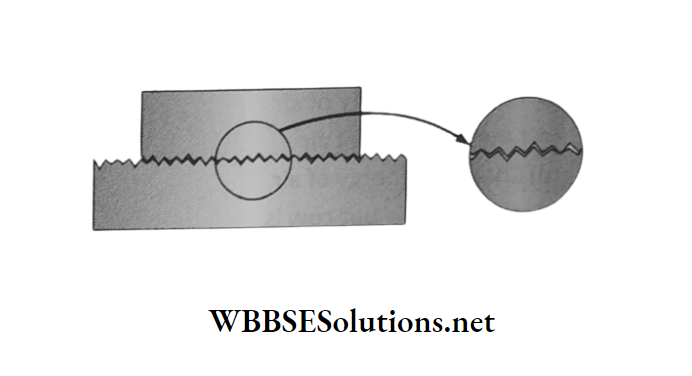
Advantages And Disadvantages Of Friction Advantages Of Friction:
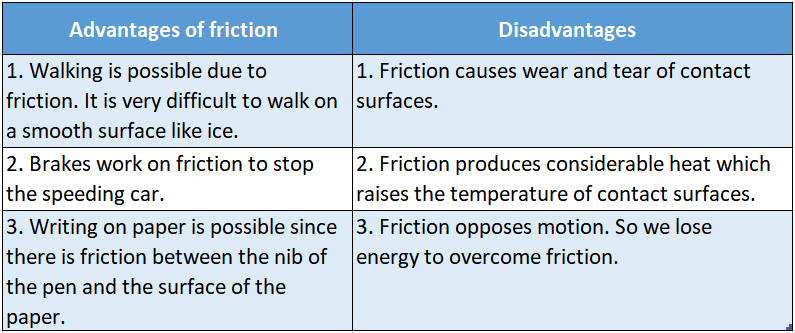
WBBSE Notes For Class 6 School Science Chapter 5 Measurement
Chapter 5 Measurement Necessity Of Measurement In Our Daily Life & Units Of Measurement
Think of the following very common situations in your day-to-day life. Let us suppose that you have come to a store to buy a new dress material for you.
After making the perfect choice for yourself the next thing that you need to do is to decide how much cloth do you require to buy for your dress.
Again suppose, for the time being, that you are ill and you need to take your medicine. You would definitely appreciate the fact that you have to take it in the proper amount.
If you take too little or too much then you are not going to get the proper benefit out of it.
Coming to a different issue-have you ever thought about how often and why do you glance at your watch or the wall clock in your home each day?
Read And Learn More: WBBSE Notes For Class 6 School Science
All the above issues relate to measurements. We all make measurements every day of our lives.
Measurement has been important ever since man settled from his nomadic lifestyle and started making houses, occupying land and trading with his neighbours.
As society has become more and more advanced, we have either consciously or unconsciously become habituated to carrying out measurements in our daily life or have become surrounded by the outputs of various measuring devices which make our life simple.
Before going in for the definition of measurement, let us pay our attention to the simple facts again as discussed above.
Suppose that you have bought 2 metres of cloth for your 80 dress material and that a pill or medicine contains 200 milligrams of chemicals.
Again, say, you saw that it was 6 PM in the evening when you started studying and 10 PM at night when you finished it off. That means you have studied for 4 hours in the evening.
Thus, Measurement is the comparison or estimation of an unknown quantity with a known standard quantity (constant quantity) or unit of the same type.
It is expressed as the multiple of a real number and a unit, where the real number is the comparison expressed as a ratio.
An example may be 2 metres of cloth, which is an estimate or comparison of an object’s (here it is cloth) length relative to a standard unit of length, one metre.
Moreover, in the example, 2 is the magnitude of length and ‘metre’ is the standard unit of the physical quantity (here it is long).
Thus in order to express the result of measurement, we should know:
- The unit in which a quantity is to be measured.
- The numerical value expresses how many times a standard quantity or unit is contained in a given physical quantity.
Importance Of Measurement
- Unless we are able to measure some phenomena, we cannot say that we scientifically know anything about that thing. Hence measurement is the key to scientific understanding and analysis.
- Measurement gives a base to understand the universe. All around us, we are surrounded by various things. We might not note it but unconsciously we are actually measuring things to comprehend them in one way or the other.
Chapter 5 Measurement Physical Quantity
Anything that can be measured is called a physical quantity. For example, the length and breadth of a classroom can be measured.
How At this point you would be able to appreciate the fact that how the world would be without being able to measure anything.
It is a fact that we are surrounded by Measurement. measure these quantities. To express a physical quantity, we associated a magnitude with it.
The number of times a standard quantity is present in a given physical quantity is called the magnitude of a physical quantity. Thus, physical quantity = (magnitude) x (unit).
much milk a glass can contain or the volume of milk in a glass can be measured.
So length, breadth, volume, time, mass, etc. are all physical quantities. We need certain instruments to
Chapter 5 Measurement Fundamental And Derived Physical Quantity
From the point of view of measurements, physical quantities are of two types- Fundamental and Derived physical quantities.
There are some physical quantities which do not depend on other physical quantities, e.g. length, mass, time, etc. These physical quantities are called Fundamental Physical Quantities.
However, consider the following physical quantities and the associated formulae to measure them-
Area of rectangle = length x breadth Volume of rectangular box = length x breadth x height Velocity = distance travelled/time taken Density = mass/volume.
It is clear that above mentioned physical quantities have more than one fundamental physical quantity associated with them. Thus we get the idea of Derived Physical Quantities.
There are some physical quantities which are made of more than one fundamental physical quantity, e.g. area, volume, velocity, density, etc.
These physical quantities are called Derived Physical Quantities.
While measuring any physical quantity it is expressed as a multiple of a standard quantity which is contained in the given physical quantity. This standard is called a Unit.
Fundamental Unit The units associated with the fundamental physical quantities are called Fundamental units. These are independent of any other units.
Chapter 5 Measurement Units Of Measurement
From time immemorial, man has been facing the necessity of measuring various quantities. For measuring mass, he used various kinds of standards.
For measuring length, he used foot length or arm length, etc. However, parts of the human body differ in length for different people. This led to a lot of confusion.
Gradually with the passage of time, people accepted certain rules of measurement. It became clear that for accurate measurement of any physical quantity, a unit was necessary.
Without a unit, any measurement is meaningless. Recall from the earlier discussion that we expressed a physical quantity as physical quantity (magnitude) x (unit).
For example, let the length of a book be 20 centimetres. It bears a clear meaning. It means that the said length is 20 (magnitude) times a centimetre (unit).
On the contrary, if it is said that the length is 20, it does not carry any sense.
The following are the fundamental units:
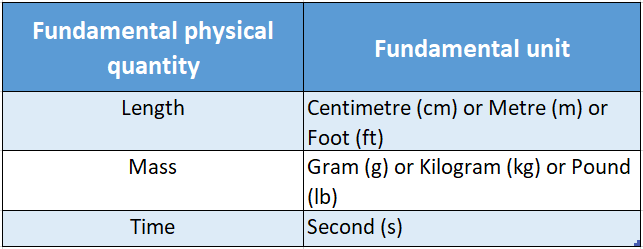
Derived Unit:
The units associated with the derived physical quantities are called Derived units. These are obtained by the combination of one or more fundamental units.
The following are a few examples of Derived units that show how they can be obtained from fundamental units of mass, length and time:
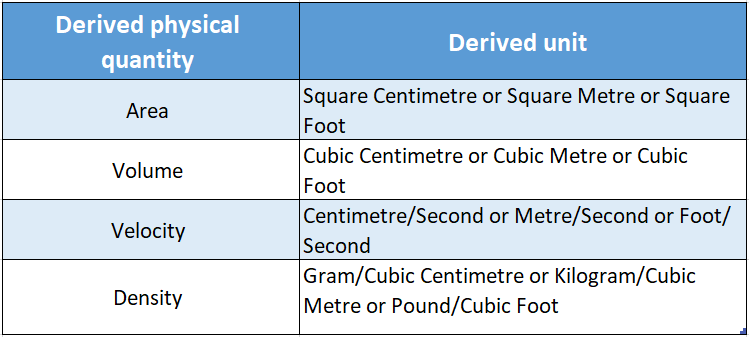
System of Units:
The fundamental units of length, mass and time taken together form a system of units. For measuring various physical quantities following systems are commonly adopted:
CGS system:
In this system, C stands for centimetre (length), G stands for gram (mass) and S stands for second (time).
MKS system:
In this system, M stands for the metre (length), K stands for kilogram (mass) and
S stands for second (time).
Fps System:
In this system, F stands for foot (length), P stands for pound (mass) and 5 stands for second (time).
Si Or International System: In this system, the units for length, mass and time are the same as that of the MKS system.
Nowadays, only the Sl system is in practice. It is an enlarged system encompassing seven elementary units as shown below:
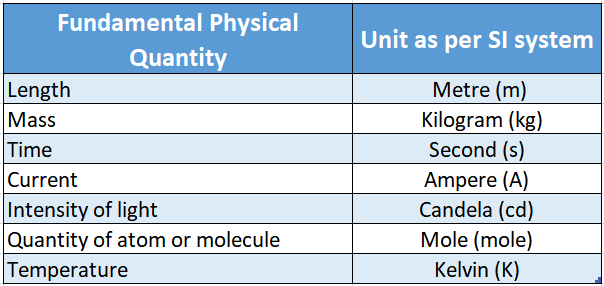
Physical quantities having the same unit:
More than one physical quantity may have the same unit. For example, work and energy are both expressed in Joule.
Physical quantities having no unit:
There are certain physical quantities which are expressed as ratios of two similar physical quantities.
Hence, they have no unit or are unitless physical quantities, e.g. specific gravity (ratio of density), specific heat (ratio of heat), atomic weight (ratio of mass) etc.
Chapter 5 Measurement Measurement Of Length, Area, Volume, Mass And Time Measurement Of Length
For the measurement of length, a fundamental physical quantity, only length is required and involves no other physical quantities.
One of the oldest units of length measurement used in the ancient world was the ‘cubit’ which was the length of the arm from the tip of the finger to the elbow.
This could then be subdivided into shorter units like the foot, hand or finger, added together to make longer units like the stride.
The cubit could vary considerably due to the different sizes of people. Hence, with the
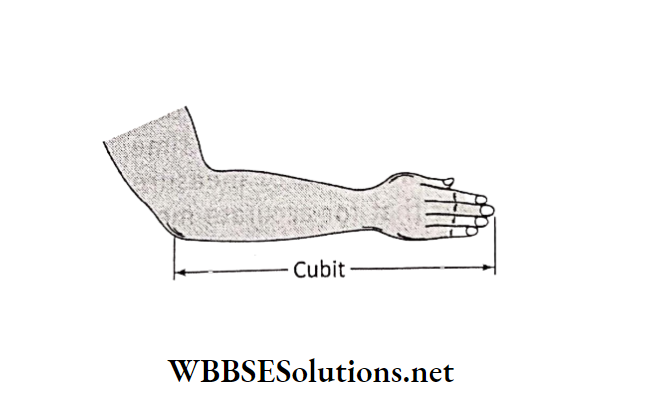
progress of science there was a need for the introduction of standard units to eliminate confusion arising out of the non-standard units of measurement.
The first serious attempt to standardize the unit was made in 1889 in Paris. However, some anomalies were left. In October 1960, another conference was held and the standard units were revised.
Brief characteristics of a standard unit:
- It should be of a convenient size to use.
- It should not change under any circumstances related to space and time.
- It should be possible to be defined without any doubt.
‘Metre’ was chosen to be the unit as per the Sl system of Units or International System of Units for length measurement. In 1791, the Paris Academy of Science defined Metre as under-
One ten-millionth part of the distance from the pole to the equator of the earth is called a metre.
This distance is marked between two parallel lines drawn on a platinum-iridium bar.
This bar is kept at a constant temperature of zero degree centigrade in the International Bureau of Weights and Measures at Sevres near Paris. All replicas of the metre are compared with the standard metre described above.
In 1960, a refinement in the definition of metre was made and it was related to an atomic constant which does not change with time.
Multiples and sub-multiples of Metre :
Not all the lengths to be measured are the same. For instance, we may have to measure the distance from Kolkata to Delhi.
Using metres as the unit, the said distance comes out to be 1305000 metres. Again, say, we need to measure the diameter of a thin wire.
This may be 0.001 metres (say). You find that in both cases using metre is not so convenient. The former one is too large a length and the latter one is too small a length to be measured with a metre as a unit.
Thus there is a need for greater as well as smaller units of length apart from the standard metre.
We can obtain greater units in the SI system by multiplying Metre by 10. These are called Multiple units. Multiples of Metre
Chapter 5 Measurement Measurement Of Area
The area of an object is the quantity that expresses the extent of its shape in a plane. To measure area, we need to measure the length and breadth of the shape or the place with a scale and then have to apply the following formula: Area = length x breadth.
- decametre (dam) = 10 m
- hectometre (hm) = 100 m
- kilometre (km) = 1000 m
Using suitable multiples of metres the expression of longer lengths becomes convenient. Thus the distance from Kolkata to Delhi becomes 1305 km using multiples.
It is interesting to note that to measure very large distances such as those encountered in the solar system or between galaxies, units like the Astronomical unit (AU), Light Year and Parsec are used by scientists.
Parsec is the biggest unit of length. We can obtain smaller units in the Sl system by dividing Metre by 10. These are called sub-multiple units. Sub-multiples of Metre :
- decimetre (dm) = 1/10 m = 10 cm
- centimetre (cm) = 1/100 m = 1 cm
- millimetre (mm) = 1/1000 m = 0.1 cm
Using suitable sub-multiples of metre the expression of smaller lengths becomes convenient. Thus the diameter of the thin wire becomes 1 mm using sub-multiples.
For measurement of very small length, still, smaller sub-multiple like Micron (u), Angstrom (A), Fermi etc. are used.
Note that in the Sl system, each unit is 10 times of its previous unit and 1/10th of its later unit.
This has a tremendous advantage in simplifying computations and conversion of units among multiples and sub-multiples.
Measuring instruments ordinary objects like a glass rod, a piece of cloth etc. are measured directly by comparing them with a scale.
The scale may have different lengths (15 cm, 30 cm, 50 cm, etc.) according to our needs. If the length of the scale is one metre it is called a metre scale. The smallest division of such a scale is 1 mm.

Let us see the application of the above formula to measure the area of a book. The book may be placed on a table and lines are drawn along all sides with a chalk.
After removing the book from the table, the impression made by the chalk mark gives the desired measurement of the length and breadth of the book. Thus the area can be found using the above formula.
For an object shaped like a sphere, cone or cylinder the area of its boundary surface is called the surface area of the object. Let us see how the surface area of a football can be measured.
It is shaped like a sphere. In order to measure the surface area of the ball, its diameter has to be measured first. Two books may be placed on a plane surface touching both sides of the ball.
The distance between the books as measured by a scale gives the diameter of the ball.
Now the surface area of a sphere can be obtained using the following formula Surface area = x diameter x diameter, where π (pronounced as pi) is a number, the value being 3.14.
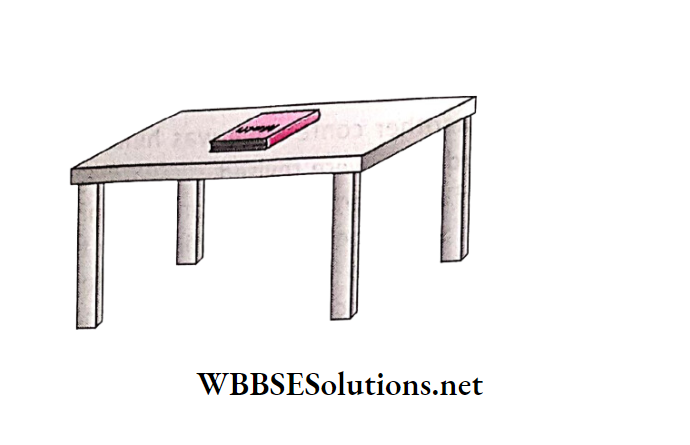
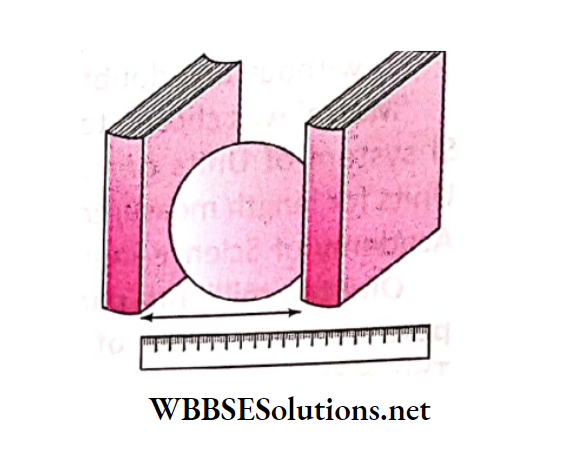
Chapter 5 MeasurementMeasurement Of Volume
Any and every object occupies some space. The space an object occupies is called its volume. Volume is a derived physical quantity. The SI unit of volume is Cubic Metre.
Another unit of volume is the Cubic Centimetre (cc). The volume of liquid is usually expressed in litres (L).
Measuring instrument: A measuring cylinder is employed to measure the volume of a liquid. It is made of glass or some transparent material with a graduation mark or scale (in mL or cc) on its exterior surface along the length.
The range of the measuring cylinder is usually 1 cc to 100 cc. Let us see how we can measure the volume of a certain liquid with it.
A dry measuring cylinder has to be kept in an upright position on the table and the liquid (whose volume is to be measured) shall have to be poured completely into the cylinder.
The liquid will take some time to settle down. When the liquid comes to rest, the graduation mark of the measuring cylinder where the uppermost surface of the liquid touches is to be carefully noted.
This gives directly the measurement of the volume of the liquid.
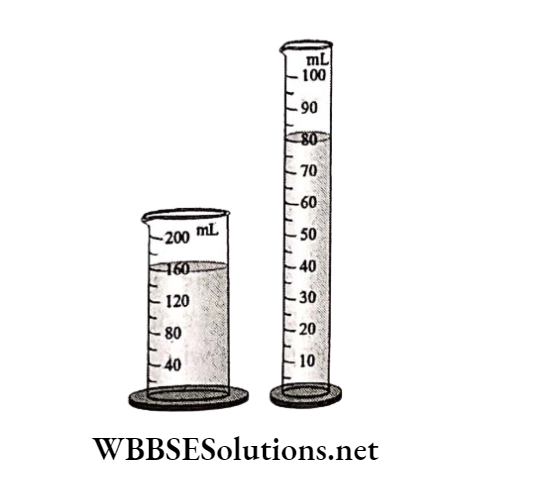
It is to be noted that a measuring cylinder may also be employed to measure the volume of an irregularly shaped solid body, e.g. stone, wooden block, etc.
Since a solid body, when completely immersed in a certain liquid, shall displace a volume of the liquid which is the same as the volume of the solid body itself, so we can measure its volume with the help of the measuring cylinder and a liquid.
Chapter 5 Measurement Measurement Of Mass
The mass of an object is the amount of matter contained in it. It is a fundamental physical quantity.
The SI unit of mass is the kilogram (kg), defined in terms of the mass of a cylinder made of platinum-iridium, the prototype of which is kept at the International Bureau of Weights and Measures at Sevres near Paris.
The CGS unit of mass is gram (g).
Measuring instrument:
A common balance is employed to measure the mass of an object with respect to some known standard mass. The standard masses (or weights) are kept in a weight box.
The substance of unknown mass is to be kept on the left scale pan of the common balance and the standard known masses in the right scale pan.
When the pointer comes to equilibrium, the mass of the substance is measured as equal to the known standard masses.

Chapter 5 Measurement Measurement Of Time
You have noticed that there is always an interval between your starting from home and reaching the school after going through the road in the desired direction.
This interval cannot be seen but can be felt. Sometimes the interval increases due to traffic jams and on a few occasions, you reach school early than normal.
This interval is called time. Thus, the interval between any two incidents is called time.
Units of time:
Mean Solar Day:
The average of the varying solar days over a period of 365 days is called the mean solar day. Hour: 1/24th part of the mean solar day is called an hour.
Minute:
The 1/60th part of an hour is called a minute.
Second:
The 1/60th part of a minute is called a second.
Mean Solar Day = 24 hours = 24 x 60 minutes = 1440 minutes = 1440 x 60 seconds = 86400 seconds
Measuring instrument:
A clock or a watch is an instrument used to measure time. It has two hands-one short and one long. Rotation of the long hand between two small marks indicates one minute.
The shorthand shifts one mark indicating one hour. The shorthand completes one total rotation in 12 hours. The use of digital clocks is prevalent nowadays.
It has no hands and shows digits on the screen. It can measure time very precisely. It can even measure time up to 0.01 seconds.
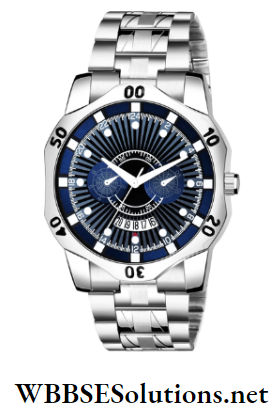

A stopwatch is used to note the time of an event of short duration. It can record 1/5th or even 1/10th of a second.
The longer hand records time in seconds with fractions and the shorter one in minutes. There is a press button which, when pressed, starts the watch and if pressed for the second time, stops the watch.
If again the button is pressed, the second and the minute hands return to their own zero mark.
Thus this watch can be started or stopped by pressing its press button just at the beginning and at the end of an event like a race in sports.
The newest and the most accurate model of the timekeeper is the atomic clock that gains or loses only a second in about 1000 years.
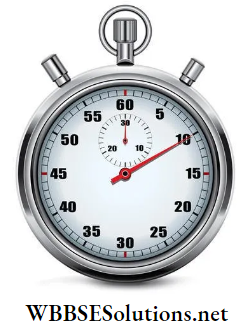
Chapter 5 Measurement Importance Of Estimation In Measurement
Learning how to estimate is a valuable skill. Estimating helps you plan ahead and check your work to see if your answer makes sense.
In our daily life, anybody can be caught in situations when he or she does not have a calculator or other instrument available but needs to make decisions quickly.
He or she can use his or her ability to estimate to get a close answer so that the work can be continued.
Later on, the estimate can be checked back using a calculator or other precise instrument if somebody wishes to do so. Let us discuss some practical situations taken from our daily lives to get the matter clarified.
If you have to be at school at 9 AM sharp, what time do you have to leave in the morning from your home? Often we do not have the exact answer but we need to make an estimation of time which is essentially a guess of measurement.
You have a sense of capacity or volume. Without a clear concept of capacity, you might find yourself pouring an entire half-litre of orange juice into a small glass.
If somebody is unwell, then simply by touching his forehead one can sense whether he has developed a fever or not.
Estimation of body temperature is critical in this regard or else you may land up with wrong conclusions. After some time a thermometer may be used to measure the exact temperature of the body to get a clear picture.
These are simple acts of estimation which is a skill that we all need to practise.
Thus, estimation is the process of finding an estimate or approximation, which is a value that is usable for some purpose even if input data may be incomplete, uncertain or unstable.
The value is nonetheless useful because it is derived from the best information available as per the prevailing circumstances.
The purpose of estimation may be summarized as follows:
1. Estimation helps to plan ahead and check the work to see if an answer makes sense.
2. It provides a rough check of more exact calculations or research results or hypotheses.
3. It helps to obtain approximate knowledge about the quantities when other resources are not available.
4. It helps to obtain approximate knowledge about the quantities that are difficult to measure precisely.
An estimate that turns out to be incorrect will be an overestimate if the estimate exceeds the actual result and an underestimate if the estimate falls short of the actual result.
An informal estimate when little information is available is called a guesstimate because of the inquiry. becomes closer to purely guessing the answer.
Last but not least, though we are forced to do estimation on
quite a few occasions yet it must be remembered that precise measurement is of utmost importance in our life.
Chapter 5 Measurement Measurement Of Plant And Animal Growth
Growth is one of the fundamental features of living organisms. Non-living objects like rocks or crystals may also grow by deposition of new materials, but growth in living things is something distinctly different.
It is a complex phenomenon whereby an increase in size occurs and new tissues are formed. Growth may be
Chapter 5 Measurement Measurement Of Plant Growth
defined as a permanent increase in mass or volume, accompanied by an irreversible change of form or structure. Usually, growth is attended by an increase in weight.
But in germinating seeds or sprouting potato tuber there is a loss of weight during growth, obviously due to utilization of stored food matters.
The rate of growth is imperceptibly slow in plants and so can be hardly detected and measured without the help of a suitable instrument.
Certain plant parts like tendrils of Cucurbit and shoots of bamboo, however, exhibit rapid growth.
Auxanometer is a common instrument used for measuring growth by which the actual growth in length may be magnified many times and conveniently recorded.
A lever auxanometer or arc indicator has a pointer fixed to a wheel and a graduated arc. In a sophisticated auxanometer, the scale is graduated in micrometres.
A cord attached to the growing tip of a potted plant is passed over the wheel and allowed to remain suspended at the other end by a weight.
With the growth of the tip, the indicator moves and the increase is recorded on the graduated arc on a magnified scale. From the record thus obtained the actual increase may be calculated.
If there is a provision to record the time required for this growth, then the rate of plant growth can be measured. The rate of plant’s growth (Measured Growth)/(Recorded Time).
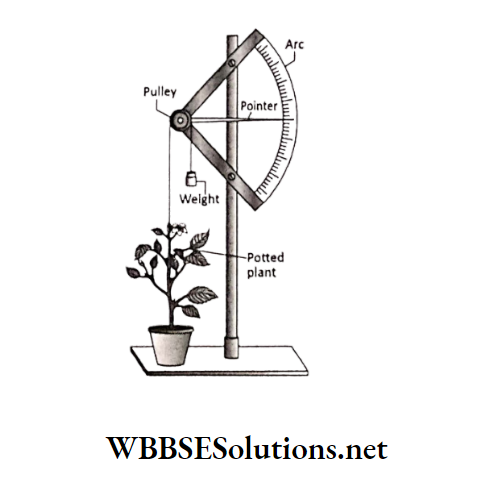
Chapter 5 Measurement Measurement Of Animal Growth
In the case of animals, growth takes place in all parts at a time. However, the rate of growth varies from head to appendages to trunk. Growth never takes place throughout life.
At a certain period, growth stops forever. The instrument and the process to measure the rate of growth are the same for all animals including human beings.
Height is measured on Centimetre Scale. A person has to stand straight in it so that his head touches the indicator fitted to the scale. The reading indicates the height of the person.
Periodic measurements of this kind help to determine the rate of growth of a person.
